
Best Marine Air Conditioners

Last Updated by
Daniel Wade
May 2, 2023
Key Takeaways
- The best marine air conditioner will vary based on key factors specific to your needs
- Webasto, MarinAire, and Flagship are some of the most recognizable air conditioners
- Most marine air conditioners are affordable and made with quality parts
- Consider choosing a cooling system based on the size of your boat
- Marine air conditioners will likely last up to 20 years with preventative maintenance
A good quality marine air conditioner inside a boat comes in handy on a hot day. But what qualifies one as the best marine air conditioner?
The best marine air conditioner could be argued for brands such as Webasto, MarinAire, Dometic, and Campelify. The best marine air conditioning systems all rely on factors for the size of the boat, how easy it is to install, and the budget in order to be considered the best.
Drawing from personal experience, the best marine air conditioner is one that can hold up well to the marine environment at a good price. You should also aim for air conditioning systems that do not require a lot of assistance installing if you are by yourself or have never installed one.
Table of contents

Nine of the Best Marine Air Conditioner Units
Hot weather in the summer is a great time for sailing but can be uncomfortable and even dangerous. Investing in marine air conditioners can make your sailing experience more enjoyable and prevent heat-related illnesses.
You and your passengers can stay cool and comfortable during hot weather especially in the summer with a functional air conditioner on board. Choosing the best marine air conditioner can be challenging due to the numerous options available.
MarinAire 16,000 BTU

Equipped with pressure gauges and a sound cover this unit boasts a stainless steel drain pan, D- Smart control system, a low startup current, and a compact design suitable for small spaces. While unsuitable for household installation, its standout features include a 60% noise reduction and 360-degree blower outlet to help make it a smart investment.
- It has a D-Smart control system that protects from damage and detects humidity
- Rotating 360-degree blower outlet
- Includes sound cover
- Short power cord
- The electrical box can be intimidating if needing to work on
Webasto 10,000 BTU

Webasto's platinum series features a self-contained marine air conditioner with a 10,000 BTU cooling output with a robust design, is quiet, and has a reverse-cycle heat. This unit is great for new installations or as a system replacement and upgrade and includes a compressor compartment, condenser, evaporator, remote thermostat, and controller, as well as velocity blowers for superior cooling. Its programmable thermostat, low maintenance, fuel efficiency, and easy installation make it one of the top marine air conditioners available.
- Respectable cooling results with low maintenance
- More affordable compared to other models with the same output
- Quieter when operating than other models
- The square fit might be difficult to retrofit on some boats
CAMPELIFY Portable Air Conditioner Unit

This is a top rated portable marine AC unit with mild cooling and is ideal for boats and campers. It uses vapor compression, 134A refrigerant, and a micro-channel condenser for compact design.
It also features a DC rotary compressor for high performance and vibration cushioning. It can be powered by a grid or battery for spot cooling in small spaces or larger rooms.
- Ideal as a small boat air conditioner
- Energy-efficient and can be used with solar power
- Easy to install and is cost-effective
- Not as efficient cooling larger rooms
Dometic Envirocomfort 16,000 BTU

The EnviroComfort Dometic marine AC retrofit kit is a cost-effective, eco-friendly option for mid-sized boats that provides year-round comfort with a climate control feature. User reports claim that it is easy to install, clean, and monitor. This Dometic marine air conditioner has an audible fan that may unintentionally switch modes during extreme temperature fluctuations.
- Best bang for your buck marine AC unit
- Simple to set up and has quality air output
- Energy efficient for mid-sized boats
- Can be pretty noisy compared to other models
Black+Decker Portable AC

The BLACK+DECKER portable air conditioner is a powerful and versatile unit with a 10,000 BTU ASHRAE exhaust system that is ideal for midsize cabins at sea. It has a corded electric power source, remote control, environment-friendly refrigerants, LED control panels, and a 24-hour timer with auto-control sleep mode.
You would likely need to use two units as a primary and secondary backup for larger boats during a more extended sailing trip. Maintenance is easy with reusable air filters, pressure gauges, air intake gaps, and an exhaust hose. You might need a sound cover to help reduce noise.
- Worth a shot as a backup marine air conditioner for larger boats
- Very affordable
- It can be quite noisy compared to other models
- Somewhat bulky and can take up a lot of space if you buy more than one
ASA Electronics ACM135 Advent Air

ASA's AC model for sailboats is ideal for non-ducted setups with 13500 BTU cooling and eco-friendly features. Its robust build minimizes vibrations, has three fan speeds, and connects to a standard 14.25 opening.
It requires professional installation for this self-contained unit that has refrigerant. There are six foam pads that line the watertight vent opening and it has filters that you can wash to help ensure clean air. Saltwater may corrode the stainless steel drain pan faster and there is no warranty without professional installation.
- Three fan speeds for various air output
- It has a removable air filter
- Can add a heat strip for warm air
- No pressure gauge
- Need a professional to install
- Warranty in question

Miami's CTM Marine created a powerful marine air conditioner that is resistant to corrosion and compatible with other major brands. These units are energy-efficient, eco-friendly, and quiet.
Depending on your cooling needs they can range from 6,000 to 72,000 BTUs and are compact. They also come with a two-year warranty and offer excellent as a top marine air conditioner choice in the market.
- Competitive price compared to other marine air conditioner brands in the market
- Quality materials meant to last in marine environments
- It has a warranty for two years
- Control is sold separately
- The blower is not able to turn past 170 degrees
- Have to buy from an authorized dealer
Flagship FM16H

Flagship Marine's FM series air conditioners are praised by boaters for their robustness and potency. Their units are renowned for their durability and are used on US Coast Guard and Navy vessels. These models have also lasted over 20 years for recreational boaters.
They operate quietly, utilizing isolator bushings, have insulated blower chambers, and use LG Rotary Compressors. Their low noise level enables them to be installed even beneath bunks. FM units also feature a smooth startup and low surge as well as dry drain pans that protect against condensation and corrosion.
- Uses relays instead of circuit boards
- Has a warranty on parts for five years and one year on labor
- Constructed in the US
- Does not have a variable speed
- Unit has to be shipped off if problems cannot be fixed over the phone
- Warranty can be strict in certain situations
Mermaid M16

Mermaid boasts a proficient crew and backs their products that include the M16 flagship model. This 16,500 BTU AC cools or heats boats to roughly 1,400 cubic feet with superior US-made parts and is perfect for larger boats.
They craft with high-grade components on sturdy stainless steel bases. It is also customizable with several different air discharge options.
- It has a five year warranty on craftsmanship and materials
- Easy to make repairs and install
- Outstanding customer service where people talk to you that have built them
- Unit has to be shipped to them if any major issues
- Might have some minor noise issues
How to Find the Best Marine Air Conditioners
Choosing the best marine air conditioner can be a challenging task for some boat owners. You would need to understand a variety of factors before jumping into a purchase for one.
It is best to conduct all the research you can when considering a marine air conditioning. Choosing the right boat AC unit requires careful planning and significant investment.
How Big is Your Boat?
Selecting an optimal marine air conditioner requires measuring the cooling area and factoring in the following:
- Adequate insulation
- How much sunlight exposure
- Number of windows
- Size of your boat
Consider choosing a higher capacity unit or several smaller units for larger boats. Confirm that there is adequate space near the engine for the condenser when choosing a split system.
Important Details of the Marine Air Conditioner
Marine air conditioners come in a variety of intended uses and price ranges. However, there is more to look into than just that. Consider the type of unit you choose based on:
- How much space it requires
- Ease of mounting and its location
- Research power requirements in case you need extra power
- Evaluate the impact on vessel performance from added weight
- Understand British Thermal Units (BTUs) and how they apply to output
Other factors will likely affect your decision to buy a certain model. You need to consider the noise level if you are a light sleeper in order to avoid sleep disturbances.
Some marine air conditioners are easy to install and you can do them yourself. However, some require proper installation for efficient refrigeration, return air flow, to allow for maintenance, and ducting or discharge options.
Budget and What it Costs to Maintain Marine AC Units
Only you know exactly what you can and cannot afford. Budgets are crucial in determining which AC units appeal to you.
Maintenance requirements should also not be overlooked. Complex systems might require more money to fix than standard AC units. However, most marine AC systems will have a customer support line to help fix any issues.
Some marine AC units have warranties on parts, labor, materials, or a combination of a few. You will need to verify warranty coverage for your chosen marine AC unit to ensure customer protection for potential defects, parts that need to be replaced, and urgent issue resolutions.
You should make sure to follow exactly what it explains so that you do not void your marine air conditioner warranty. This means properly following a schedule of routine maintenance and other rules for repairs.
Benefits of a Marine AC Unit
Adding an AC unit to your boat offers more than just cooling benefits on a hot day at sea. You will discover many advantageous features that make them more valuable than just that.
You can likely still find sailors that do not use an air conditioner on their boat. But there are plenty of positives to consider adding one to your vessel.
Fights off Mold
Air conditioners aid in preventing the growth of mold by promoting proper air circulation. This keeps boats free from mold and its associated foul odor caused by high heat and humidity.
Mold infestations can be challenging to eliminate once established. Installing an air conditioner will help keep you proactive of a mold situation.
Staying Cool
The main point for AC units is to help cool the boat cabin or intended room. You can escape the heat while sailing with an air conditioner on board your boat. This will also make your boat more appealing to be on as you explore the waters with your companions.
This feature maintains vessel coolness during rain in wet and humid regions. That allows for drying and cooling without opening windows. The air conditioner manages climate control and eliminates the need to expose the interior to rain and air.
Can Potentially Use as a Heater
Some marine air conditioner units double as heaters in winter. That alone could be worth the extra investment since you would not need to find a separate heating system like a diesel stove.
If you are able to use your air conditioner as a heater then it will allow you to save space. Some units are only for cool air so you would need another unit simply for heating and that will take up more space.
Helps Dehumidify Vessel
Marine air conditioners on boats help the cooling process but also dehumidification and heat through reverse cycle. Boats that are dry during storms or when it is insanely humid increase comfort and reduce corrosion for onboard systems.
Varieties of Marine Air Conditioners
Prioritize researching available marine AC systems and their suitability for your vessel's size and needs before making any extravagant purchases. Choosing the wrong unit can result in inefficiency, battery drainage, and inadequate cooling.
Self-Contained Units
These compact systems can be fixed onto a single chassis and make them suitable for cooling vessels between 25 and 40 feet. They can be installed in various locations, such as the living area, near the waterline, under a settee or bunk, and require thru-hull connections for efficient water absorption.
Hatch-mounted Units
Compact vessels like small motorboats and daysailers are ideal for using such systems and are popular due to their portability. However, they can be bulky and require two people to move. It is important to note that portable AC units for boats may not be effective in cooling larger cabins.
Chilled Water Units
These systems consist of a chiller in the engine room that cools freshwater. Units like this are ideal for cooling multiple cabins on super yachts and larger vessels.
The water is then circulated through a pipe loop to air handlers installed in the fore room. Despite their high energy requirements these AC units are an efficient option to consider.
Split-air Units
Boats up to 80 feet benefit from central or split air conditioning with a condensing unit housing the seawater condenser, compressor, and electrical parts. The evaporating unit, consisting of a blower and evaporator coil, is installed in living spaces. Insulated copper tubing connects the two units for refrigerant flow.
How You Can Install a Marine Air Conditioner
Installing an air conditioning unit on your boat can be hassle-free if you follow the manufacturer's instructions. Make sure to have the necessary thru-hulls and tools before installation. You can also watch instructional videos for your specific model or seek professional help for complex installations.
Placement is crucial and should be in a well-ventilated and dry area and away from flammable sources. If you do not have enough space then consider making some modifications. Follow the manufacturer's recommended installation instructions for best results.
If you find the installation process daunting then it is best to seek out professional assistance. In doing so make sure to pay close attention to the procedure and learn how to troubleshoot common issues. Being knowledgeable about your AC unit will help you keep it functioning efficiently.
How to Take Care of Marine Air Conditioners
To help optimize your marine AC unit's performance you can do simple tasks such as consult the manual and clean the rear filter. Further proper cleaning instructions can be found in the manual that might be necessary.
Most marine air conditioner units need the sea strainer cleaned for sufficient water supply. You should also check raw water discharge for proper operation.
Maintenance conducted by a trained professional is recommended every few years to prevent clogging. Extending the unit's lifespan up to 20 years is as simple as properly maintain your marine air conditioner.
Related Articles
I've personally had thousands of questions about sailing and sailboats over the years. As I learn and experience sailing, and the community, I share the answers that work and make sense to me, here on Life of Sailing.
by this author
Most Recent
Important Legal Info
Lifeofsailing.com is a participant in the Amazon Services LLC Associates Program, an affiliate advertising program designed to provide a means for sites to earn advertising fees by advertising and linking to Amazon. This site also participates in other affiliate programs and is compensated for referring traffic and business to these companies.
Similar Posts
Popular posts.

Best Liveaboard Catamaran Sailboats
December 28, 2023

Can a Novice Sail Around the World?
Elizabeth O'Malley
June 15, 2022

4 Best Electric Outboard Motors

How Long Did It Take The Vikings To Sail To England?

10 Best Sailboat Brands (And Why)
December 20, 2023

7 Best Places To Liveaboard A Sailboat
Get the best sailing content.
Top Rated Posts
Lifeofsailing.com is a participant in the Amazon Services LLC Associates Program, an affiliate advertising program designed to provide a means for sites to earn advertising fees by advertising and linking to Amazon. This site also participates in other affiliate programs and is compensated for referring traffic and business to these companies. (866) 342-SAIL
© 2024 Life of Sailing Email: [email protected] Address: 11816 Inwood Rd #3024 Dallas, TX 75244 Disclaimer Privacy Policy

Air Conditioning on A Sailboat? Yes, and It’s Lithium Powered too!
Air Conditioning on a sailboat is a luxury. Especially when we’re at anchor and running everything off solar and battery power. So, naturally, we get asked about keeping cool on the hook…a lot.
In our last video about sailing with family, I asked Jason’s sister Lauren “ how was it coming from a typical house to sleeping in a boat with no air conditioning ?”. This question caused a ton of confusing comments on why we didn’t run our A/C for the family. Fair enough.
The short answer is, we did run the A/C for short stints, but not overnight. The complete answer to that question is hashed out in the video below. So….click that play button!
Kinda cool right?! Ok, now about those details.
Here’s a quick recap of what we covered in the video:
- Why didn’t you run the A/C? We did in the afternoons when the sun was high (and our solar panels were bringing in lots o’ power to the batteries). It was the hottest part of the day and it’s o-so-nice to circulate air and bring down humidity.
- Why not run the A/C overnight? We don’t have enough battery power to run the A/C all night and keep up with all the other power demands of the boat. (It’s a challenge to manage resources with 5 additional people who are not accustomed to living with limited resources).
- Why not run the generator? 10 hours of generator uses about 5 gallons of fuel. That fuel consumption adds up fast and requires us to service the generator more often. Not to mention there were no fuel stations where we were anchored. Conserving fuel, parts and our limited resources is important while living off the grid, especially in remote places.
- How do we run the A/C off our batteries? The short answer is, we installed an Easy Start.
How We Run Our Sailboats Air Conditioning off Battery Power
If you want to run the A/C while you’re living off the grid and on the hook, there are a few things to consider:
- More on lithium batteries: gonewiththewynns.com/sailboat-tech-why-lithium-batteries
- Lithium Battery Discount! Relion is offering 5% off to all GWTW Fans! Just click the link and it will be automatically applied at checkout. http://bit.ly/RelionLithium
- More on our solar set up here: gonewiththewynns.com/living-off-grid-rv-sailboat
- More on our inverter here: gonewiththewynns.com/charge-boat-batteries
For reference here are a few common inverters and their claimed peak amps:
- GoPower! IC2000 – 60 amps
- Magnum MS2012 – 50 amps
- Xantrex PROsine 1800 – 45 amps
We’re not reinventing the wheel. This type of power surge is a common problem with all different types of compressors and pumps. That’s how we found the Easy Start . The RV air conditioner manufacturer told us it was the solution to our “surge” issue. The Easy Start is a device that gets attached to the A/C and reduces the surge of power (as you saw in the video). An Easy Start can be used to run an Air Conditioner (or other compressor or pump) off a small generator (like the Honda 2000), low quality (or low amperage) shore power, or through an inverter for off-grid solutions (like tiny homes, RVs and boats).
When we were outfitting Curiosity we knew we wanted to install the Easy Start on our A/C units. It’s been almost 2 years now and we haven’t had any issues on or off the hook. Ok, maybe one issue: Jason dreams of adding even more battery power (keep dreaming honey).
But, in all honesty, we don’t run the A/C that often. When we do, we throw on a scarf and pretend we’re on one of those fancy superyachts. But mainly, it’s to take the edge off of the peak heat of the day and help control the humidity (aka, the mold).
Discount Code For You!
This is NOT a paid plug or sponsored video. Easy Start didn’t ask us to create any of this, we asked Matteo for his help. Not only did he help us out, but he was also able to score you a discount. And, as the cherry on top, we get a couple of bucks too as a referral. It’s a win-wynn! Thanks, Matteo!
- $25 off discount code: GWTW
- Where to purchase: http://bit.ly/easy-start-ac
If you have any questions at all leave a comment below and we’ll do our best to answer. If it’s a technical question we can’t answer, there’s a good chance Matteo will chime in.
How Long Can We Run The A/C Off Battery Power?
We ran a very quick test to give you some real use numbers as we were filming this video. This isn’t an in-depth test and it is always going to vary as weather conditions change. For example: How hot is it outside vs what temp we have the A/C set at. Is the compressor running the whole time or cycling on and off. How many other electronic devices are running…you get the point. All of this makes a huge difference in how long we can run the A/C.
- 9 AM – Turn A/C on, set for 77°. Outside it’s mostly cloudy and 80°. Batteries are at 67.6% (-388 AMP Hours Down)
- 12 PM – Turn A/C off. Outside it’s partly sunny and 83°. Batteries are at 50.7% (-589 AMP Hours Down)
- After 3 hours of running the A/C, we were down -201 AMP Hours
Important to note – We were not running the A/C hard and it was cycling on and off. Fans, refrigerators, freezers, and our computers were all running. This typically draws about 15-25 AMPs per hour. Our solar was bringing in some power (around 30-50 AMPs per hour). Putting all this together plus our past two years’ experience (especially on much hotter days), we are guessing on average the A/C pulls about 115 AMPs per hour.
The Big Takeaway – With our 1200 Amp hours of lithium battery power and 1400 watts of solar, we can easily run the A/C for a couple of hours in the early afternoon, and the solar power coming in will top our batteries back up before the sun goes down.
Gear Used In This Video
- Full Review Of All Our Camera Gear: gonewiththewynns.com/photo-video-gear
- All Things Off-Grid: gonewiththewynns.com/living-off-grid-rv-sailboat

Hello there! I honestly don’t know what to say, so I am going to tell you a bunch of random facts instead. I'm a fish eating vegetarian who hates spiders and loves snakes. I almost never took vacations growing up. I wanted to be Pippi Longstocking (still do). I misspell about every other word I write and still struggle with grammar. I love splurging on a good high tea (which is really hard to find these days). And whatever you do, don’t tell me I can’t do something, because then I'll HAVE to do it!
Comments (84)
There is a lot of info in here, but I can’t find if you used a AC or DC air conditioning unit? Thanks
Is anyone making a sailboat A/C that uses seawater to air cooling?
I’m getting close to getting an a/c unit for my 25’Chris craft. Getting new breaker panels first with a new wall to remove wholes on previous wall. I have 400ah lithium and about 700watts solar. I’m considering purchasing a DC air conditioner which costs about 3times more than an 120v a/c unit. Bit it will draw no more than 30amps on high power. I want it to feel like home! Love watching your show!
I’m not sure I understand the purpose of the Easy Start, is it needed just on initial start-up of the AirCon system, or each time the AirCon cycles onto ‘cooling’ rather than idle? One would mean peak amps drawn only once per day, the other would mean peak amps drawn many times per hour. Hmmm confused
Curious Minion
It’s needed every time the compressor kicks on. Curious Minion
George Spatoulas
You seem to have the same AC unit I have (Cruisair 16000 BTUs) I am trying to find the spechs what are your spechs ? Here is what I have found on Dometic.com website (they have re-branded their AC Units to be under their Dometic.com brand)
Dometic 16000BTU/hr 110v 60hz
Input voltage (AC) 115 V Input frequency 60 Hz Starting current – max 62.00 A Required AC circuit protection min 25.00 A Required AC circuit protection max 40.00 A
Refrigerant, type R410A Cooling Capacity 16000 Btu/h Current consumption min cooling 10.40 A Current consumption max cooling 10.40 A Current consumption min heating 13.60 A Current consumption max heating 13.60 A
I would appreciate if you tell me if your spech data are similar (or what they are)
Hey guys! Have you heard of a new line of boat AC that was just released? https://youtu.be/ZXEyAtxCjR0 … I thought it was pretty cool
Peanut Gallery
Have you considered a more active “systems” approach to managing the power and sensors on the boat?
For example, a microcontroller interfaced into the battery monitor, solar charger, generator, etc., could track and report usage from the various systems on the boat and automatically kick on the generator if certain criteria are met or if something falls outside of normalized trends for your boat. You could run the A/C all the time when you have land lubber guests it would only kick on the generator when the batteries drop below a pre-programmed threshold, and then shut off when they reach a reasonable charge, something that should only take an hour or so to do instead of running all night. Everything on a boat is about optimization, and that’s something tiny computers do very, very well.
The amount of functionality available on little microcontrollers these days is amazing. Add a cellular card to one and you could even set the boat up for text message alerts (or Telegram or whatever) when you are away for the day if she drags anchor, the bilge pumps kick on, the door or hatches open, or any other kind of thing that you think should be monitored.
rh hutchins
You guys make an old man really jealous! I enjoy your travels vicariously.
You’ve done a good job of explaining things and showing us your experiments leading to decision making. Parallel battery wiring and the EasyStart are just 2 examples. IIRC you stated that your electricity is 12VDC. Did you consider 24 VDC? If so, did you run tests? What were the results?
From watching the Whitakers on Sailing Zatara, I remember that their Privilege came wired for Europe (and other parts of the world) with 24 volt wiring. I remember that Keith explained why and mentioned that all their appliances were not set up with European plugs and power consumption specs, but I don’t remember that they converted to 12 VDC.
Enquiring (old) minds want to know.
It is 12v, mostly because there are lots of electronic gizmos that will charge directly on 12v with no need for a converter or inverter. You can set up a 24v solar system, but you need to somehow account for convertability to 12v for charging. Curious Minion
Okay, I am going to nitpick a little. Several times in the discussion and videos you use the term (units) of Amps per hour (Amps/hour). The quotient or ratio of Amps per hour (Amps/hour) is incorrect here and really does not have meaning (technically it does but I digress). I know others do it too and you have seen it written other places but it is wrong there too. What you mean to say or should say is simply “Amps”. As you know if you multiply Amps and time you get Amp Hours which is absolutely correct and has meaning. The product of current (amps) and time (Hours) yields the unit of charge which is Coulombs. Batteries store charge or Coulombs. That is why we measure battery capacity or battery charge using the product of current (Amps) and time (Hours) which we call Amp Hours.
Okay, I am a “micro engineer” as he said in the video even though I am not sure what that means. I do have a Bachelor Of Science degree in electrical engineering and several patents. More than that I spent 40 years designing and developing electronic power conversion circuits such as those used in battery chargers and inverters. I also have experience with testing and charging batteries and some experience with design of interface power electronics for solar systems (also known as maximum power point trackers (MPPT)). I also own and operate a large boat of my own and spend most weekends operating off grid. What am I trying to say here? I could nit pick a little but I am very impressed with the knowledge and presentation of the Wynn’s on this subject. They are very smart self starter people and they have learned this system very well. I find very little error in anything they present on this very technical subject. I know more than they do but probably could not present it as well. They provide a lot of good, accurate, practical, useable information on this subject. Well done. Keep up the good work. Maybe sometime I might contribute something but for now they pretty well have it covered.
Wow, huge thanks for the kudos Scott! We’re certainly not experts but we do like learning about it all and do our best to share what we’ve learned.
John Arnold
hi guys, i’m late to this ac discussion, which i’m finding very interesting. especially the part about doing without ac.
when i grew up we had no ac, not at home, not at school, nowhere except maybe in sears. haha! of course now i have ac in my home which runs all the time in the summer. in fact it’s a heat pump, so it runs in winter also. except for quarterly inspections by my ac guy, i don’t even have to think about the system. it’s just there. i began thinking about how i got along without it growing up. i don’t remember any suffering or anything. it was just life as i knew it. so i decided to try an experiment and live without ac for an entire summer. now i live in south alabama. it really is similar to florida weather, hot and humid to the extreme. well needless to say nobody thought i’d make it without ac, but i surprised them and myself. i first reinstalled all my window screens and bought a couple of fans to at least move the air. the first few weeks were awful. i couldn’t sleep, was sweating like a pig. however i began to learn how to conserve my energy to remain cooler, how to take full advantage of the moving air the fans gave me. it’s amazing to sit in moving air and very quickly you’re cool and comfortable. i’m gonna stop here, but my point is i did get used to no ac and survived the entire summer. in fact i still use the ac much less than before, so my bills are way lower. i find myself sleeping much better with just a small fan mving the air over me. my friends are impressed!!
So, when you are hooked up to shore power does the AC unit pull power from the battery charger? I want to do something like this and didnt know if i should run a 3 way switch of some kind.
Thank you for posting the video and all the info btw! Helping a lot of us out! Greatly appreciated
If you have a hybrid inverter it could pull power from your batteries if the shore connection isn’t supplying enough power. If you don’t have a hybrid inverter then no, your system should either be pulling power from the shore connection OR the batteries. I wouldn’t recommend trying to DIY a 3-way switch without an electrician. You could seriously damage your system if it isn’t done correctly.
Connie Baker
I live in hot, humid Wilmington, NC, and am planning a voyage of sorts: I have several rare health issues not well treated in-state and plan to live in my van while traveling to medical trials in Boston; Rochester, NY; Rochester, MN; St Louis in a 2002 Sienna Van. The essentials I must have in the van are:
AC 460 Watts/hour cooling, 4 Amperes cooling, max 115 Volts; Bipap run 8 hours at night 80 Watts/ hour, 2-1 Amperes, 100-240 Volts/ hour; Chest Freezer 14.64 ,Watts/hour run 24/7, 3-4 Amps at start then1.5, 120 V; Surface Pro docking station adapter 48 Watt 4 Amp run variably during the day 120-240 V
I’m pulling out the carpet and panels, covering the windows with reflextix, wrapping the interior behind the front seats with 3 inches polyiso (save pop out panels for the back vent windows). The AC will be bolted under sunroof with a plastic bin cut and sealed around to catch and channel condensation and rain.
Will start with Relion batteries, charged at electric car charging stations. As finances allow add two LG350Q1C-A5 350 Watt solar panels on the roof racks…still requiring batteries to be topped off regularly. A generator in the minivan can present space and venting issue but on a trailer can be stolen and then the hassle of a trailer can make life complicated. The max tongue wt is 100 lbs, which is miniscule.
To take the first step of a thousand step journey, I need to decide the amount of batteries I need. I wrestle with that heart-stopping cost of the batteries like everyone else here. Should I stop before I get started? Am I unrealistic? I know the AC watts are for 95 F outdoor temp. How many hours of that am I to anticipate on my northward journey? The range of possibilities with that variable alone confounds me. Can someone offer wisdom on this?
Of note, I have a spaniel, Jimmie, who will need the comfort of the AC even if I’m not in the van. And you have never seen a dog who can communicate his temperature requirements when he is riding shotgun. Its hysterical, He usually gets the lion’s share of the vents pointed at him. Cleo the cat seems more adaptable.
Hi, Jason & Nikki. I’m really curious about the overall amp usage per 24 hour period. As I watched the video on a/c with the amp clamp I wondered just how much DC juice you use a day. With the amp clamp I wondered if that was AC amps or DC amps being monitored. When I use my air it is in AC and via the battery monitor it turns into almost 150 amps DC being pulled out of the batteries. I currently have 875 amp hours of battery and just over 1030 watts of solar and I still have to watch the pull out of the inverter when I want air conditioning or to run the dehumidifier for a long stretch. So naturally from all your videos I see a ton of AC appliances and I’m curiously as to the daily usage. You give me something to shoot for. Keep it up. I just came north from the canal to see what all the ruckus was over the West Coast. Have a safe crossings.
Wonderful video. Props to Matteo. I worked with electrical engineers for 20 years and have never seen such a succinct, informative and logical explanation. Plus, amazing that you built that device. You should do TED talks! Thank you again, Nikki and Jason.
Agreed! He really knows his stuff!
Matteo Giovanetti - Micro-Air, Inc.
Thank you for the compliment Christine and Minion!
Kevin Merrithew
So my question is a little different. My question is about a 110v 15amp water pump at my off grid cabin. I run a 4000 watt Aims inverter with a 16000 surge. The inverter has plenty of grunt for the pump. But the Trojan batteries I have struggle in the winter when the pump starts. They don’t seem to release the amps when cold. The inverter see this as a low voltage situation and shuts down. Would this soft start work for my normal wall outlet pump? And how would I wire it up? Thanks for any help you can give. Also if this would work, where do I order one?
I’m sure Mateo or Jason will chime in here but it sounds more like an issue with your batteries – I’m assuming they’re lead acid or AGM? A soft start won’t hurt but I don’t think it’ll solve your problem. The voltage may be too low in your batteries or you may not have a heavy enough gauge wire between your batteries and the inverter. Keeping the batteries warmer should also help but I don’t know if that’s feasible.
Hello Kevin. Thank you for your question. The short answer is “likely yes”. Given you stated that the inverter normally does have enough surge capacity to source the starting needs of your water pump, and that its only a cold weather situation that causes problems, our estimates are that EasyStart would alleviate the AC surge, thus the DC battery surge requirement, thus making it work. The trouble is, wiring an EasyStart into a single-phase pump motor is often very challenging. This is because pump motors don’t “present” their individual motor winding connections quite as easily as do air conditioner compressors. In such motors, it is often very difficult to isolate the run winding connection, and also to locate and defeat the start winding centrifugal switch and start cap, without completely disassembling the motor and having the manufacturer’s *internal* wiring diagram available as a guide. EasyStarts have been installed into motors like this with success multiple times, but not without a lot of prep work, patience, and perseverance. I’ve talked a lot of customers out of attempting it, especially if they are not willing to do the up front research and if they are at all uncomfortable with electrical wiring.
I would therefore recommend that you get a detailed photo of the motor’s dataplate label and e-mail it to me. If we can find the motor’s internal wiring diagram online, then and only then would I recommend that you proceed and perhaps invest in an EasyStart. Please send an inquiry to us via our website, and I will respond to you.
Nikki and Jason – I think it is about time to think about the 48V DC standard and do away with 12V and 110VAC. 24V has become a standard, and the next step is 48V, which is catching on. It is easier to build a 48V (or 24V) lithium-ion battery than 12V, so in the future 48V batteries will be cheaper than 12V as the cables will be a quarter thinner than 12V and the BMS will be simpler.
The big advantage of 48V is that it allows for high power e-drives (such as the 20 hp (10kW) Torqueedo 48V retractable pod drive), bow/stern thrusters, and electric cooktop and AC. However, eventually e-drives will move to 96V DC and then to the EV standard of 345V DC.
So I recommend looking into the 48V DC standard for air conditioning, cooking, hot water heaters, water maker, lithium-ion batteries, and solar chargers.
The Easy Start states can support both 115 and 230VAC motors. The first scroll option says “115V-only RV A/C”. The other three options do not state voltage at all. So does this mean any of those other three is the one needed for 230VAC. I am not able to find the difference between all those four options of -X20-IP; -X36-IP; -E36-IP; or -T36-IP. Was hoping to find it in FAQ, but didnt.
Matteo Giovanetti
Hello Kevin. Thank you for your comment. The difference in the EasyStart 364 variants is as follows:
ASY-364-X20-IP = For up 20kBTU systems that run on 115VAC/60Hz only (RV applications) ASY-364-X36-IP = For up to 36kBTU systems that run on 115-240VAC/50-60Hz (marine or RV applications) ASY-364-T36-IP = For systems smaller than 10kBTU that run on 115-240VAC/50-60Hz ASY-364-E36-IP = For refrigeration system applications that run on 115-240VAC/50-60Hz
The specialized model variants were introduced for specialized applications. The -X36-IP is the primary model, but we made the -X20-IP to shave off a few dollars for the RV market application.
So I know very little about electricity, but was confused by Jason’s closing comment. The surge load of your inverter is 60 amps and at the end he stated you were pulling 87amps. How does that work?
Hello Brian. Thank you for your comment. Sorry for the confusion on the amperage readouts. The measurements taken at the air conditioning unit itself were the AC amps at 120VAC, whereas the amps reported by the Xantrex meter were on the other (battery) side of the inverter. The Xantrex meter reports the amps going out (or into) the batteries at 12VDC. Remember, the inverter itself is converting 12VDC to 120VAC. Roughly speaking, the amps on the 12VDC battery side are 10 times the amps on the 120VAC side. This is because wattage is conserved (i.e. is about the same), assuming the inverter has perfect efficiency (which it does not, so there are some losses). So, in other words, 120VAC x 10A is 1200W, and that corresponds roughly to 12VDC x 100A on the battery side, which is also 1200W. Yes, the battery currents seem very high as a result, but that’s why inverters have such huge cable connections from the batteries! I hope this helps explain it.
Great video. But my question is, wouldn’t an inverter driven air conditioner compressor be more efficient than putting on an easy start on an on/off cycling conventional compressor? I believe you get the same benefit of no spike current and extra benefit of matching varying thermal load more closely and reducing overall battery drawn down. Hope someone knows more about this than I do.
Great video guys. The information here is priceless. This is my first time to post, but We have been watching your videos for quite some time. We are closing on a Manta 42 catamaran on Tuesday in Florida, and will be taking her to Kemah Texas (currently home) to prepare for our retirement voyage in about two years. Our smallest AC unit is 10,000 BTU, and happens to feed the two aft cabins ( I think) So, the information in this video will sure come in handy. Keep up the good work, and maybe we will cross paths one day. One Texan to another …..dilly dilly…haha
What most people (I’m one of them) need is a breeze when you can’t run the AC. We have 4 small fans that run on 4 D batteries which we can put by our heads and works perfect in warm nights where we may not have power;we even used them in our home during hurricanes when power went out. You guest would be happy just for a breeze when no AC.
We have lots of fans aboard curiosity and even upgraded to the nice sirocco fans before we took off. In the room where Lauren and Gabe slept, they had three fans and one of them was a big fan that moves a lot of air. That is a lot of fan action in a small cabin. For people who don’t often camp or sail, being in non-ac environments for long periods of time is an adjustment period.
It also depends on the environment. Like when I lived in Tampa, FL for couple years. Fan did hardly nothing. Typical day was about 80F or low 80’s. Think in all my time living there, think max I seen was 88F or maybe 89F, but it always felt like it was in 100’s. Fans were not much help, cause it is not the temp that you needed cooling down from. Temp itself was not that bad. Humidity is what made it feel so bloody hot, and a fan did not really help this much at all. People survived in Tampa by going from AC to AC .. either that or sweating horribly, fan or no fan. Ofc in FL they use sump pump AC’s, main purpose is cycle on/off frequently for short periods of time, but draws out lot of water (humidity) from the air. They typically had huge water basin under AC to collect all that water and drain outside. Sailors like to visit such tropical locations it seems.
Hello guys , 1st time to write about your blog. Battery AC. looking for the email of The guy Mateio. He had a very accurate Amp meter I want to find out about. Can you help?
Hi John. Thank you for the question. Don’t laugh, but I built that ammeter out of one of our own Micro-Air marine thermostat controls (the Dometic/Marine Air Systems Passport I/O) and an open-core 100A/0-5VDC current transducer from a company called ACI. It was a “side project” so to speak. Given I wrote firmware for the PPIO display for some of our other products, I modified it to read the current signal, real-time from this ACI transducer about once ever 150us, perform the necessary RMS averaging at high-speed, and then picking out the highest three 60Hz AC alternations (i.e. a moving 50ms averaging window). It’s the next best thing to using an oscilloscope with a clamp-on current probe and measuring the actual waveforms. Unfortunately, that current meter exists only in my lab in FL and there is another one in the lab back in our factory in NJ. We never thought of “productizing” it for commercial sale, but if you were interested, we might be able to help you out. Contact me by sending an inquiry via our website at http://www.microair.net .
Hi John. Thanks for your question. That ammeter I used aboard Curiosity was a “home-grown side-project” done by me, made out of one of our OEM marine thermostat controls, combined with an open-core current transducer from a company called ACI. There are only 2 in existence. It takes RMS measurements of current about once every 150us, and continually monitors a 50ms moving average window (50ms = three 60Hz AC sinusoids), searching for the highest RMS current peak. It’s the next best thing to using an oscilloscope and analyzing the waveform. Unfortunately, although it works amazingly well, we have never made this contraption into a commercial product. If you’re still interested, please send an e-mail inquiry via the Micro-Air website.
Thank you for those awesome explanations. I find that very fascinating.
Hi there just a few coments on your charging systems that may help, your alternators will put out more amps if you change to a external regulator. Example we have litium batteries on our boat with 120 amp alternator when we first installed it through the regulator at 2000 revs we were putting out 135amps so we installed a suppressor (very cheap) so to cut the ams back to 95 amps at 2300rpm so not to overheat the allternator so at cruising revs 1700 we are putting inapprox 75 to 80 amps allternator runs cool at that amps i see you have portable heat sensor to check temp on a along run. Our lithium batteries has a managment system because lithium batteries will accecpt what ever amps you throw at them the managment system was built by a good freind of ours (lectronics wizzard) he has installed this system in a number of yachts with great success. Regarding a bigger battery bank, bigger battery bank means bigger charging capacty which is what you are trying to avoid best to just improve what you have. I would suggest going to 120 amp allternators with external quality regulators, 120 amp allternators can still be run with your current v belts. Then you would be putting in around 160amps while motoring. Do you have amanagment system so not to over charge or run batteries to flat . Hope this helps cheers.l
Will this easy start work with 110v watermakers running on an inverter? We have a rainman 110v that draws 1250 watts after the inital surge. How do you wire that in?
Hi Alex. Thanks for your question. Yes, the EasyStart has been installed with success into the high-pressure pumps on RO watermakers. We have a marine watermaker OEM that builds EasyStarts into their systems. The only difficulty is accessing the necessary wires in your particular motor. Unlike an A/C compressor, a frame motor like is used on a watermaker does not “present” its common, run, and start winding connections quite as readily. It’s always a challenge, and we always advise customers to get the INTERNAL motor wiring diagram from Baldor, Leeson, and WEG motors, BEFORE they purchase the EasyStart. That way we can help advise if it will be feasible or not. Also, most of these motors are 1.5 to 2.5HP, and they use BIG start capacitors. As a result, the EasyStart 368 model is more appropriate since the start capacitor used by the EasyStart often ends up being the same one already installed in the motor. These caps won’t physically fit inside of the EasyStart 364’s IP65 (waterproof) case, but will fit inside the EasyStart 368’s IP65 case.
Sean Imfeld (You Tube - Expedition Vehicle Adventure)
Funny, I remember your AC land video as I was planning on building my own rig. Here I am a few years later and I am about a year from completion. I do have a question for Matteo: I plan on having a 24V battery bank (about 10 – 15 KW) and about 1.2KW of solar and was hoping to run a 9000 BTU Ductless AC. Anything special besides the soft start to make this work well? I am hoping to get the system in prior to summer travels. BTW, have followed you two for years, thanks for the inspiration. You were the first channel to help push me down my international travel road. Thanks again.
Hi Sean. Thank you for your question. That massive battery bank and big solar should be able to keep a 9kBTU system running almost continuously! Depending on the size (wattage) of your inverter, there is a possibility that you may not even need an EasyStart. In other words, the inverter’s surge capacity may be enough to start the 9kBTU A/C when there are only other light auxiliary loads running. Most 9KBTU units will have an LRA rating down in the 40-45A range, so if your inverter can surge to 5500W or so, you might be okay as is. Let me know what inverter you plan to use and I will let you know if an EasyStart will likely be necessary or not.
Sean Imfeld
Matteo, thank you for the response to my question. I am planning on using a Victron 8000 Watt inverter/charger.
Sean – with an 8kW inverter, you should be able to start and run a 9kW A/C without an EasyStart. Give it a shot, and if it doesn’t work, you always know where to go to get the solution :-)!
David Daugherty
Thank you so much for this video guys. We run a kettlecorn business in the midwest summers and use a eu2000 to provide power. We tried using portable AC but the surge kept flipping the breaker and causing more headaches. Going to try this in the upcoming season. I thought I needed to have a bigger generator.
Sheila Hagadone
Can you used it on a 5th Wheel RV?
Hi Sheila. Thanks for the question. Yes indeed, you can use EasyStart on your 5th wheel. We have numerous Grand Design owners who have installed them. Check out their owners forum to see. Most 5th wheels have 2 A/Cs. Installing an EasyStart into both will allow you to operate them off of a 30A hook-up instead of having to search for the more elusive and more expensive 50A hook-ups.
Matteo, we are planning to contact Micro-Air to figure out what type of EasyStart might work with our travel trailer. What information/specs do we need to have ready?
Hi Cherie. You really don’t need anything specific. If your travel travel is in the USA, the EasyStart 364 (ASY-364-X20-IP) is the only model you need.
Thank you, Matteo!
Chris Mehling
Hi Jason and Nikki! Wow – you read my mind. I was watching the video and I thought – Hey, don’t you run your A/C on batteries every once in a while? Anyway, this video was awesome and very informative. I do have another somewhat related question for you.
In a previous video, you said that you would want to get rid of your generator for a few reasons. That really caught me by surprise. With your lithium battery bank and solar, I thought instead you might consider going with electric motors, like what OceanVolt offers. https://oceanvolt.com .
My question to you is this. Did you ever consider this, or is this technology too new from your point of view for crossing an ocean? Based on the reading I’ve done, they claim to be able to run the electric motors off the generator when needed and appear to get a comparable range versus diesel.
What are your thoughts?
It is a good question and one we get often. Motors are very expensive and no small feat to install. Switching out motors would be a very, very expensive modification and retrofit. That is well beyond our budget and then some. Especially considering the motors we have are in perfect working order. For coastal cruising on a small boat electric motors could be fine. As an ocean crossing, world traveling sailing catamaran (two engines needed), electric motors simply are not advanced enough yet in our opinion. If it were a solid option, I guarantee you more sailboats would have them. We seriously considered an electric motor for our dinghy but quickly realized it wasn’t a good idea as the range and power required to recharge was far from ideal. Not to mention new tech like that would be next to impossible to find parts/service for around the world. We already struggle to get the parts we need for regular maintenance in South America, much less the remote islands of the South Pacific.
Thanks for another great video. So glad you are able to do this more technical stuff. I love the travel videos and look forward to them every Sunday! But, these remind me of your old RVing days… nostalgaic… Thanks!!
James Dillon
Awesome Folks! Jason, Sorry buddy, the hair sucked! You should have been on a tourist canoe in Hawaii or a chef at the Bennie Hannah!! LOL Nikki , you look amazingly gorgeous as usual , however, I saw the “shaming bandages ” of the “amateur” rope burn episode, so long ago!! Keep up the great work guys. It is always a highlight to see the new video! I am a thrilled PATREON. Be safe , happy and well! Greeting from Canada- Jamie
Ha ha ha, I can see Jason slinging shrimp and making onion volcanoes on a grill at Bennie Hannah. 🙂 Funny, I didn’t even notice the bandages until someone else pointed them out. I don’t feel quite as green now but still feel like such a sailing newbie. So much to learn! Thanks for the proud love and support. Warm hugs to Canada!
Byron Stuart
Randy of the cruising website “Happy Together” also occasionally has a how-to session or so for their Leopard-48. Episode 10 is about their checklist for leaving and securing the boat for several weeks at a time. I can recommend it. https://www.youtube.com/watch?v=Cx-QR7ZnB4A&t=1s They also have “soft start”. At time 11:30 in this video Randy talks about the “dehumidify” mode for their AC. This runs the AC unit(s) a bit about every 6 hours or so to keep the dastardly humidity down. MATTEO, is this one (of several) ways of making things more comfortable while living aboard??
Nancy Fernandez
Great update thanks guys!
Bob and Maureen
What is the model of your 7k btu unit. We have 520ah and 600w of solar. Would like a picture of the unit, if possible. We currently are in Mexico but heading further south later this year.
Jesse Smith
Hi I was wondering what would happen if you overloaded you inverter Thank
Rob McLennan
WE learned the hard way about running the generator to power the 2-roof top AC units and keeping our fully stocked refrigerator going. On our first road trip with our new /used 2005 Rexall Rexair 36B gas motorhome. OMG what an expensive 2 week’s 1,200 mile round trip from North Port Fl to Atlanta Ga. The generator had to run 24/7 @ 1 gallon per hour. Gas prices at that time were $3.64 a gallon. With only a 75 gallon gas tank I was running for a fill up every other day. Also the motor home only gets 2-5mpg with a tail wind going down hill. GMC 496 ci engine. The generator also has an auto cutoff at 3/8 of a full tank. $2,180.00 for driving fuel and $1,220 for refrigerator and A/C Units. Almost $3,500 just for fuel! We stayed with family and no one had a 30-50 Amp 120 AC plug-in. I suggest anyone thinking about purchasing a Class A Motor Home to Rent one first! It will be an expensive rental, but if you purchase new could cost you Hundred’s of Thousands!
Rob. Harbor freight sells the 30amp to 110 converter for about $10.
Raymond Catania
Have you ever thought of installing a smaller unit in the master state room and just cooling that alone? On our boat we have a 7k btu and run it all night most nights off the batteries. It also cycles often, which helps. We only have 400ah, and 450w of solar. We have a lot less that we run off the inverter though, most all of our solar goes to the ac and the fridge.
Certainly, that is why Jason mentioned having an 8,000BTU instead of our 16,000BTU AC. The reality is, we don’t run the AC often enough to justify purchasing and installing another unit. Plus, having one in only the master state room won’t do us much good for our guests that are not acclimated and most uncomfortable. If it were just the two of us and we were going to endure another steamy Florida summer, I think we would go that route for sure.
Great point! We spend most of our time in Florida so the a/c really helps in the summer for sure.
Very cool. Jealous of being able to use the ocean as your condensing unit, vs a typical fan cooled system.
The main load on an AC system is the compressor. The power draw from the blower and (in a land system) condensing fans is minimal. Assuming this system uses a small pump to circulate sea water, it would be a smaller draw as well.
I will definitely keep one of these in mind, although I’m too early in my build/design process to know what size I’ll need.
Howard White
copying this comment from YouTube per your recommendation —
what does it take for you to run your Air Conditioning on Direct Current (too may ACs). Inverters are a major loss point in any power system. Is there anyway you may configure your batteries at higher voltage (48V, 72V or even 96V). The point of AC is transmitting power over distance. Your boat isn’t distance.
Hello Howard. Thank you for the questions. There are some small marine air conditioners on the market that run directly off of 12VDC, but they typically are not much larger than 5000BTU. The Wynn’s need at least one 16k system operating to keep the sleeping cabins cool through the night, and two 16ks to keep the salon cool during the day. Inverters come in all sizes and voltages, and yes there are 24VDC and 48VDC inverters available. That won’t improve the run time and may only slight improve the efficiency. The problem is though that 95% of the other DC loads on the boat want 12V, and the solar panels are 12V, so the bank voltage really needs to be set accordingly.
A retro question (sorry): Re: the Panama Locks…do whales, dolphins, and other large animals ever get caught up in the Locks system and end up going from one ocean to the other?
That is a very good question! I know there are animals (dolphins, gators, fish) in Gatun Lake, which is in the middle of the canal, so I would assume they travel through. All that water rushing in and out though at each of the locks…it has to be a wild ride!
Chris Starnes
Not sure the question was ever really answered so maybe I can ask it in a different way. Say your batteries had a full charge. How long would it take to deplete the batteries completely just continuously running the AC. Not taking into the fact of the Solar recharge during that time. Just simple math. X amp hours at full charge with a X amp draw will give you X hours of AC.
Hi Chris. Thanks for the question. Jason and I did the math earlier this morning. If nothing else is running at all besides the one 16k A/C and its water pump, the batteries start off fully charged, and no additional charging is coming in from the solar panels (i.e. nighttime), we estimated that their 1200Ah battery bank could run the A/C for about 6 hours. Jason’s estimate in the video corresponds and is wisely more conservative because there are always plenty of other 12V loads in the boat that must stay energized, like bilge pumps, electronics, lighting at night, etc.
Matteo is The Man!
Matteo: What type of schooling/education program did you go through to learn to do what you do?
Thanks, and love the channel/blog guys!
Glenn and Isaiah ( my grandson and first mate)
Curious here. Can you get more “juice?” With more solar and maybe a wind generator? I have no idea. I’m just asking. I am trying to learn all I can too before following in your footsteps. I’m a beginning sailor, not lots of time on the water; if that makes sense. Thank you
Hi Glenn and Isaiah. Thanks for your question. Yes, if the Wynn’s had a wind generator on their boat, they could have more “positive” amps feeding their batteries during the day and more importantly the night, in order to extend the total run time of the A/C. Many sailboat owners have both solar and wind generators. The downside of a wind generator is that it takes up space in the back and it does make noise at night. Some people don’t mind them though. You can get wind generators that are upwards to 600W, so that’s pretty substantial. That’s about 35% of the A/C + SW pump load in the Wynn’s case, so that would certainly extend their overnight run time. Right now though, with 1200Ah of batteries, they can get away without a wind generator. If you wanted to spend less on batteries and more on generation, wind plus solar is the way to go.
Allan "RocKiteman" Gaines
This is kinda/sorta related to the boat A/C deal, & involves wind generators.
A while back, I read something online about a company that offers vertical axis wind turbines that get mounted in pairs on the mast, halfway or more to the mast top.
Would that kind of setup provide as much electricity as a horizontal-axis turbine?
{Thanks in advance!}
We do have more space available on our roof for more solar but, at the moment, we have a good sytem going. We could add more solar and more battery and get away with running the AC all night long no problem. That said, we don’t run the AC often enough to justify the additions. Wind generation on a boat is great in theory, not so great in reality. We’ve done a ton of research and talked to a long list of sailors with wind turbines that say if they could do it again, they wouldn’t install one. Noise, vibration, space, weight, expense and lack luster performance is the bulk of the responses we’ve heard. They require very specific wind velocity to work. 8 times out of 10, the wind is to little or to much. We talk about why we don’t have a wind generator on our boat in this video: gonewiththewynns.com/charge-boat-batteries
John Gagnon
Cross posting from Youtube, didn’t know I could comment here!
Are you ever in areas with very LOW HUMIDITY? Are swamp coolers an option? Requires water and very low humidity but also very low energy costs. I think you guys might have had one in the RV?
To my knowledge they never had a swamp cooler on an RV. I think life on a sailboat in warmer climates means you will have humidity no matter what. I don’t think a swamp cooler would be a good investment.
Swamp coolers can be awesome (you probably remember us showing how they work at Burning Man). However, living on the ocean ensures we are almost always in a humid environment. Swamp coolers sadly would do us no good here.
Another great how you did it video. Thanks. Is the Easy Start wired to help with the blower start up as well or is it just wired to assist with the compressor start up?
Hi Dave. Thanks for the question. The EasyStart is only wired to assist with the compressor start up.
Really enjoyed the last Vbog with the family, one of the best one yet!
Very good evaluation. You can cross check your measurements with the theoretical. All you need is the HP rating of the AC unit. This includes the fans/blowers. Rated Hp is essentially KVA and since you are concerned about amps, simply divide KVA by system volts. Assume a 50 percent duty cycle and now you have amp hours. Amps/2. Now comes the question about battery connection. I am assuming you use a 12V system. If everything runs on 12 v, no problem. If it’s 120vac, your battery load will be 10 times the 120vac current.
Post a Comment cancel reply
Save my name, email, and website in this browser for the next time I comment.
YOU MAY ALSO LIKE
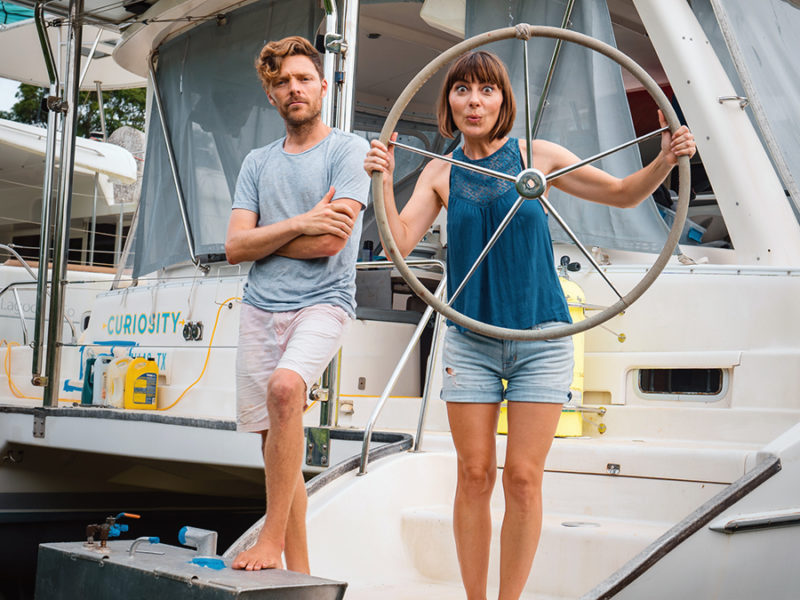
Knocking Out Boat Projects. So Close To SAILING!
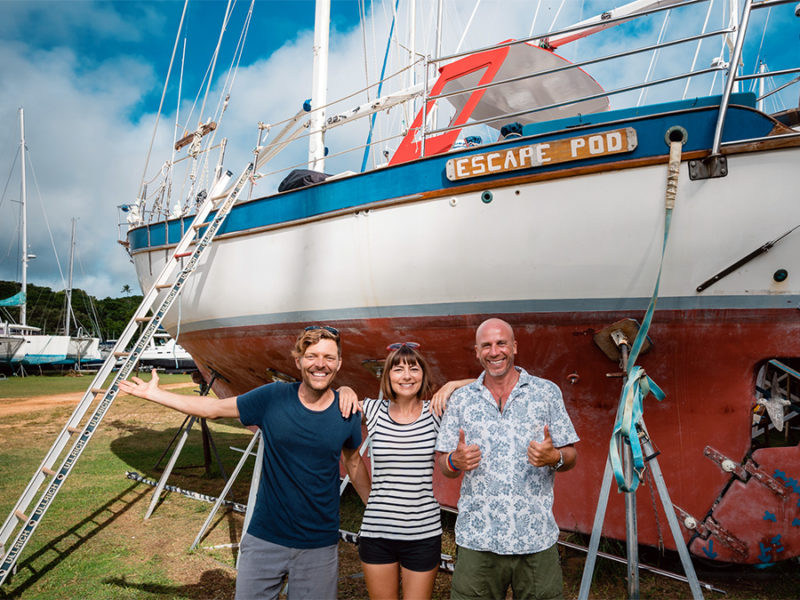
BOAT TOUR: The Irishman & His Electric Escape Pod

Scammed On Anchor Chain, What You Need To know.

Living on a boat OUT OF THE WATER

5 Best Marine AC Units (For A Cool Boating Experience)

Josh Mitchell
Expert Reviewed By
Last Updated On
April 9, 2024
“If you make a purchase using our provided links, we may receive a commission. Learn more here.
A hot day on the water doesn't have to mean sweating to death. The best marine air conditioners can keep the inside of a boat ice cold even on those 100-degree days.
I know that a marine air conditioner can be an expensive investment that should not be taken lightly.
That's why I made this list of the best marine AC units to help boaters find the best way to stay cool in those hot summer months.
Quick Glance - My Recommendations
Dometic Brisk II B57915.XX1C0
Editor's choice.
Webasto AC Retrofit Kit
Best Replacement Marine AC

Dometic Emerald Titanium DEUX
Best High-End
5 best marine air conditioners for a cool day of boating, 1. dometic brisk ii b57915.xx1c0.
Best Rooftop AC
Overall Score
Energy Efficiency
Cooling Ability
Value for Money
Who is the Dometic Brisk II best for?
This Dometic marine air conditioner is best for people who don’t have room for a conventional marine air conditioner.
- No condensate line or water pump required
- Completely self-contained
- Easy to install if you already have a hole
- The unit is very noisy
- Installation may require extra bracing on the roof
The Dometic Brisk II resembles an AC unit on a camper or RV, but this one goes on the roof of your boat.
It is a perfect replacement for an existing roof-mounted air conditioner unit, and I really like how easy it is to add to a boat without air conditioning.
Not all boats can support a roof-mounted marine air conditioner. However, this air conditioner does not take up space inside , and it is easily accessible to work on.
The condensing and evaporator unit is housed entirely on the roof and is shielded from the elements with a cover.
One thing that some people do not like is that the air conditioner is visible from the outside.
However, I don’t mind it on some boats because the white cover keeps the unit from sticking out like a sore thumb.
The noise level is also a common complaint, but it’s about as loud as a window air conditioner.
All that you will see inside the boat is the ceiling-mounted vent and the air conditioner controls.
The indoor trim is called a distribution box and provides a way to direct airflow (I often compare it to the air vents in a car).
The air conditioner’s manual contro ls are also mounted on the distribution box.
The Dometic Brisk II requires a 14" X 14" hole in the roof with structural supports.

The boat's roof must be able to support about 75 lbs, and there must be space to run electrical wires.
If you are comfortable making a couple of cuts in the boat, then this can be a DIY job.
I'm pretty daring, but this is one of those projects that could turn into a major undertaking.
Also, remember that lugging this thing onto the roof alone may be difficult, so be sure to guilt a friend into helping.
Alternatively, the Brisk II can connect to ductwork. This would require your boat to have air ducts running up to the roof, as well as a thermostat mounted on a wall.
Although I like the cleaner look of a ducted system, few boats have ductwork running to the ceiling.

If you don’t have ducts already running to the ceiling, then I would stick to a self-contained marine air conditioner, like the Webasto AC Retrofit Kit below.
2. Webasto AC Retrofit Kit
Who is the Webasto Retrofit Kit best for?
The Webasto Retrofit Kit is the best marine air conditioner for people who need to replace their existing marine air conditioning system.
- Easy to install yourself
- Compact enough to fit anywhere
- Includes digital thermostat
- Unit is painted to prevent rust and corrosion
- Noisier than comparable self-contained units
- Thermostat requires a special cable
I found the Webasto AC Retrofit Kit to be the perfect replacement for an aging marine air conditioner that is limping along on its last leg.
I really like this self-contained unit, but unlike the Dometic Brisk II , it does not require cutting a hole in the ceiling.
The compact size makes it easy to install, no matter the current unit's size.
The Webasto AC Retrofit Kit is a standard, self-contained marine system, so it relies on seawater for cooling.

It also requires a condensate drain hose , which can connect to the boat's bilge. I prefer to connect to the waste tank so the bilge isn't constantly filling up with condensate.
Besides AC, the Webast Retrofit AC Kit also has heat, which is great for boating in the winter months or for people traveling up north.
Setting the AC and heat is easy with the included digital thermostat that can be mounted on a wall with the included cable.
If you don't want to get up to change the temperature, Webasto has you covered with an optional remote control.
If your boat doesn't have AC, then the Webasto AC Retrofit Kit is a good option.
I recommend looking for an easy place to install it, like under a bench or bed. Try to find a place close to existing plumbing and an electrical box.
All that's required for installation is a 5" piece of ductwork, ¾" piping for the seawater inlet/outlet, 12-gauge stranded wire, and some determination.
It also needs a submersible pump to suck water from the sea.
3. Dometic Emerald Titanium DEUX

Premium Model
Who is the Dometic Emerald Titanium DEUX best for?
The Dometic Emerald Titanium DEUX is the best marine air conditioner for large boats with over 300 square feet.
- Several different BTU options available
- Customize your AC with different air handlers
- Condenser noise stays contained to the engine room
- Also serves as a heat pump
- Very complicated to install
- Requires separate air handlers

When I look at a new air conditioner, I expect it to last for a long time. The Dometic Emerald Titanium DEUX has the best marine air conditioner design on the market!
The white painted body helps to protect it from rust and corrosion. There are also brackets that serve as a frame to protect the compressor if it gets jostled around.
The Dometic Emerald Titanium DEUX is not a standalone unit. Unlike the Webasto AC Retrofit Kit , this air conditioner only consists of a compressor.
The upside is that you can mount this unit in an exterior compressor compartment and run pipes to the evaporator.
I like modular systems, especially for larger boats, since they allow for more customizability.
The Dometic Emerald Titanium DEUX is the perfect choice for large boats because it comes in a range of cooling capacities.
I mentioned that this is a well-built system, and that is evident when trying to pick up this 150 lb brick.

Be sure to keep the weight in mind because you will need help to get it aboard.
Although I really like the quality of the Dometic Emerald Titanium DEUX , I can't overlook the installation challenges.
Copper lines must be run to a condensing unit, and electrical wiring must be connected to both the condenser and the evaporator.
It also needs a thermostat to control the air conditioner.
4. Ivation IVACA6500
Dehumidifier AC Combo
Who is the Ivation IVACA6500 best for?
The Ivation IVACA6500 is best for people who want to quickly and easily add a marine air conditioning system to their boat.
- Easily add air conditioning in less than an hour
- One of the cheapest marine air conditioning systems
- Has a digital thermostat built-in
- Dehumidifying mode removes moisture
- Requires an opening window
- No option for heating
The first time I saw the IVACA6500, I mistook it for a home window air conditioner.
It works just like a window air conditioner, with the condenser sitting outside and the evaporator inside.
The only difference is that the IVACA6500 actually has two separate parts connected by a rubber tube.
This makes it ideal for marine applications, thanks to the flexible mounting system .
The most important thing that may be a problem is the need for a window that opens to pass the connections through.
I found installation to be super simple, though, thanks to the included adjustable brackets.
These brackets allow for placement adjustment by clamping the unit to the window.
However, I recommend placing the unit below the window and modifying the brackets to mount it in a more discrete location.
After you get the unit mounted, just plug it into a 120V outlet and fire it up . The digital thermostat on the front can set the air conditioning to a desired temperature.

However, I find that these thermostats are not nearly as accurate as wall-mounted ones used in traditional AC systems, like Dometic and Webasto .
As a light sleeper, I highly recommend this unit for a bedroom thanks to its quiet operation at 55 dB.
I suggest setting the timer to turn the air on an hour or two before bed so it is nice and cool, then take advantage of the sleep mode to quiet the fan noise.
During the day, I find it much better to use the dehumidifier mode.
I like the IVACA6500's dehumidifier mode since it is perfect for keeping the boat nice and dry on those temperate days.
Some people do complain about the look of the outdoor condensing unit, but at least it doesn’t obstruct the window.
I personally don’t think it looks bad, and it is easy to remove the unit in the cooler months.
At only 6,500 BTUs, the Ivation IVACA6500 will cool a room or a small boat . One good thing about the smaller units is that it doesn't need a ton of electricity to keep it going.
With that in mind, you are still stuck running on shore power with this air conditioner.
5. MarinAire Self-Contained Marine AC

Best Small Compact AC
Who is the MarinAire Self-Contained Marine AC best for?
The energy-efficient MarinAire Self-Contained Marine AC is best for boats with little room for a marine AC unit.
- Self-contained unit with plastic housing
- Energy efficient cooling power
- Pressure gauges to check refrigerant
- Insulated blower keeps noise down
- Humidistat controls humidity levels
- Requires a separate water pump sold separately
- Special wiring must be run to the thermostat
The MarinAire is my favorite self-contained air conditioning unit, but it is unique.
The compressor and coils are protected by a molded plastic case, which definitely adds some protection.
The case also helps to keep the noise level down when the air conditioner is running.
The MarinAire is also the most compact marine ACs I've come across, and it is even smaller than the Webasto AC Retrofit Kit .
It will fit in tight compartments or under benches where other self-contained systems can't.
I also like the hook on top, which is a lifesaver when lowering the air conditioner into the cabin. It really turns the installation into a one-man job.
The standout features are the built-in pressure gauges to quickly check the high and low pressures without special tools.

I’ve looked at a lot of marine air conditioners with varying features, but the Marinaire has some of the best features included, such as a wireless remote.
It also comes with a conventional thermostat for the wall.
The Marinaire is the only marine AC unit I have seen with wireless connectivity.
You can control the marine AC unit from anywhere with the included WiFi thermostat (assuming you have internet access).
Installation is also a breeze since this is a self-contained unit.
The main components not included are some pipes for the stainless steel drain pan and water cooling, as well as a pump.
From there, all it takes is running the pipes and wire for the thermostat and humidity sensor wiring to the cabin.
Finally, connect the duct (size varies by BTU) and plug in the marine AC unit to start cooling off.
Comparing Marine Air Conditioners
Factors to consider when choosing a boat ac, what size cooling does your boat need.
The exact size cooling capacity your boat needs requires a complex calculation.
My general rule of thumb is that one BTU (British thermal units) cools about 5 square feet and heats 10 square feet.
This is based on moderate climate control and cooling an area below deck.
- Large Boats The Dometic Emerald Titanium Deux is perfect for large boats over 500 square feet . I recommend this for a very large yacht with a separate engine compartment and large living spaces. Sometimes, larger boats use two units.
- Medium Sized Boats Smaller boats from 200-500 square feet have a few options, including the Webasto AC Retrofit Kit and the Marinaire AC system. These self-contained systems are perfect for small to mid-size boats with room to run a short piece of ductwork.
- Small Boats Finally, marine AC units like the Dometic Brisk II and Ivation IVACA 6500 are perfect for small boats in the 100-200 square foot range.
I always consider the size of an existing marine AC unit and also perform a new calculator.
There are several formulas that get very scientific, but a simple online capacity calculator is my go-to.[ 1 ]
TL;DR: You much choose an AC system based on the covered area of your boat. The larger the boat, the more powerful systems with high BTU capacity is required.
What Is Your Budget?
The most budget-friendly marine air conditioners cost less than $1,00 0, while ducted systems can easily cost a few thousand.
I know most people have a budget in mind with these larger projects. In that case, the budget will dictate what type of system you can get.
A traditional self-contained marine AC system like the Marinaire or Webasto I mentioned above typically costs about $2,500.
Split systems like the Dometic Emerald Titanium Deux cost significantly more.
The exact price varies by dealer as Dometic does not advertise the cost for its high-end split systems.
AC Lab Note:
Don't forget to consider installation, which will likely cost about the same as the unit, depending on the required work. Similarly, split systems cost significantly more to install than self-contained marine air conditioners.
Continuing on with self contained systems, the Dometic Brisk II is a fairly cheap option as it starts around $1200.
However, the cost to install may be higher than other self-contained systems like the Marinaire and Webasto .
Retrofitting a smaller unit like the Ivation will be the most affordable route. I commonly see these systems for around $700.
Most marine AC units I've found run on a generator, which will add a significant cost if you don't already own one.
TL;DR: You budget would dictate the type of AC you choose. Some AC systems like the split or self-contained marine AC systems are more expensive than roof-mounted ACs.
How Long Is The Warranty?
Marine air conditioner warranties vary significantly between brands, but most come with at least a one-year parts warranty.
Higher-end models like Dometic's Emerald Titanium come with a parts and labor warranty.
In comparison, companies like Webasto and Ivation have a parts-only warranty.
One and two year parts warranties are pretty standard in the marine air conditioner industry.
I find that Dometic offers the best marine air conditioner warranty at two years on many of its higher-end products. It is also one of the most inclusive warranties.
TL;DR: One and two years parts warranty is fairly standard but try to look for a unit that offers a longer warranty period.
How Easy Is It To Install?
Some marine air conditioning systems are easy to install, while others vary in complexity .
More importantly, everyone has a different level of abilities.
People planning a DIY install should first determine if there is room in the boat to mount a self-contained unit. Then, plan where to run the pipes and electrical.
Alternatively, consider a roof-mounted unit if there isn't space for a conventional marine AC unit.
The roof-mounted unit requires a single hole but also requires framing out the roof around it.
Most people don't want to spend days hacking away at their beloved boat , so I would go with the Ivation IVACA6500 , or even a portable boat air conditioner.
The most difficult-to-install marine AC units are split systems, where the condensing unit goes in the engine room.
These are more expensive units and difficult to install since pipes must be run throughout the boat.
These may also require extra refrigerant to be added, and the lines must be vacuumed.
I would only recommend this system for really large boats or if it is already undergoing extensive maintenance.
TL;DR: Most ACs systems are easy to install, some like the roof-mounted ACs would require cutting holes. Marine ACs are also very heavy so they will definitely require help in installation.
How Easy Is It To Maintain?
Maintaining marine AC units is similar to keeping up with a home AC system .[ 2 ]
The most important thing to do is keep the return air filters clean. I also recommend checking the coils annually to ensure they are not dirty.
A chilled water system such as the Webasto , Marinaire , and Dometic Emerald Titanium I looked at do require a little extra attention, such as ensuring the water does not freeze in cold months.
I am a fan of low maintenance , and you can’t get much simpler than the Ivation IVACA 6500 and the Dometic Brisk II .
Both marine AC units are easy to access , so filter cleaning requires little effort.
The good thing about most marine AC units is that they are serviceable.
Most marine AC systems mentioned above have service ports so an AC tech can easily perform a check-up and get the system running like new again.
TL;DR: Look for marine ACs that offer ease-of-maintenance features such as service ports, easy to access filters etc.
How We Review & Rank Our Product List
At Air Conditioner Lab, our team follows a similar process when evaluating all products reviews before formulating our final lists for readers.
We begin by gathering data sources directly from brands, e-commerce platforms, online retailers and press releases.
These are then added to a master file we use to compare features specifications from all air conditioner models. You can access this Air Conditioner Sheet Here .
Next, we narrow down all the products on the market by evaluating user reviews, ratings and feedback from a wide variety of online and in-person sources.
Our team then discusses and co-ordinates our first hand experiences using these products, as well as gather independent opinions and feedback through Youtube and customer reviews.
4 Types Of Marine ACs Found On Boats

1. Self-Contained Units
Self contained marine air conditioners like the Webasto and Marinaire place the condenser and blower in a single package.
Most marine air conditioners rely on seawater to cool the returning refrigerant. These units are very efficient, quiet, and compact, which is perfect for a boat.
Adding this type of marine air conditioner is also very easy, even if your boat never had air conditioning.
All that they require is a hose for the seawater, electrical, and a hole for the vent.
Using a vent means self-contained units are great for directing airflow to a specific part of the boat.
It is also worth noting that self-contained units can also refer to portable, roof-mounted, or hatch-mounted systems where the condenser and evaporator are together in one assembly.
2. Hatch-mounted Units
A boat hatch-mounted marine air conditioner is designed to fit into a boat’s existing hole in the roof.
These units are very easy to install, but they come with a few challenges.
Hatch mounted air conditioners are essentially a window AC unit with an angled duct that attaches to the boat's hatch.
I often see people confuse roof-mounted air conditioners like the Dometic Brisk II with hatch-mounted marine AC units. It may be possible to install a roof-mounted AC unit into a hatch, but most hatches are too large.
3. Chilled Water Units
Chilled water units are some of the most popular marine AC systems, and chilled water may be used on both split and self-contained systems.
A pump takes seawater and pushes through copper piping on the chiller, known as a heat exchanger.
Instead of using large condensing coils like your home's AC system, the seawater cools the coils, so there is no need for a fan.
Besides heat transfer, chilled water units still operate like most other air conditioners.
For instance, they have a compressor, evaporator coil, and a reversing valve (on heat pump models).
To boil this down, chilled water units are perfect for boats because there is a constant supply of water to keep the system cool.
This also removes the need to place a condensing unit outside since the seawater literally removes heat from the boat.
4. Split-air Units
A split-air unit is simply an air conditioning system where the condenser and evaporator are separate.
In most applications, the condenser coils and compressor are outside, while the evaporator coils and air handler are inside.
This is the exact opposite of a self-contained marine air conditioner. However, it can use either a chilled water system or an air-cooled condenser.
I don’t want to make this too complicated, but the Ivation we covered is technically a split system since the condenser and evaporator are separate.
However, a more conventional example is the Dometic Emerald Titanium DEUX .
Split systems are ideal for larger vessels with an engine room or boats with multiple evaporator units.
I recommend against these complex split systems for many boaters because they are very complicated, and repair can be costly.
TL;DR: There are many different types of marine AC systems. Some systems are suitable for smaller covered area such as roof-mounted ACs, others systems like split air or self contained units are essential for larger covered area.
How Many Watts Does A Marine Air Conditioner Use?
The exact number of watts a marine air conditioner uses varies by model and BTUs. For example, a 6,000 BTU self-contained unit uses about 500-550 watts.
How Long Do Marine Air Conditioners Last?
A marine air conditioner’s lifespan hinges largely on how well it is taken care of. The average life is about ten years, but this may vary depending on how much use it gets.
How Do You Size A Marine Air Conditioner?
You size a marine air conditioning unit based on the cubic footage of the boat, as well as sun exposure and climate. A quicker and easier way to get in the ballpark is by multiplying 5 BTU times the square feet of the boat.
How Do You Maintain A Marine Air Conditioner?
The most important part of maintaining a marine air conditioning unit is to clean out the return air filter and keep the condensate pan clear. Be sure that water does not freeze in the pump or pipes during the winter.
What Is The Difference Between Refrigeration And Air Conditioning On A Ship?
Refrigeration and air conditioning are often used interchangeably when discussing cooling systems on a ship.
However, the word refrigeration is mainly used when talking about cooling systems like freezers and other cold storage. In contrast, air conditioning commonly refers to regulating temperatures in a living space.
So, Which Will You Buy?
The best marine air conditioner will depend on your boat’s size and needs. I like all of the marine AC units that we covered, but each one really fits a specific need.
However, I find the MarinAire Self-Contained system to be the best marine air conditioner because of its casing and integrated gauges.
But best of all, it is easy to install.
I also like the units built by major brands like Dometic marine air conditioners because they are well-built for a harsh marine environment and offer an excellent warranty.
My #1 Recommendation
References:
- https://www.marinaire.com/category-s/28.htm
- https://www.energy.gov/energysaver/maintaining-your-air-conditioner

My Favorite Home Appliance?
Midea U Shaped Window Air Conditioner
Share Feedback
Read the latest from Josh Mitchell
- 6 Reasons Why Air Purifiers Are Never a Waste of Money
- Air Purifier Vs Humidifier - Explained For Homeowners
- Air Purifier vs Air Conditioner: Differences &…
- How Long Should You Run an Air Purifier? (Explained!)
- Quick & Easy Guide to Buying Window Air Conditioners
- Why We Started AC Lab
- How We Create Our Content
- Meet The Team
- Privacy Policy
- Affiliate Disclosure
Join Our Community
© 2024 AirConditionerLab.com. All Rights Reserved.

A Guide to Yacht Air Conditioning Systems
- by yachtman
- September 13, 2023 August 26, 2023

Yacht air con is a must-have for luxury vessels. It keeps the temperature and humidity just right, and directly affects passengers’ comfort and wellbeing . It’s efficient and prevents mold growth. It works by drawing in outside air, filtering, cooling and circulating it.
Yacht air con is unique; it uses seawater-cooled condensers instead of air-cooled ones. This saves space and makes cooling more efficient. Plus, multi-zone systems give customised comfort.
For top performance, maintain the system regularly. Clean filters and coils for efficiency and life-extension. Reduce heat gain with insulation and tinted windows. Use shades and awnings to protect windows from the sun.
Having a reliable yacht AC will make your journey much better. You’ll enjoy enhanced comfort, and a better cruising experience. So make sure you invest in a good one!
Understanding the different types of yacht air conditioning systems:
Understanding the Various Types of Air Conditioning Systems on Yachts:
There are several different types of air conditioning systems available for yachts, each with its own unique features and benefits. Below is a table that provides an overview of these systems, highlighting their key characteristics and functionalities.
It is worth noting that each type of yacht air conditioning system offers its own set of advantages and considerations. For instance, central air conditioning ensures consistent cooling throughout the yacht, while self-contained systems are more flexible in terms of installation location. Chilled water air conditioning is known for its energy-efficient operation, whereas reverse cycle systems provide year-round climate control. Ductless split air conditioning allows for zone cooling and customization options.
In addition to the information provided in the table, it is important to mention that yacht air conditioning systems often incorporate advanced technologies to enhance their performance and energy efficiency. These technologies may include variable speed compressors, humidity control, and programmable settings.
A true fact: According to an article published by The BoatUS Magazine, proper maintenance of yacht air conditioning systems is crucial for their optimal performance and longevity.
Need a cool breeze aboard your yacht? Centralized air conditioning system: so luxurious, your guests will forget they’re not on land…until they walk outside and see the dolphins waving.
Centralized air conditioning system
Centralized air conditioning systems are a popular cooling method used on yachts. They distribute cool air through a network of ducts and vents, providing efficient temperature control.
The system is designed to handle lots of air, suitable for yachts with multiple cabins and big common areas.
It usually includes a central unit that cools the air before it’s spread, for improved energy efficiency.
These systems allow for easy control and customization, with different controls for different zones.
Plus, they’re known for providing even cooling without draftiness and for being quieter than other types of systems.
Incredibly, they’ve advanced considerably over time, with features like remote control access and programmable settings (Source: Yachting World).
Components and functioning of a centralized air conditioning system
A centralized air conditioner has various components that work to regulate temperature and give comfort. The table below shows different components and what they do:
In addition, a centralized system may have filters, thermostats, and ducts to manage airflow efficiently.
Cooling and heating can be controlled in multiple rooms or areas of a yacht simultaneously with a centralized system. This allows for individual comfort levels.
Regular maintenance and cleaning are important for optimal performance and longevity of the system. Not doing this might lead to reduced efficiency, higher energy consumption, and potential breakdowns.
Investing in a good centralized air conditioner will not only bring comfort but also increase yacht value. Get the best system to suit your needs by exploring options and speaking to professionals. Enjoy the hot summer days at sea in comfort!
Pros and cons of a centralized system
A centralized system for yacht air conditioning comes with both advantages and disadvantages. Let’s check them out:
Another perk of a centralized air conditioning system is that it allows for different areas within the yacht to be tailored to individual comfort preferences. This boosts guest satisfaction.
Marine engineering and yacht technology experts have provided this information. They are experts in the field with lots of experience.
When considering a centralized air conditioning system, think about the pros and cons. Make an informed decision.
Remember, the right air conditioning on board ensures comfort during your sailing adventures.
Self-contained air conditioning system
A self-contained air conditioning system is a compact, all-in-one unit. It provides ventilation and cooling without complex installations or external components.
Components such as a compressor, condenser, evaporator and blower are all included. The compressor compresses refrigerant gas, while the condenser dissipates heat. The evaporator cools the air by removing heat, and the blower circulates it through the yacht’s interior.
This type of system has many advantages. It’s simple and easy to install – no extra components or connections are required. You can also choose where to install it, based on your needs.
Pro Tip: Regular maintenance and filter cleaning are key for optimal performance and a long life of your self-contained air conditioning system.
Components and functioning of a self-contained system
A self-contained system for yacht air conditioning is composed of certain components which work together to give the best cooling and ventilation. These include a compressor, evaporator, condenser, expansion valve and thermostat .
Let’s take a look at the table to understand how this system works:
Every component is important for maintaining a comfortable atmosphere in the yacht. The compressor compresses the refrigerant gas and circulates it . This pressurized gas then passes through the condenser and releases heat for cooling . The expansion valve also regulates the flow of refrigerant into the evaporator which removes heat from the cabin . Lastly, the thermostat is used to set the desired temperature.
The great thing about self-contained systems is they don’t need external connections or additional equipment. This makes them easy to install in yachts without much modifications.
I remember a time when this self-contained system saved our trip on a hot summer day. While we were cruising, the temp became too high and unbearable inside. Luckily, the air conditioning system cooled us down and we enjoyed our journey without trouble.
Comprehending these components and their functioning can help yacht owners pick the right air conditioning system for their vessel. Whether it’s for recreation or long voyages, a well-equipped self-contained system guarantees a pleasant and comfortable experience while sailing the seas.
Pros and cons of a self-contained system
Self-contained systems possess independent components for heating and cooling. Pros and cons are listed in the table:
Also, their limited cooling capacity is a downside for larger yachts or areas needing more heat output. Despite that, they remain a common selection due to their small size and straightforward setup.
A yachtsman once shared his experience with one. Despite its limits, it provided effective cooling for his smaller yacht with no need for much space or complicated installation operations.
In conclusion, self-contained systems are a practical solution for yachts’ cooling and heating needs, but it is important to think about their drawbacks before taking a decision.
Factors to consider when choosing a yacht air conditioning system:
Factors to Consider When Selecting a Yacht Air Conditioning System:
When choosing the ideal air conditioning system for your yacht, several crucial factors should be taken into consideration. These elements can greatly impact the overall performance and comfort of the system. To help guide your decision-making process, here are key points worth considering:
- Cooling Capacity: Assess the cooling capacity of the air conditioning system to ensure it can effectively cool the desired area within your yacht, accounting for factors such as the size of the space and the number of occupants.
- Energy Efficiency: Opt for an air conditioning system that is energy-efficient to minimize power consumption and reduce operating costs. Look for systems with high SEER (Seasonal Energy Efficiency Ratio) ratings for optimal efficiency.
- Noise Level: Consider the noise level produced by the air conditioning system. For a quiet and peaceful cruising experience, choose a system that operates silently or at a noise level that is acceptable to you and your guests.
- Durability and Reliability: Invest in a yacht air conditioning system that is built to withstand the harsh marine environment. Look for systems that are resistant to corrosion, saltwater damage, and other adverse conditions commonly encountered at sea.
- Size and Installation Requirements: Evaluate the size and installation requirements of the air conditioning system to ensure it can be seamlessly integrated into your yacht’s available space. Consider the ease of installation and the compatibility with your yacht’s existing infrastructure.
- Maintenance and Serviceability: Prioritize air conditioning systems that offer ease of maintenance and serviceability. Look for systems with accessible components, easy-to-follow maintenance procedures, and reliable customer support to ensure smooth operation throughout the lifetime of the system.
These considerations will help you make an informed decision when selecting a yacht air conditioning system.
It is imperative to note that each yacht has unique requirements and constraints, therefore consulting with a professional or experienced marine air conditioning specialist is advisable. They can provide personalized recommendations based on your specific needs and circumstances.
Yacht Air Conditioning Systems: A True History
The evolution of yacht air conditioning systems has come a long way since their inception. Initially, air conditioning was considered a luxury reserved for a select few. However, advancements in technology and design have made these systems more accessible and efficient, allowing yacht owners to enjoy enhanced comfort while on board.
Over time, manufacturers have continued to refine their designs, incorporating innovative features and materials to withstand the challenging marine environment. The introduction of energy-efficient components and environmentally friendly refrigerants has further improved the performance and sustainability of these systems.
Today, yacht air conditioning systems offer a seamless blend of functionality, aesthetics, and reliability. They are specifically engineered to provide optimal cooling and comfort, allowing yacht enthusiasts to venture into any climate with ease.
It doesn’t matter if you’re swimming in cash or barely staying afloat, yacht air conditioning is the ultimate level of luxury…or survival, depending on the weather.
Size and capacity requirements
Size and capacity are vital when picking a yacht air conditioning system. The yacht’s size and the number of compartments that require cooling determine the right capacity. Refer to the table below for guidance:
Other details to think about include the insulation quality of the yacht’s structure and the climate conditions. Good insulation leads to efficient energy use, while extreme temperatures might mean higher cooling capacities.
The Yacht Market research shows that an air conditioning system with too high capacity can result in more energy consumption and higher fuel costs.
Energy efficiency and power consumption
The table below shows the energy efficiency and power consumption of several AC systems:
Higher EER indicates better energy performance. Lower power consumption is best for the yacht’s electrical supply. Consider eco-friendly features or tech when comparing systems. Smart sensors can adjust settings and optimize energy usage.
Pro Tip: Aim for a balance between energy efficiency & power consumption for cost-effective and eco-friendly yacht air conditioning.
Noise levels and vibration
A yacht is a luxurious symbol of elegance. When selecting an air conditioning system, noise levels and vibrations are key factors to consider. Who wants to be disturbed by a loud hum or shaking?
Let’s take a look at the technical side. Here’s a table with info:
The noise and vibration levels vary for each model. It’s important to think about this when making your choice. Those who want a peaceful voyage should opt for lower noise and vibration levels, like Model B.
Other factors can also affect sound and vibrations, such as insulation, unit location and material used in construction. Knowing these details will guarantee a comfortable journey.
Make the right decision and sail away in tranquility. Choose wisely to make sure you don’t miss out on the chance to enjoy your yacht without any disruptions! Let peace be your guide and make memories that will last a lifetime.
Maintenance and servicing requirements
When selecting a yacht air conditioning system, maintenance and servicing needs must be taken into account. Proper upkeep will guarantee that you stay cool on hot days at sea. Here are some maintenance regulations to keep in mind:
- Clean filters and coils often to prevent dirt and dust buildup.
- Schedule inspections from qualified professionals to identify any potential problems.
- Deal with issues right away, so they don’t worsen or cost more.
- Adjust maintenance for different seasons.
Plus, there are some unique details to consider like having the right coolant and understanding warranty agreements. To keep your yacht air conditioning running smoothly, try these tips:
- Invest in a system with user-friendly controls.
- Maintain a regular maintenance schedule.
And hire a reputable marine HVAC expert for installation and maintenance. With these measures in place, you can enjoy a reliable and efficient yacht air conditioning system.
Installation and setup process of yacht air conditioning systems:
The installation and setup process of yacht air conditioning systems involves several steps to ensure proper functionality. Here’s a concise guide to help you with the process:
- Assess the yacht: Begin by evaluating the yacht’s layout and determining the most suitable locations for air conditioning units.
- Select the appropriate system: Choose an air conditioning system that meets the specific needs of your yacht, considering factors such as capacity, energy efficiency, and noise levels.
- Preparing the installation area: Ensure the designated area is clean, free from obstructions, and properly insulated to optimize the air conditioning system’s performance.
- Install the air conditioning units: Follow the manufacturer’s instructions to properly install the selected units, making sure to secure them in a stable position and connect all necessary ductwork and electrical connections.
- Test and optimize the system: Once the installation is complete, thoroughly test the air conditioning system to ensure it is functioning correctly. Adjust settings and airflow as needed for optimal comfort.
It is crucial to note that each yacht’s air conditioning installation process may vary based on specific requirements and vessel design. Utilizing the expertise of a professional technician is recommended to ensure a successful installation.
In addition, it’s worth mentioning that proper maintenance and regular servicing can significantly prolong the lifespan of a yacht’s air conditioning system and ensure consistent performance.
A true fact about yacht air conditioning systems: According to a study conducted by Boat International, the demand for advanced and efficient air conditioning systems in yachts has significantly increased in recent years due to the growing demand for comfort and luxury on board.
Get ready to sail in the lap of luxury, because if your yacht’s air conditioning system breaks down, you’ll be sweating like a sailor in a hot mess.
Preparing the yacht for installation
- Assess the yacht’s layout: Take time to analyze the structure and find good spots for AC units. Consider size, shape, and access.
- Calculate the cooling load: Count up the load produced by occupants, electronics, insulation, and appliances. This helps pick a system that can handle the load.
- Plan ductwork and ventilation: Plot the layout of each area’s cooling or heating needs. Good ventilation is key for even temperature.
- Ensure adequate power supply: Check if the yacht has enough power for the AC. Upgrade or modify the electrical system, if necessary.
- Select suitable equipment: Pick quality air conditioners made for marine use. Think about efficiency, noise, and compatibility.
- Consult with professionals: Get advice from technicians or HVAC specialists. They know best which system to install on your vessel.
- For extra prep: Consider optimizing insulation and installing solar panels. Clean and inspect air filters, vents, and ductwork. Monitor humidity levels too.
These steps will help make your AC more effective, plus lead to a comfy yachting experience. Prepare your yacht well and you’ll get the most out of the AC system.
Mounting and positioning the air conditioning unit
Steps to install and maintain your air conditioning unit:
- Pick the perfect spot for your air conditioning unit. Make sure it has good airflow and is easy to reach for maintenance.
- Use the right brackets or supports and ensure it is level. This will stop vibrations or noise when it is running.
- Connect the electrical parts as the maker’s directions say. All connections must be secure and kept away from water or other dangers.
- Place the unit to get the most cooling power. Look at factors like the sun, blockages, and air flow on the vessel.
- Test the unit completely before you’re done. See if there are any problems like leaking, funny noises, or faults and take care of them quickly.
You should also:
- Put insulation around the supply ducts and return air vents. This will help reduce heat moving and improve cooling performance.
- Clean and maintain your AC unit regularly. This will help it last longer and work better.
These steps help cool air travel easily, while keeping heat out. Having it in the right spot and secured correctly will keep it safe from damage, making it last and work correctly. Cleaning and upkeep will make it more efficient and help it work well.
Connecting the necessary wiring and ductwork
- Identify the electrical connections needed for your air conditioning system. Find the power source and choose the right wiring configuration. Make sure all connections meet safety guidelines.
- Set up the ductwork layout for proper air distribution. Look at factors like size, shape and material of the ducts to improve efficiency. Place them carefully to get to all areas without causing damage.
- Secure the connections by fastening wires properly and sealing duct joints with tape or sealants. Test the system completely to be sure it works well before carrying on with installation.
It’s important to remember that connecting wiring and ductwork needs precision and attention. Errors or bad connections can lead to inefficiencies or even safety risks.
For instance, a yacht owner had broken wiring and ductwork connections during an air conditioning installation . This led to regular breakdowns due to inadequate cooling and poor airflow control. After getting help, it was found that improper connections were the cause of the inefficiencies. Repairing this solved performance and comfort problems.
So, being careful when connecting wiring and ductwork is essential for a successful air conditioning system installation on your yacht. Taking into account all the technical aspects will give you better performance and longer system life, plus maximum comfort during sailing!
Testing and troubleshooting the system
Connect the power supply and check the circuit breaker panel for secure connections and no loose wires.
Make sure the thermostat is set to the desired temperature and mode.
Clean and replace air filters to maintain performance.
Inspect for condensate drain blockages and leaks.
Check the ductwork for obstructions and damage.
Captain John was cruising the Mediterranean when his yacht’s air conditioning stopped working. He discovered a malfunctioning condensate pump and fixed it himself.
Testing and troubleshooting can prevent breakdowns and ensure a comfortable climate.
Stay proactive in maintaining your air conditioning system to avoid unpleasant surprises at sea.

Tips for maintaining and troubleshooting yacht air conditioning systems:
Yacht Air Conditioning Systems: Tips for Maintenance and Troubleshooting
When it comes to ensuring the optimal functioning of your yacht air conditioning systems, it is important to follow certain tips. Here are some useful insights to help you maintain and troubleshoot these systems effectively:
- Regularly clean air filters: One of the key maintenance tasks is cleaning the air filters to prevent clogging and ensure proper airflow. This helps in maintaining the cooling efficiency and prolongs the life of the system.
- Check for leaks: Inspect the system for any leakage regularly. Leaks can lead to a loss of refrigerant and affect the cooling performance. Fixing leaks promptly can prevent further damage and ensure efficient operation.
- Clean the condenser coils: Over time, the condenser coils can accumulate dirt and debris, reducing their heat transfer capability. Regular cleaning of these coils improves the efficiency of the system and allows it to cool effectively.
- Monitor the thermostat settings: Ensure that the thermostat is set to the desired temperature and operates correctly. Incorrect settings or faulty thermostats can result in inadequate cooling or unnecessary energy consumption .
- Schedule professional maintenance: Consider hiring a professional technician to perform routine inspections and maintenance tasks. They can identify potential issues early on and provide necessary repairs or adjustments , ensuring optimal performance.
Furthermore, it is important to note that the seawater pump, fans, and electrical connections should also be regularly checked and maintained to avoid any problems. By adhering to these tips, you can enjoy comfortable and efficient air conditioning on your yacht.
Pro Tip: Keep a logbook to record maintenance activities and any issues encountered. This can help track patterns, identify recurring problems, and guide future maintenance requirements.
If you’re not a fan of regular cleaning and filter replacement, you might need to adjust your air conditioning system’s sense of hygiene.
Regular cleaning and filter replacement
Lookin’ to up your yacht air conditioner’s game? Here’s what ya need to know:
- Clean external parts, like vents and grills, to get rid of any dust or debris. Keep air flowin’!
- Filters play a big role in trapping particles. Replace ’em regularly to keep ’em workin’.
- Clean reusable filters per manufacturer’s guidelines. Prolong their lifespan!
- Have a professional inspect it at least once a year. They can spot any underlying issues.
Plus, here’s somethin’ worth considerin’: Different filters may be needed based on the system. Check the manufacturer’s guide or get expert advice. Cleanin’ products or solutions may also be recommended. Follow the instructions provided! Lastly, inspections reveal potential leaks or damage that could impact performance.
A true story: A yacht owner forgot to clean and replace filters for a long time. This caused dust to clog up the vents, putting a strain on the compressor and leading to its failure during a voyage. Moral of the story? Regular maintenance is essential. Don’t forget it!
Addressing common issues and problems
Yacht air conditioning systems are usually reliable, but troubleshooting potential problems is key to make sure they run smoothly. To help you out, here’s a table with the most common issues and their solutions:
Plus, it’s important to clean and maintain your AC regularly. This includes cleaning air filters, checking refrigerant levels, and scheduling pro inspections.
Take action quickly when these common AC issues arise. That way, you can avoid further complications and have a comfortable journey.
Fun Fact: The first functioning home AC was invented by Willis Carrier in 1902! Source: Biography.com
Hiring professional technicians for complex repairs
Professionals can provide specialized knowledge and tools for complex yacht air conditioning repairs. Plus, hiring them will save you time!
My mate learnt this the hard way. He tried to fix his own issue but only made it worse. In the end, he had to call in experts who fixed the initial problem and rectified the additional damage.
So, when it comes to complex repairs, trust the pros and get the job done right!
Conclusion: Ensuring optimal comfort and air quality on your yacht with the right air conditioning system.
Optimal comfort and air quality onboard your yacht is paramount; the right air conditioning system is vital for achieving this. With advances in technology, yacht owners have plenty of options to choose from.
A popular one is the chilled water system : a centralized unit cools the water that is pumped through pipes and coils installed throughout the yacht. This system provides efficient cooling that can keep a consistent temperature across the yacht. It also offers better humidity control and quieter operation than other systems.
Alternatively, the Direct Expansion (DX) system uses refrigerant for cooling instead of water. The main benefit of this system is its size and simplicity – making it ideal for smaller yachts or spaces with limited installation space. However, it may struggle to provide the same level of temperature control as a chilled water system.
In addition to the system type, insulation, ventilation, and filtration should also be taken into account. Proper insulation helps maintain desired temperatures while reducing heat transfer from external sources. Good ventilation ensures fresh air circulation and eliminates odors and moisture. High-quality filters capture pollutants, allergens, and dust particles before they enter the living spaces on board, and must be regularly maintained to ensure they work effectively.
All in all, selecting the right system for your yacht is essential for optimal comfort. Consider size, efficiency, temperature control options, and maintenance requirements before buying.
90% of new superyachts are fitted with advanced air conditioning systems that prioritize energy efficiency and environmental sustainability , according to Boat International magazine . So, whatever climate you’re cruising in, investing in a dependable and efficient system will maximize your yachting experience with optimal comfort and improved air quality.
Frequently Asked Questions
1. How does a yacht air conditioning system work?
An air conditioning system on a yacht works by circulating cool air throughout the vessel. It consists of three main components: the compressor, the condenser, and the evaporator. The compressor compresses refrigerant gas, which then flows to the condenser where it is cooled and turned back into a liquid. The liquid refrigerant then passes through the evaporator, where it absorbs heat from the air, cooling it down.
2. What are the types of yacht air conditioning systems available?
There are primarily two types of yacht air conditioning systems: self-contained units and split-gas systems. Self-contained units have all the components housed in a single unit, which is easy to install and maintain. Split-gas systems have a separate evaporator unit and a condensing unit, allowing for greater flexibility in terms of placement and better cooling efficiency.
3. How do I choose the right size air conditioning system for my yacht?
Choosing the right size air conditioning system for your yacht depends on several factors such as the size of the vessel, the number of cabins, and the climate in which you’ll be sailing. It’s important to consult with a professional yacht air conditioning specialist who can analyze your specific requirements and recommend an appropriately sized system.
4. How often should I service my yacht air conditioning system?
Regular servicing is crucial for maintaining the efficiency and longevity of your yacht air conditioning system. It is recommended to have your system serviced at least once a year by a qualified technician. However, if you frequently use your yacht or sail in harsh conditions, more frequent servicing may be required.
5. Can a yacht air conditioning system run on battery power?
Yes, it is possible to run a yacht air conditioning system on battery power. However, this requires a significant battery bank and a reliable power source like a generator or shore power to recharge the batteries. It’s important to properly calculate the power consumption and have a suitable electrical system in place to support the air conditioning system.
6. How can I improve the energy efficiency of my yacht air conditioning system?
To improve the energy efficiency of your yacht air conditioning system, you can take several steps. These include proper insulation of the yacht, minimizing air leaks, ensuring regular system maintenance, using energy-efficient equipment, and utilizing natural ventilation whenever possible. Consulting with an expert in marine HVAC systems can provide additional guidance tailored to your specific yacht’s setup.
Leave a Reply Cancel reply
Your email address will not be published. Required fields are marked *
Save my name, email, and website in this browser for the next time I comment.

The Marine Electronics Hub

- LiFePO4 / Cabin & deck gear / Network & control / Electrical & Engines / The future / Green Boating
A cool and quiet sailboat thanks to efficient air conditioning, LiFePO4 batteries, and Integrel
by Ben Stein · Published July 20, 2022 · Updated July 20, 2022
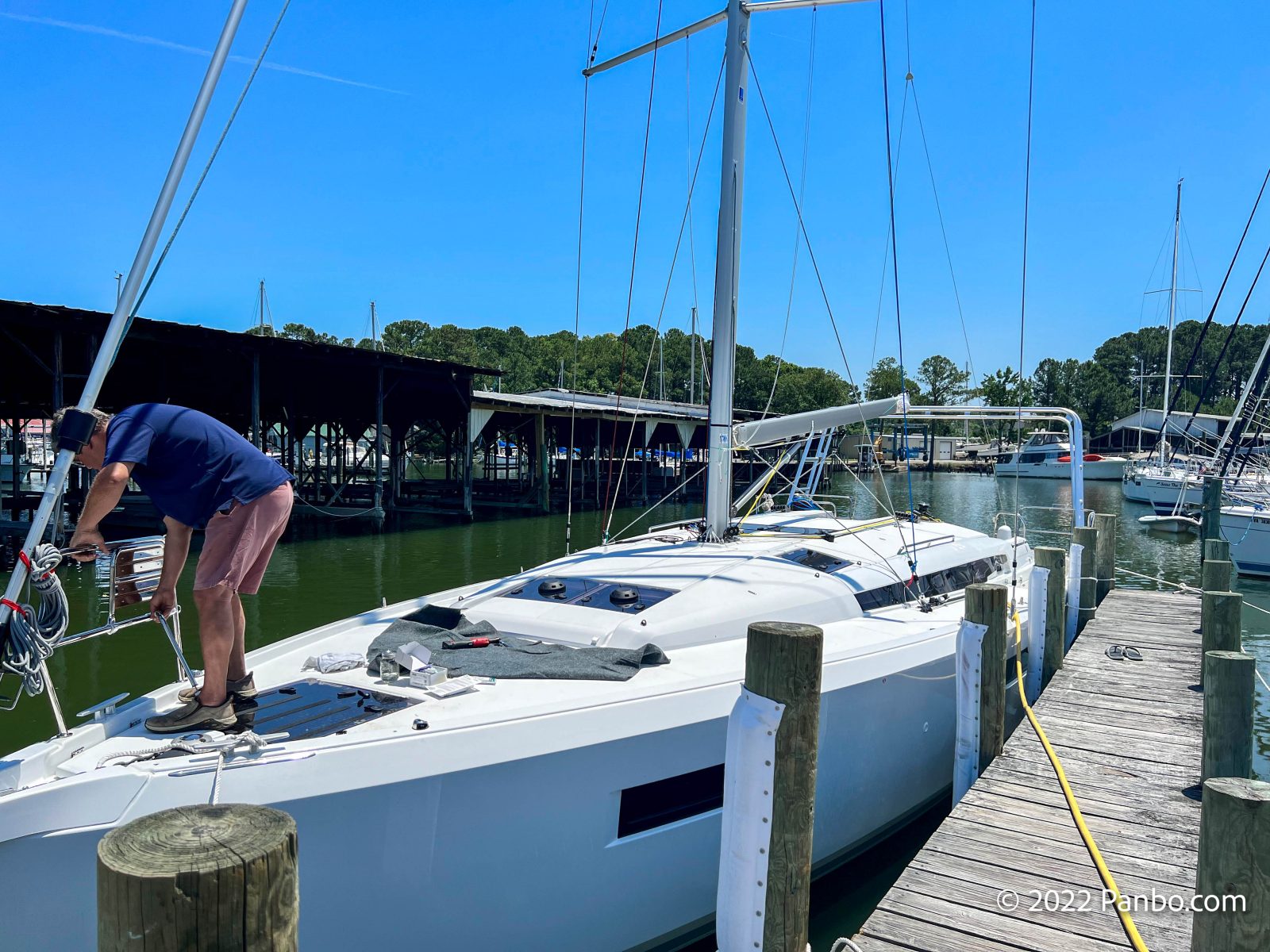
I work around boats pretty much every day of my life. So, what would cause me to jump in my car and drive 28 hours round trip to go see a boat? The answer: A brand new, luxury 44-foot sailboat ordered with no generator and no air conditioning. But fear not, although it was delivered without systems many regard as required, it’s now been outfitted with arguably the best air conditioning and power systems available.
The combination of highly efficient air-conditioning from Termodinimica , Victron batteries, power conversion and distribution equipment, Kilovault LiFePO4 batteries, and Integrel’s 9kw power generation solution make comfort aboard possible in a way that was a dream just a few years ago. These systems deliver comfort and quiet, without a generator.
The obvious hesitation with an all DC boat is will it stand up to extended use and cruising? I visited the boat during the commissioning stage of the myriad systems aboard. From what I saw, the systems are up to delivering on the promise of silent comfort with ample juice for many years to come.

Phil Gutowski and his company, BoatRX have carved out quite a niche designing and installing high-efficiency air conditioning systems in boats of all shapes and sizes. Phil was kind enough to write a primer on DC air conditioning for Panbo several years ago that captured the attention of many regular Panbo readers.
Phil’s article concentrated on DC air conditioners making climate control possible on vessels that previously had none. But, that’s not the case on Cinnamon Girl. Instead, the owner of this new build, 44 Jeneau Sun Odyssey has chosen advanced air conditioning, batteries, power management, and power generation in order to deliver an efficient, quiet boat that’s not dependent on a generator running to deliver comfort.
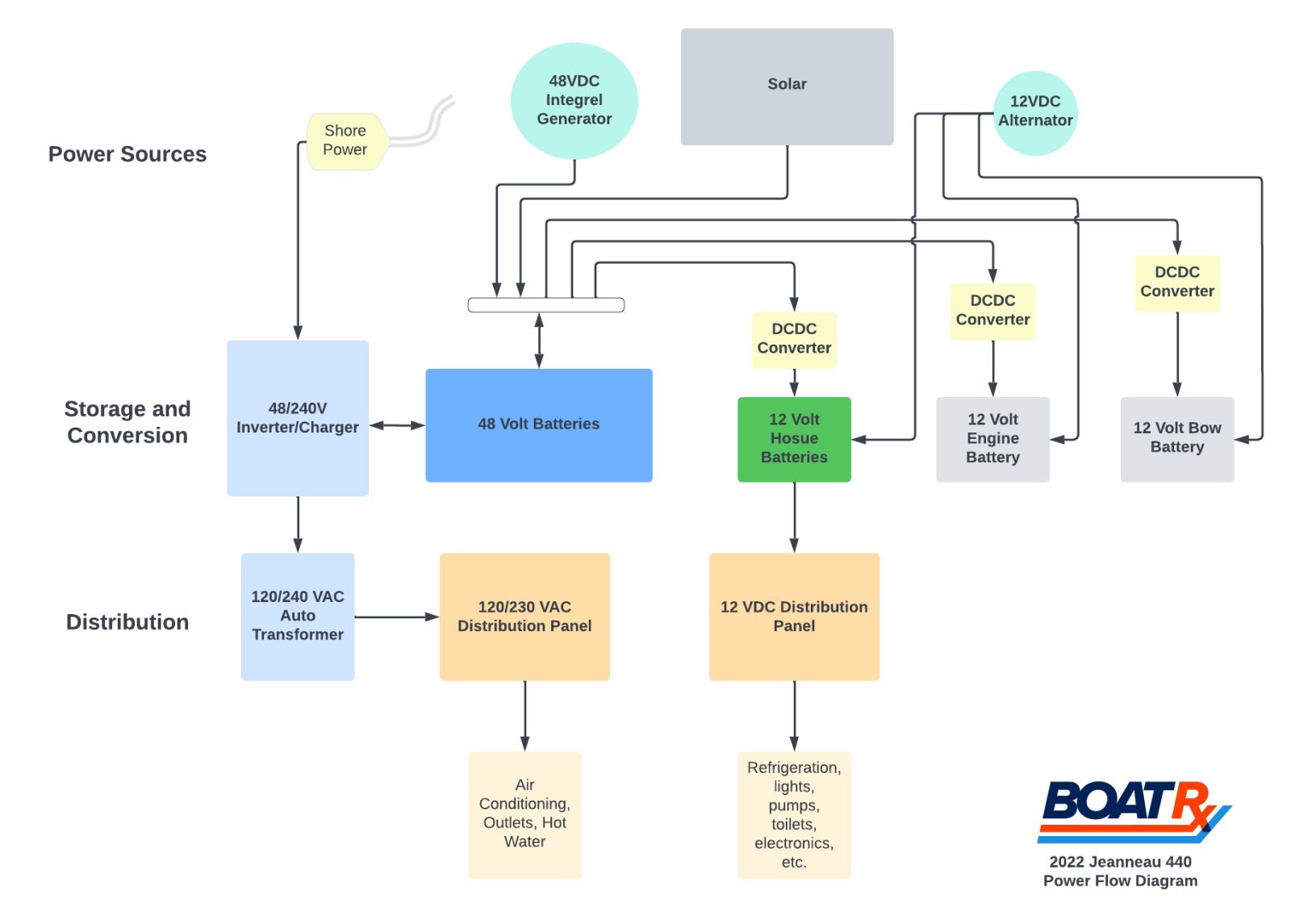
Let’s start by understanding what the owner was after when he started this project: To start, the owner was clear he wanted to deliver cruising comfort without a generator. Additionally, he required full air conditioning overnight with power delivered via batteries. In order to run the air conditioning from batteries, it’s critical you can quickly replace the energy consumed from the batteries. So, fast recharging of the batteries is another requirement. The owner will install a watermaker, so power for the watermaker and other ship systems is factored in. Lastly, in addition to bulk charging sources, solar panels will also be added to the boat.
BoatRX presented three different options to the owner. Two of the options relied on all 12-volt designs with more traditional alternators. The third, and winning, proposal relies on a 48-volt battery bank that powers a large inverter. That inverter powers the air conditioning loads as well as all onboard 110-volt systems and loads. Additionally, there’s a 12-volt house bank to power all the boat’s 12-volt loads.
To really understand everything that is happening aboard Cinnamon Girl , I think we need to look at three major separate systems that make the magic happen. These systems were carefully engineered by BoatRX to work together and deliver the desired ownership experience. They are the air conditioning system from Termodinamica , the power system consisting of AC (240 volts and 120 volts) and DC systems (both 12 and 48 volts), and Integrel’s advanced 48-volt alternator system. This was a large project. Installation took several weeks and the total budget was around $135,000. The owner did mention that ordering the boat without air and a generator saved nearly half the project cost.
Power system
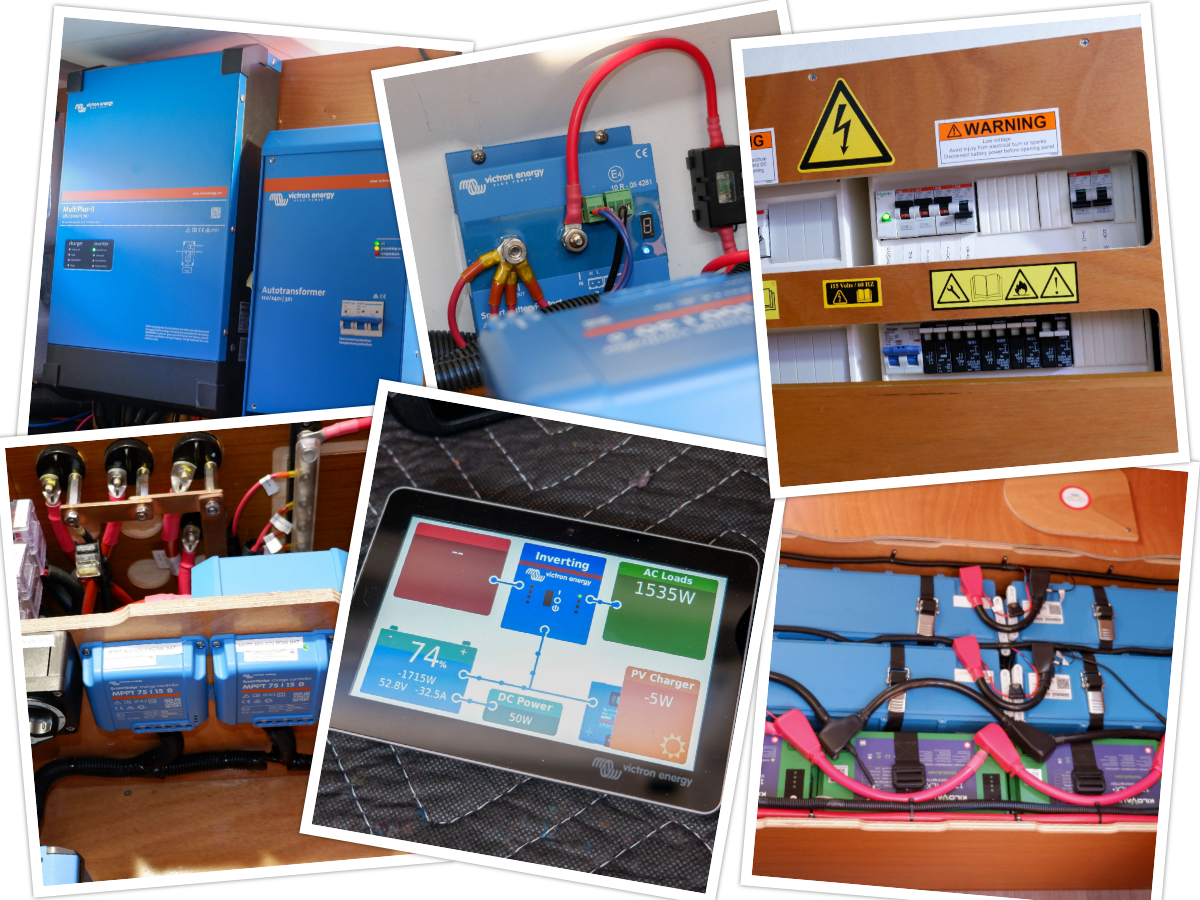
The final power system aboard Cinnamon Girl consists of a 120-volt / 240-volt alternating current system and a 48-volt DC house system, and a 12-volt DC house system. Additionally, there are lead-acid engine start and bow thruster batteries.
Shore power
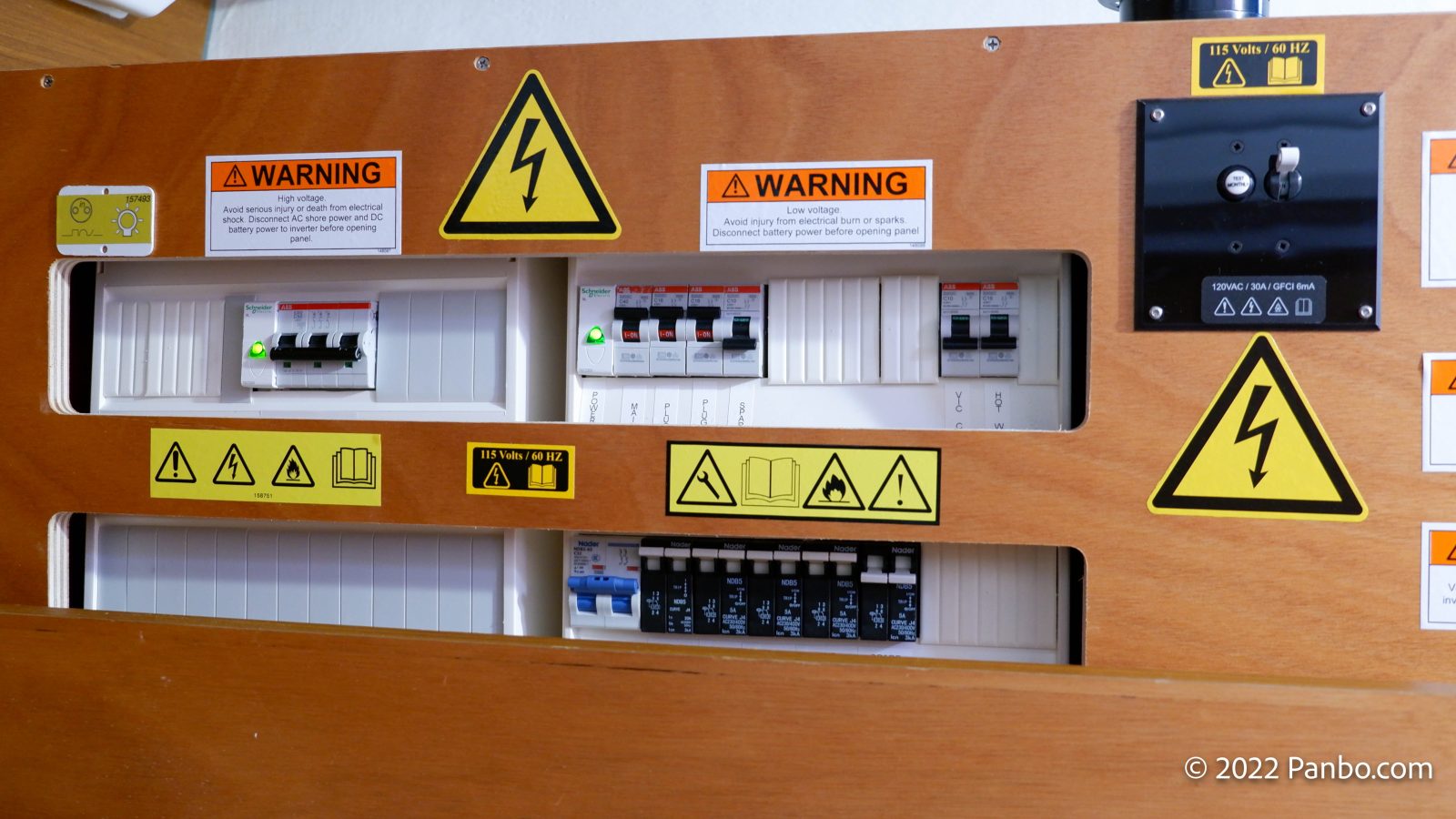
A North American spec Jeanneau 440 comes with a single 240-volt, split-phase, 50-amp shore power inlet. Once on the boat, power is divided into two 120-volt legs and distributed throughout the boat at 120 volts.
The new air conditioning system requires 240 volts, so some changes were necessary. BoatRX modified the boat’s electrical system to directly route 240-volt power to the boat’s inverter, then to a Victron Autotransfomer and then, for house loads, back to the boat’s AC distribution panel.
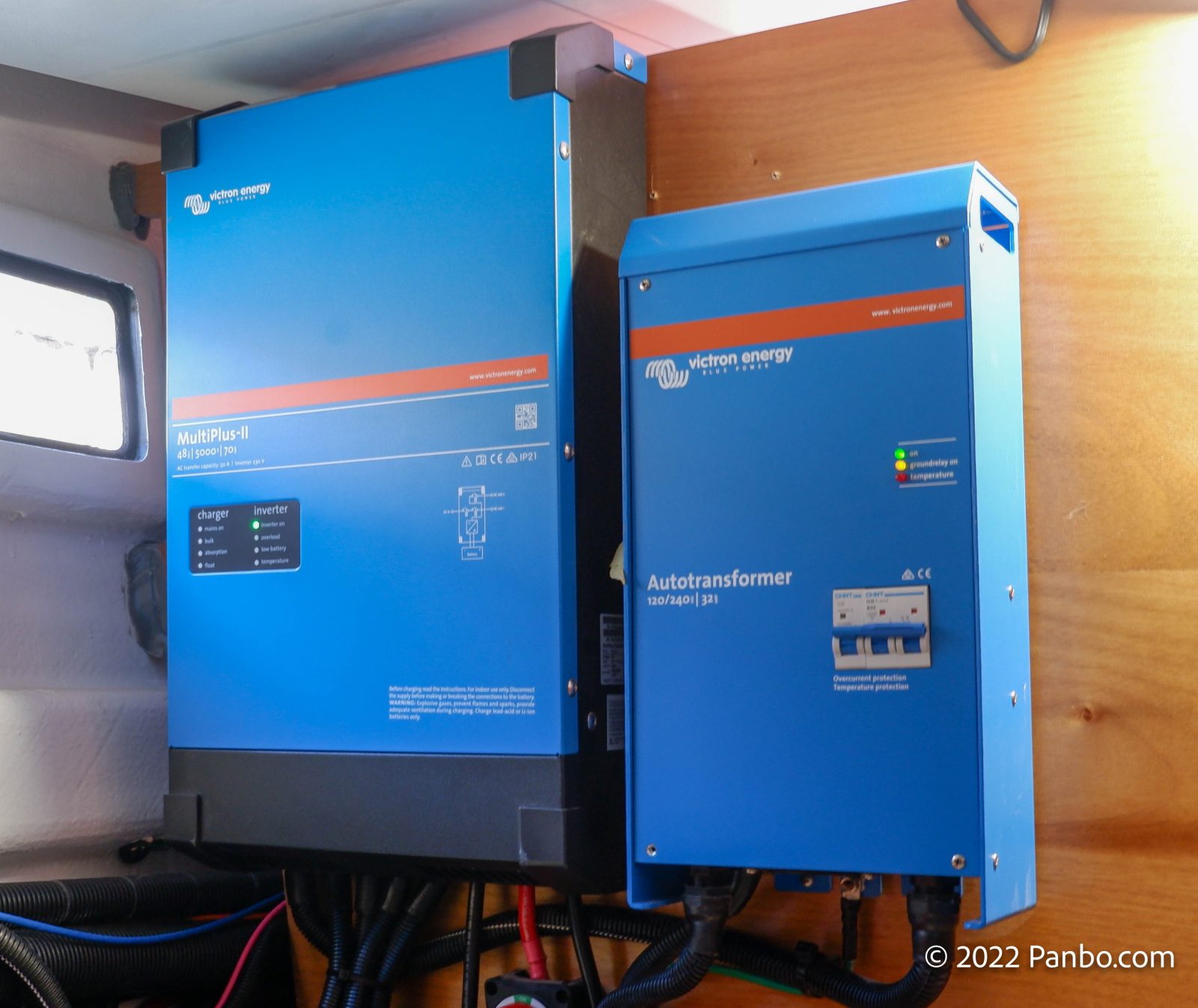
The heart of the newly reconfigured AC power system is a 5000-volt-amp, 230-volt Victron Multiplus-II and a 120/240-volt, 32-amp Autotransformer . When connected to shore power, the inverter accepts a 240-volt input from shore power and outputs 230v to the Autotransformer. The Autotransformer accepts the 230-volt single-phase, 60hz output from the inverter and creates 120/240-volt 60hz split-phase output.
The combination of the Autotransformer and Multiplus-II give tremendous input power flexibility. The inverter will accept input power from 187 to 265 volts at a frequency between 45 and 65 hertz. Plus, in the event of smaller available shore power circuits, the inverter can utilize Victron’s PowerAssist to augment available power.
The only AC loads on the boat not powered via the inverter are the hot water heater and a dedicated 12-volt battery charger. The boat has to be connected to shore power for the element to heat.
House and inverter batteries
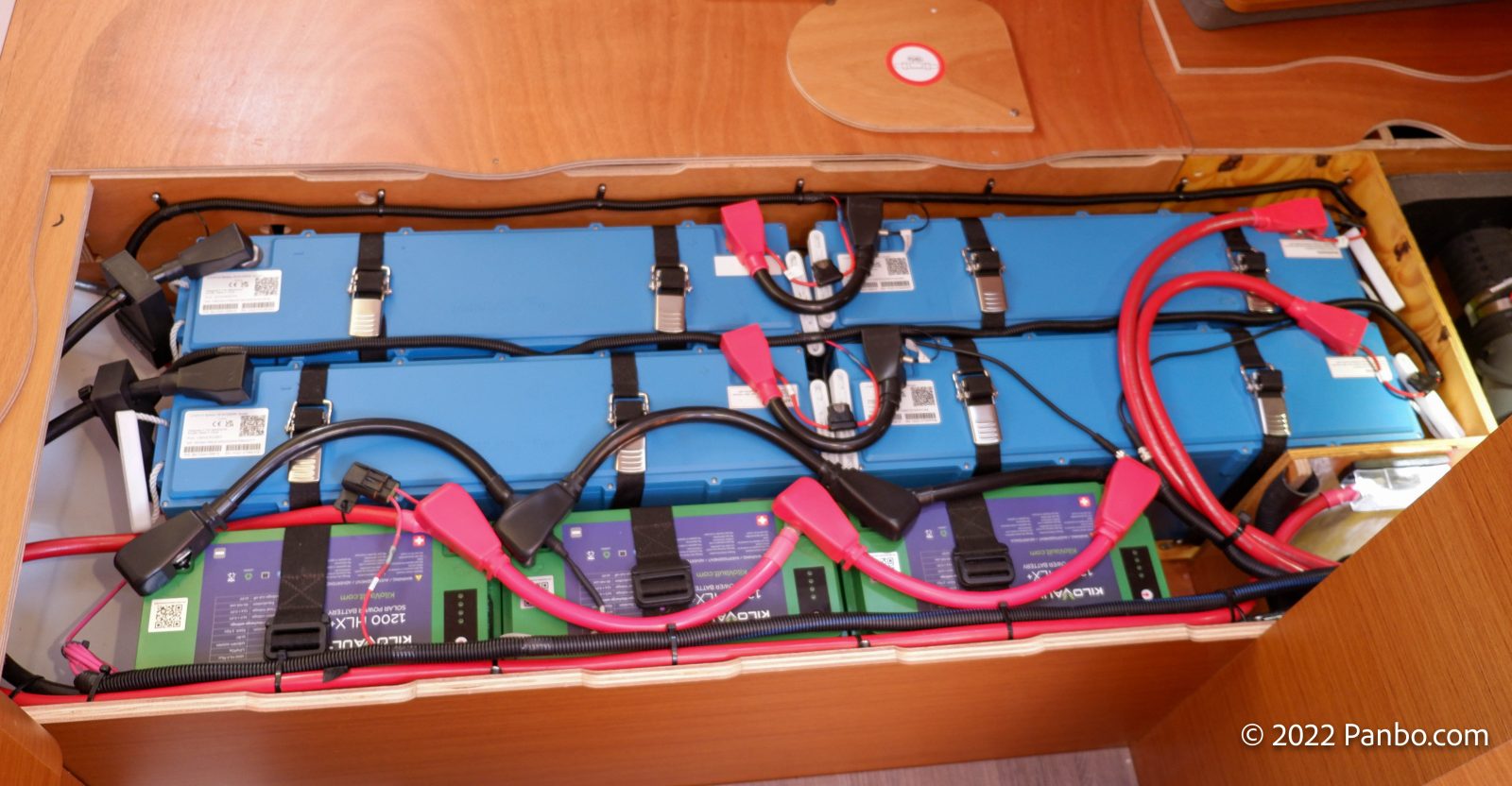
Cinnamon Girl has two separate lithium iron phosphate (LiFePO4) battery banks. There’s a 48-volt bank composed of four 25.6-volt, 200 amp hour Victron Lithium Battery 25.6 Smarts. Connected in serial and parallel, the total capacity of the bank is 400 amp hours at 48 volts or roughly 20-kilowatt-hours. There’s also a 12-volt parallel string of Kilovault 100-amp hour batteries providing a total of 3.6-kilowatt-hours.
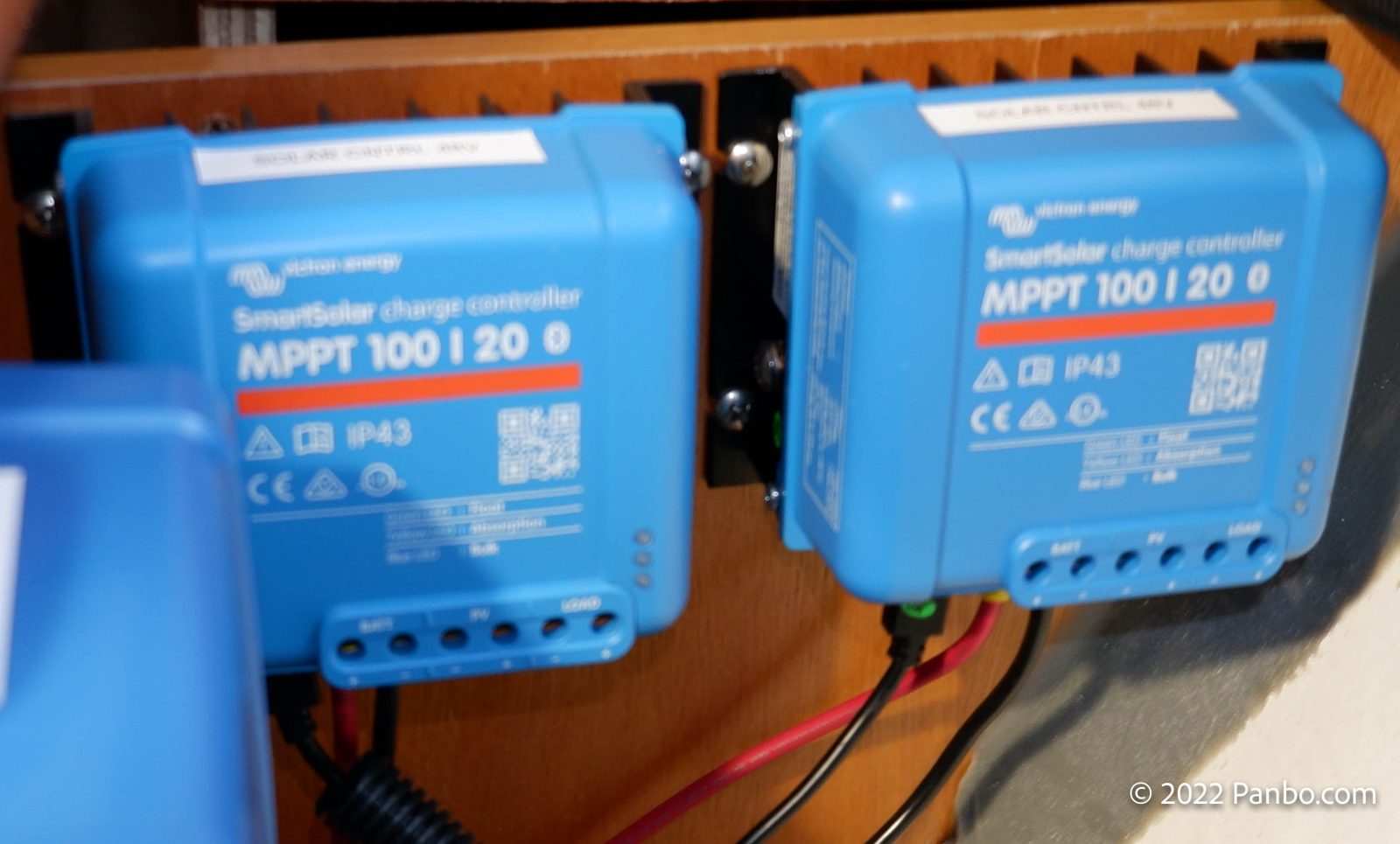
The 48-volt battery bank services just the inverter but has a plethora of charge sources. When connected to shore power, the inverter charges the batteries at up to 70 amps continuously. That’s an impressive 3.36-kilowatts of charge current or the equivalent of 280 amps of charge at 12 volts. The 48-volt bank will also be charged by 1,000 watts of solar via Victron MPPT controllers. Lastly, and far from least, the Integrel system will also charge the bank at up to 9 kilowatts or a somewhat staggering 188 amps at 48 volts.
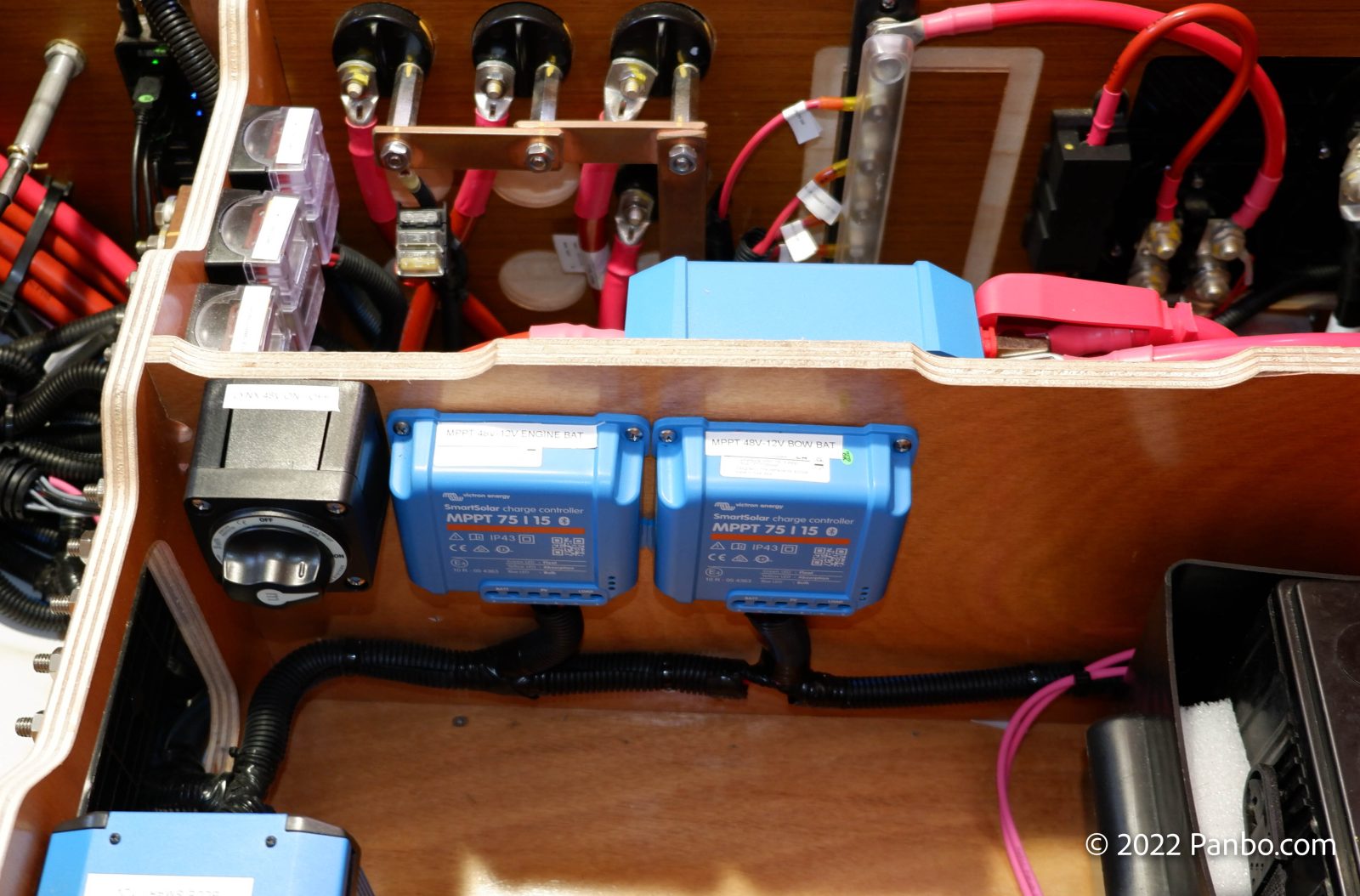
In normal operation, the 48-volt bank sits at the top of the DC food chain. This bank accepts charge from the sources outlined above and then shares power with the 12-volt house battery bank, engine battery, and bow-thruster battery. This power sharing happens through Victron MPPT chargers used as DC-to-DC converters. Phil Gutowski explained they selected MPPTs rather than Orions because of the greater voltages supported and size configurations available.
But, even without the 48-volt bank, the 12-volt bank isn’t suffering from a lack of charging options. BoatRX installed four Victron MPPTs employed as DC to DC converters charging the 12-volt house batteries from the 48-volt bank. There’s also a 240-volt AC to 12-volt DC battery charger to charge the 12-volt house bank, engine start, and bow-thruster batteries. Lastly, the Yanmar 4JH’s 120-amp alternator, paired with a Balmar MC618 regulator, charges all three banks.
Integrel power generation system
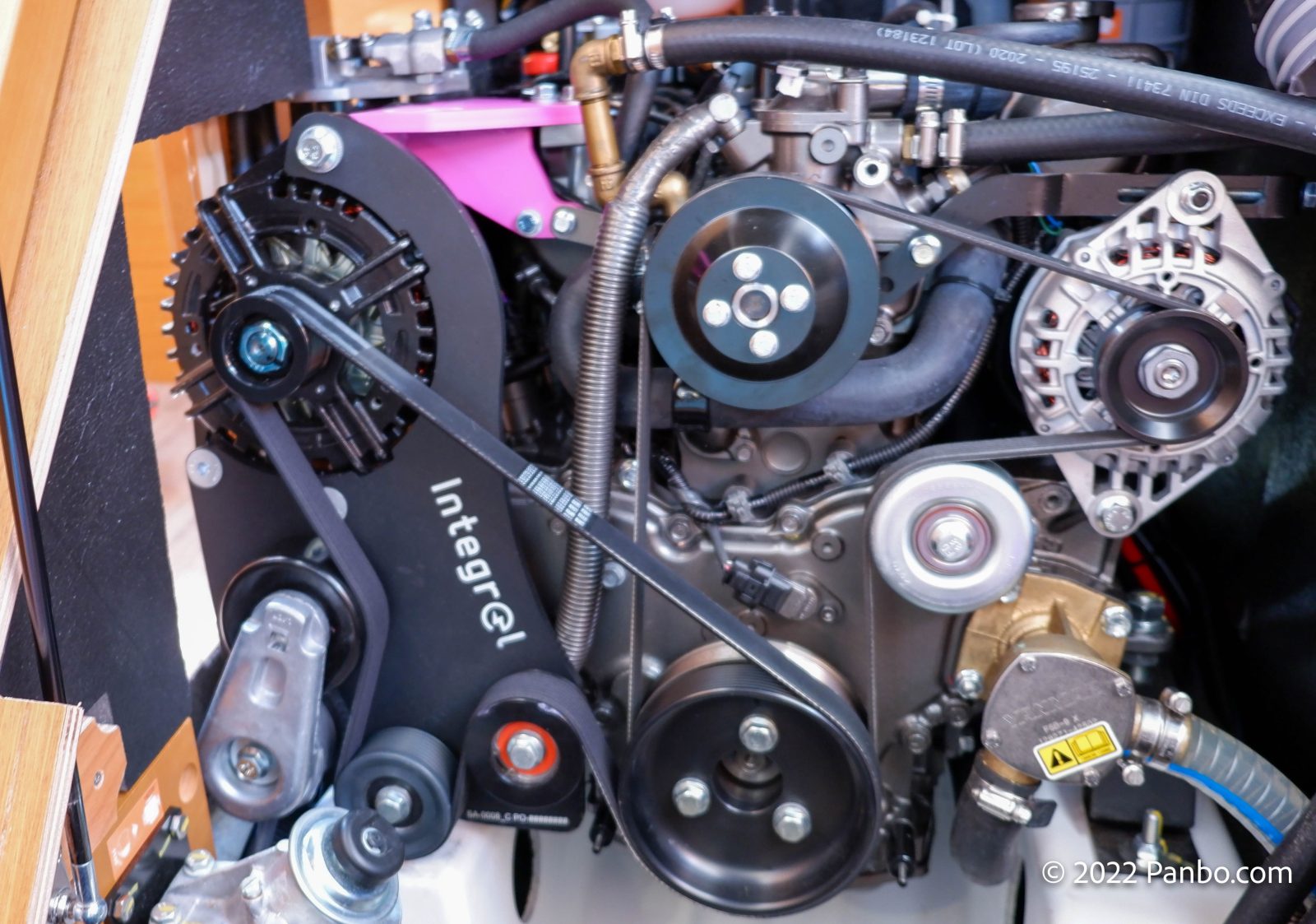
Integrel’s power generation system can generate up to 9 kilowatts of power from the main propulsion engine. On Cinnamon Girl it’s mated the Yanmar 4JH57. Originally developed by Nigel Calder, Integrel utilizes an extremely high output alternator producing around 56 volts to charge a 48-volt battery bank. They call the system an engine-mounted generator to better convey the quantity of power the system can produce.
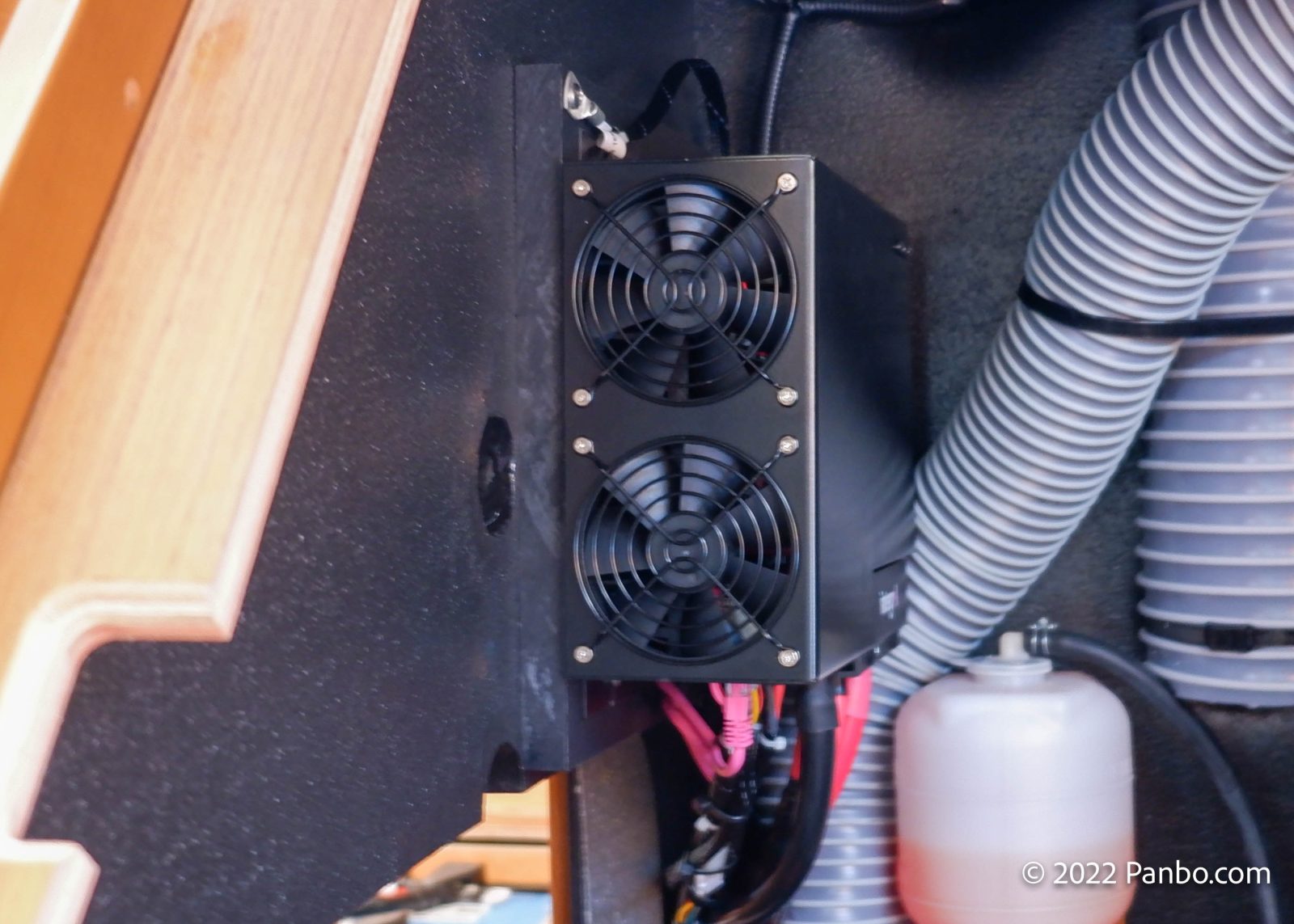
Integrel’s advanced control system utilizes numerous sensors and a J1939 connection to the engine’s control unit to regulate the system. The control system utilizes engine load information so that it can dial back the load it places on the engine. This ensures there’s sufficient propulsive power available but allows Integrel to harness power that would otherwise be wasted.
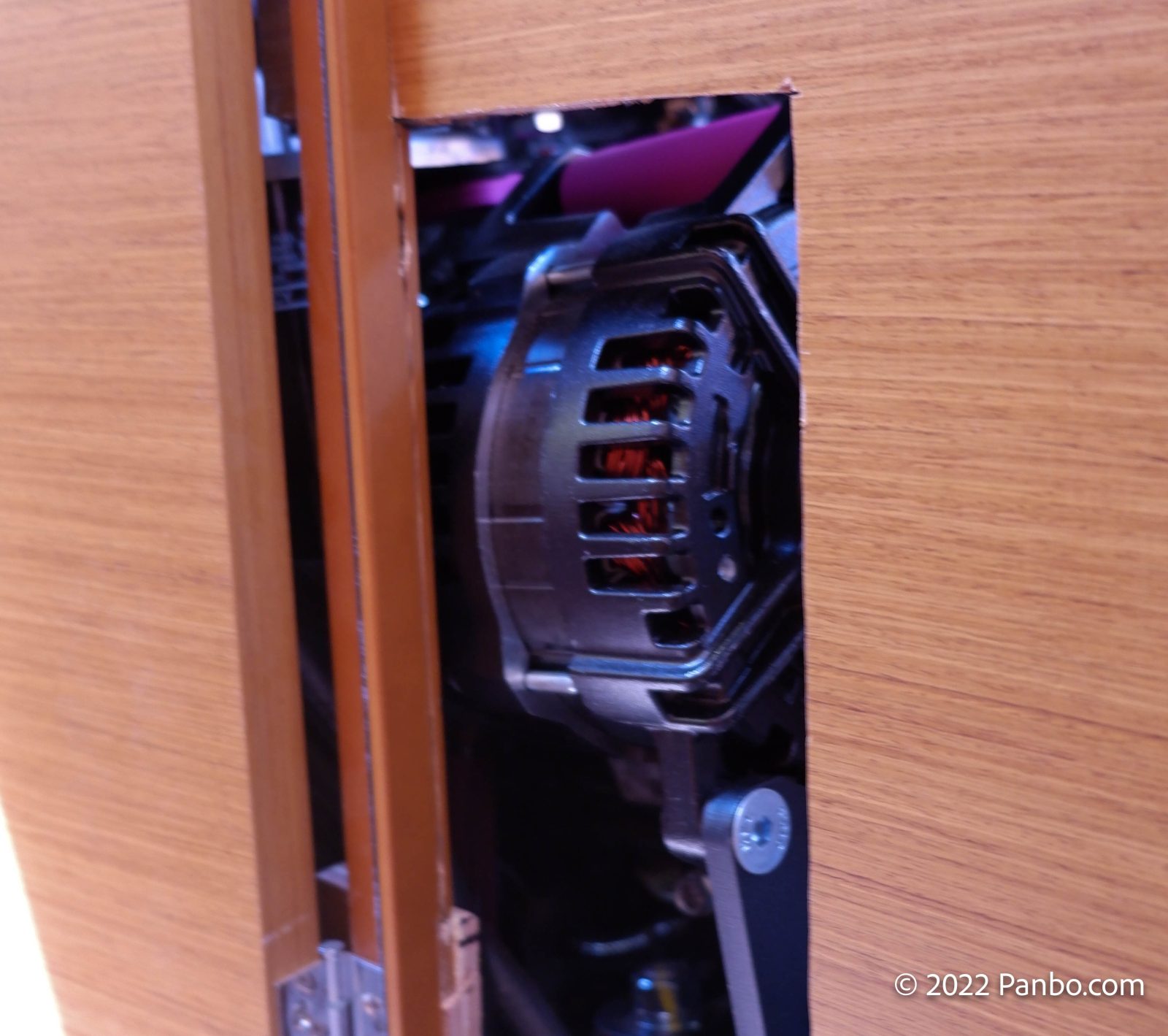
Fitting the large Integrel alternator into the engine compartment was a tight squeeze. In fact, it was so tight a hole had to be cut alongside the engine to make room for the alternator. The hole will get an access plate in the final stages of installation.
Air conditioning
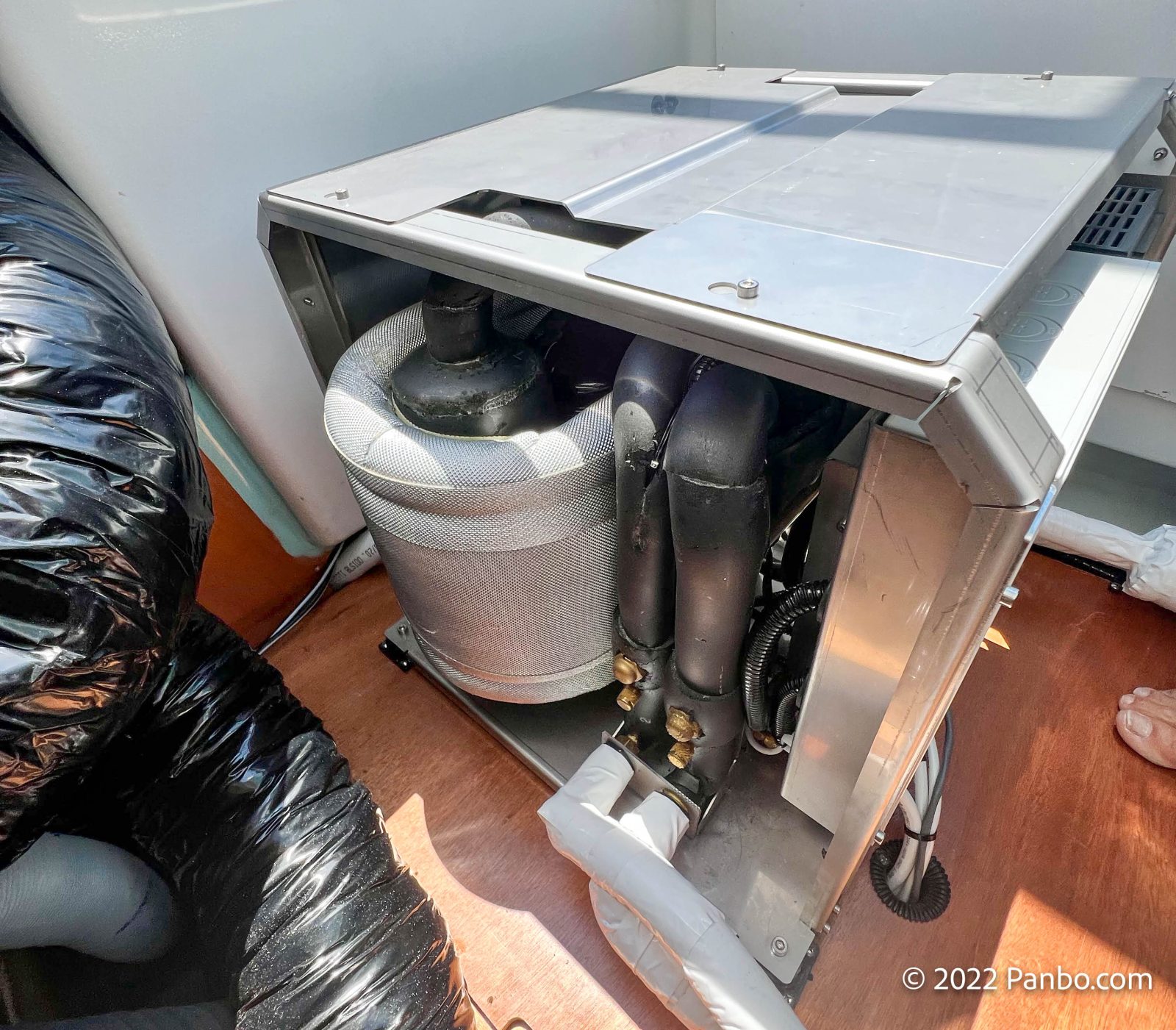
The biggest driver behind this entire project is the extended air conditioning run time powered by batteries. To do that, two things are necessary: a large battery bank and efficient air conditioning. But, more efficient air conditioning means smaller battery banks or longer runtime off of batteries.
BoatRX selected the most efficient air conditioning system in the market. Termodinamica’s Compressor Box and air handlers . Although Termodinamica relies on proven technology, they’ve put it all together in a way the marine market hasn’t seen before.
Variable capacity
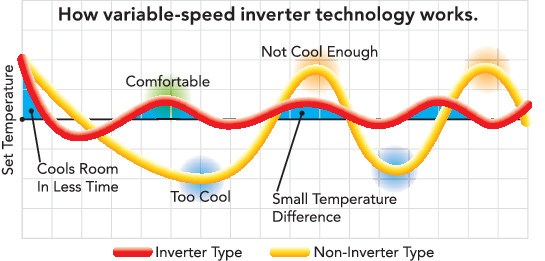
Combining a variable-capacity compressor with variable speed fans and a sophisticated control system deliver peak efficiency. The illustration above shows some of the benefits of variable capacity AC systems. Traditional, fixed capacity, AC systems are either on or off. As a result, they blast cold air until the set point is reached. Then, they shut off and let the room’s temperature climb until it’s high enough to cycle back on. Variable speed systems simply reduce the compressor’s speed to match the call for cooling. As a result, the room’s temperature is more consistent. Additionally, because the system runs consistently, humidity is more effectively controlled by being evaporated out of the continuously cooled air.
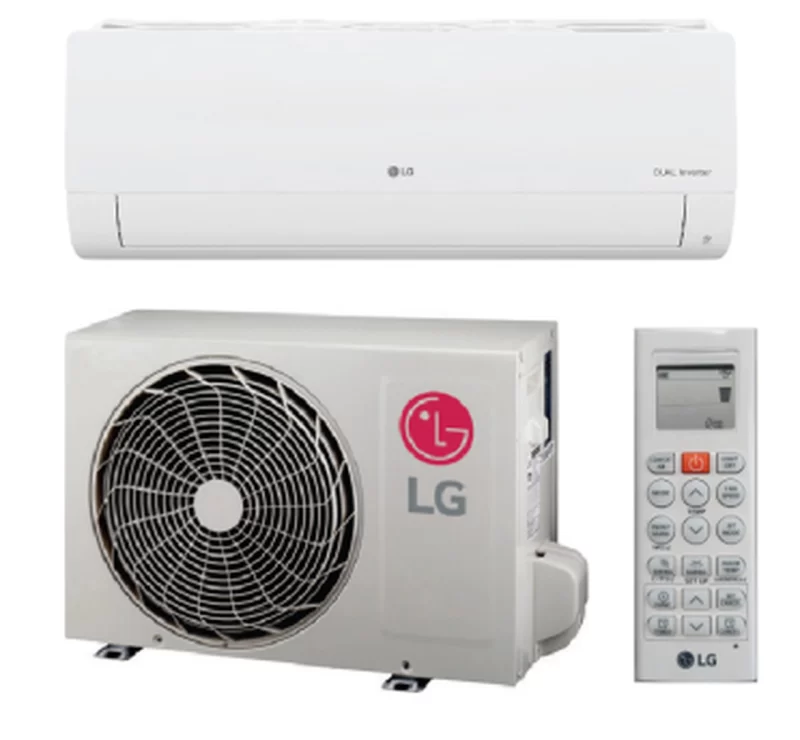
For many of us, our first exposure to variable capacity air conditioning systems was probably from a mini-split system. Most mini-split systems use variable capacity to deliver quiet cooling at just the rate needed to keep the space comfortable. Variable-capacity is also marketed as inverter or VFD (variable frequency drive) air conditioning. Inverter and VFD refer to the actual technology used to vary the capacity of the system.
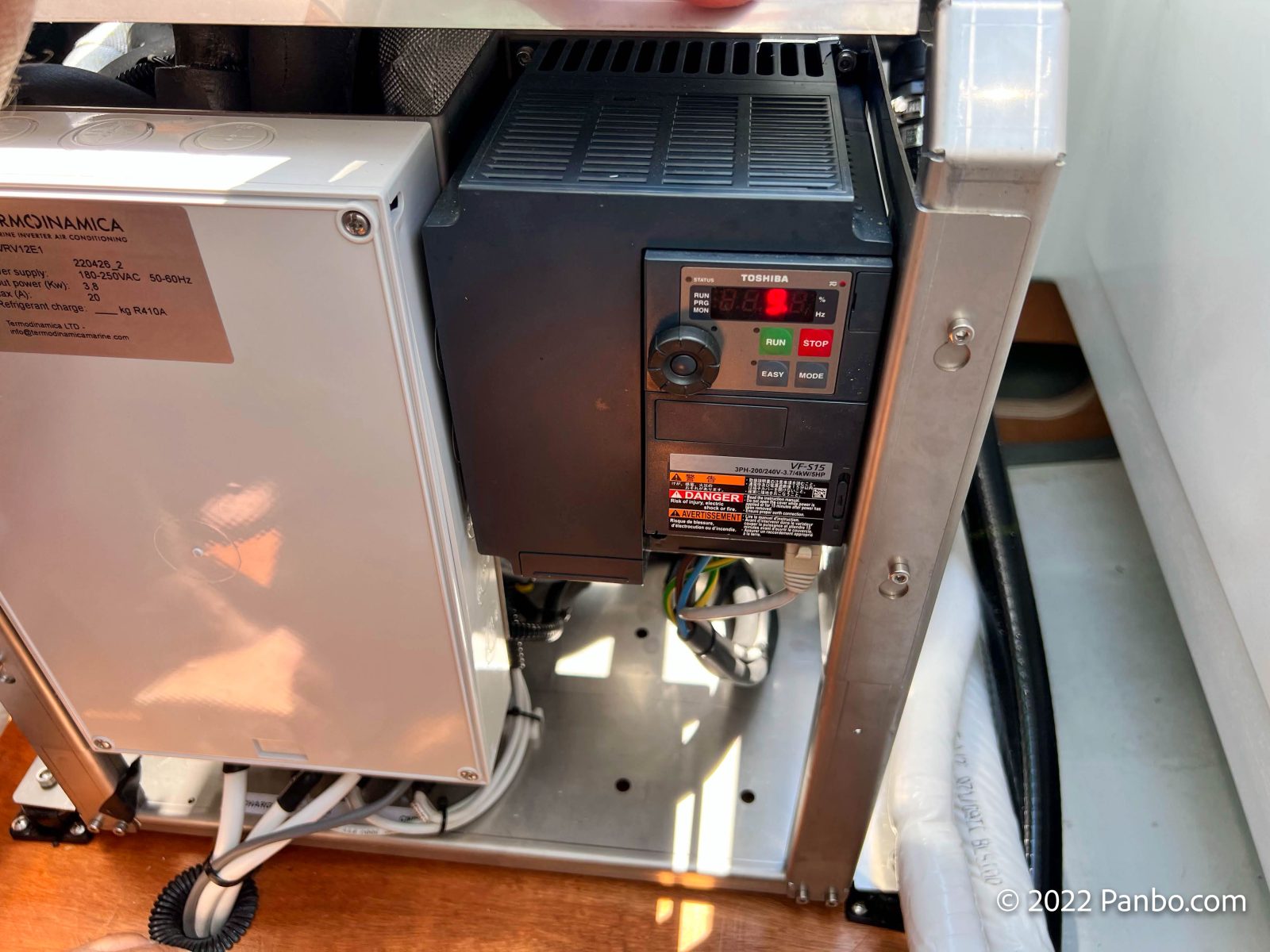
Termodinamica employs a variable capacity mechanism called VRV or variable refrigerant volume (often called VRF or variable refrigerant flow) to deliver carrying amounts of refrigerant based on the load. This is done by varying the speed at which the compressor runs. To vary the speed of an alternating current motor, you vary the frequency of the power. In North America, alternating current alternates at 60 hertz, or 60 times per second. To slow down an AC motor you slow the frequency with which the power alternates. An air conditioning compressor is essentially an AC motor, so to slow it down and hence reduce its capacity, we slow the frequency of the power. To do this, incoming alternating current is rectified to direct current (DC) and then inverted back to AC at a different frequency. Conversion losses are relatively small at each step, but it’s still likely that 10-15% of our power is lost to conversion.
In their marketing materials, Termodiniamica claims a minimum of a 50% reduction in power compared to traditional systems. We’ll see Cinnamon Girl’s results a bit later and can compare, but based on what I’ve seen, the claim seems accurate.
Distributing the cool
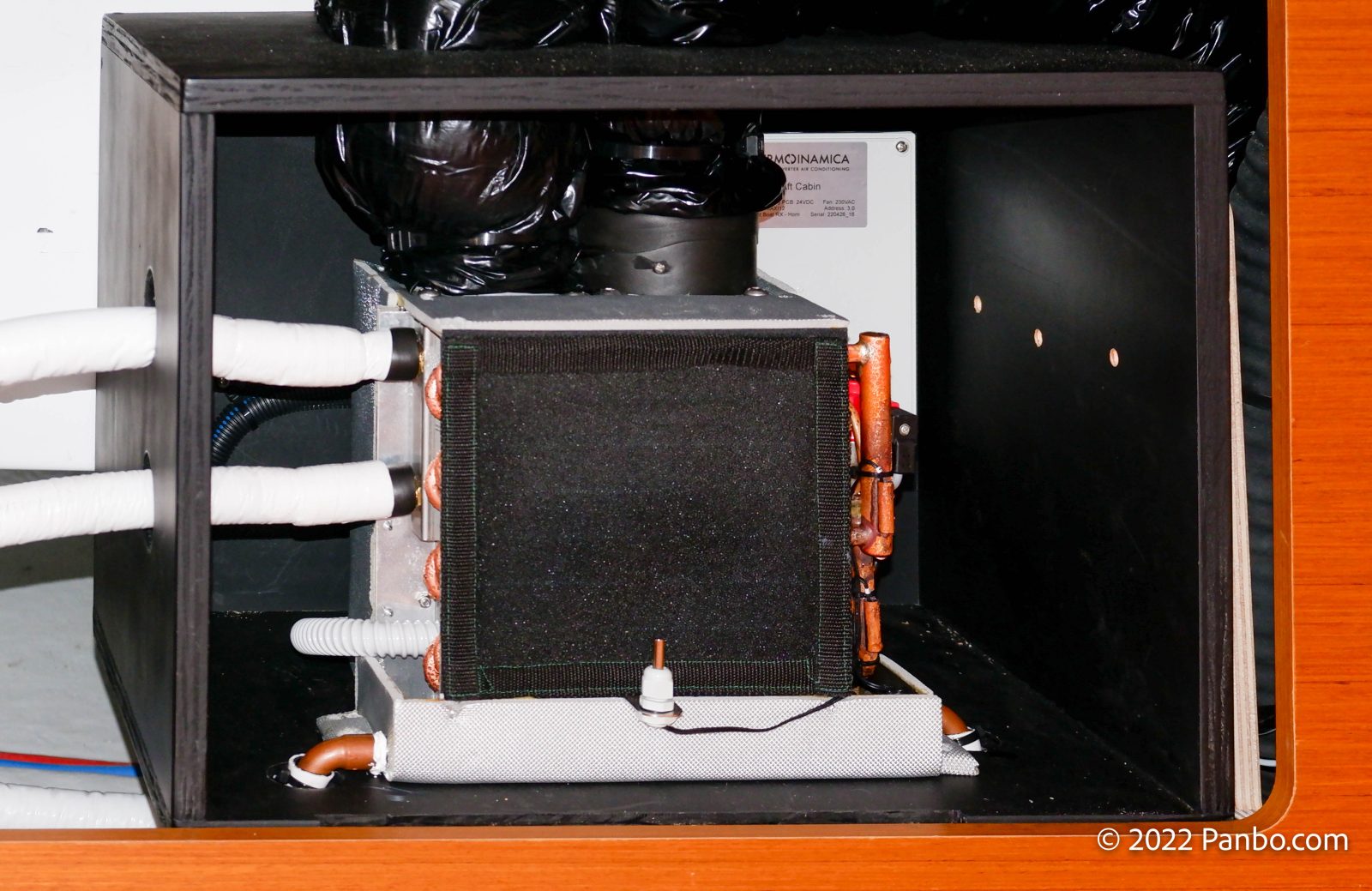
Now we really get into the heart of what makes the Compressor Box system different than what we’ve seen before. In concept, Have Another Day has a similar system to Cinnamon Girl . The compressors (or condensers) on Have Another Day are in the engine room while air handlers (or evaporators) are spread throughout the boat. But, my system lacks the flexibility and efficiency of Termodinamica’s. I have a 48,000 BTU compressor for my salon. That compressor serves two 24,000 BTU air handlers. It’s all controlled by one thermostat and when the thermostat calls for cooling, both air handlers run at full capacity. I can’t only run one evaporator at a time and I can’t run them at anything less than 100%.
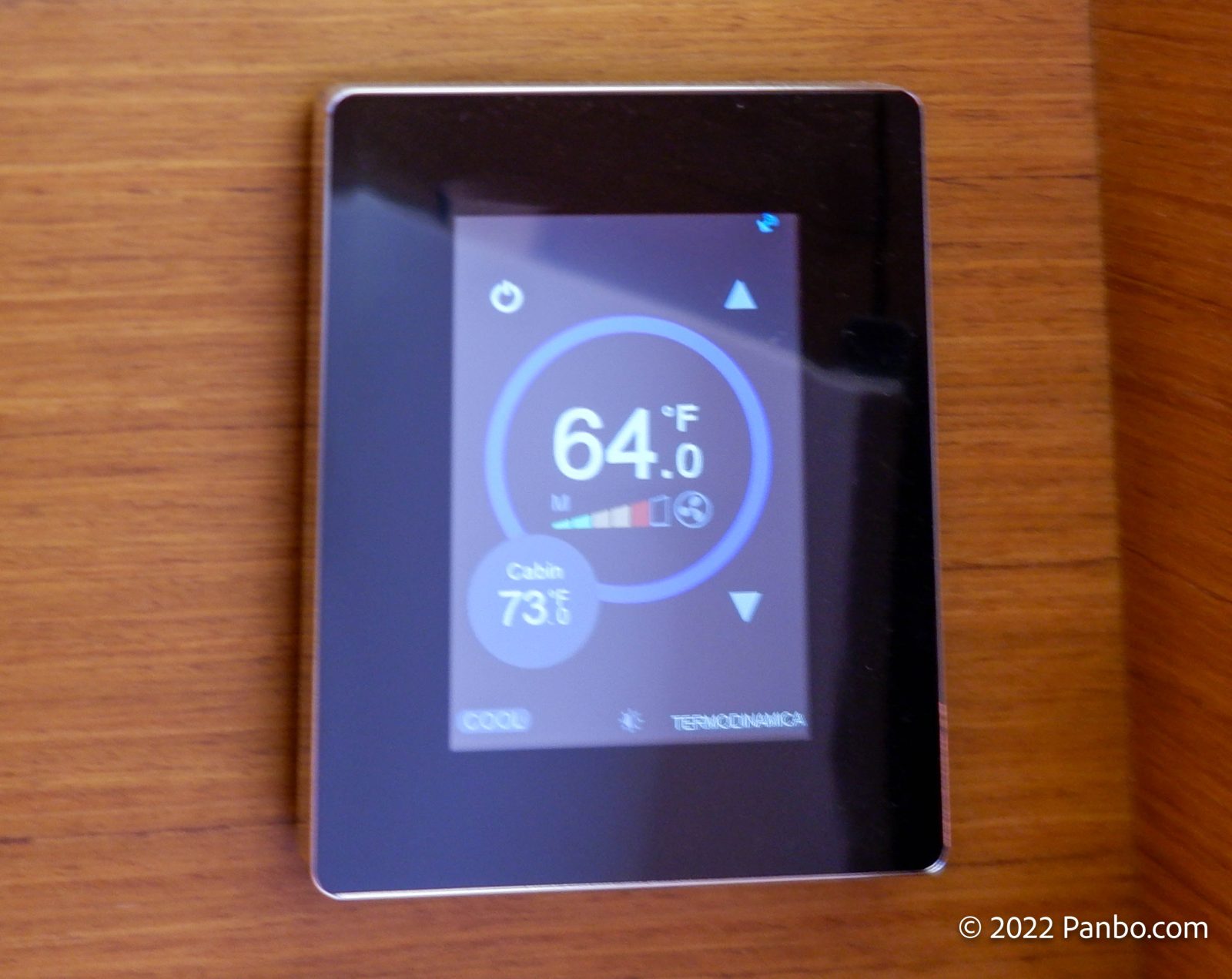
Each air handler has an electronically controlled expansion valve to precisely control the refrigerant that passes through the evaporator coil. There’s a control box connected to each air handler that controls the expansion valve and communicates the air handler’s cooling demand to the Compressor Box via ModBus.
Mix and match flexibility
The beauty of this approach is the flexibility it affords. If only one air handler needs cooling, the compressor will produce appropriate cooling for just that unit. The compressor’s ability to match its capacity to the demand from the air handlers affords flexibility in designing the system. If Cinnamon Girl had been ordered with air conditioning, it would have come with a 16,000 BTU unit in the salon. That unit would be sized according to well established formulas that deliver the best compromise of cooling capacity and humidity control. We are all programmed to think a bigger unit is inherently better, but that’s not the case with traditional air conditioners.
A larger unit may be able to reach your desired temperature faster. That sounds like a good thing, and for meeting your temperature requirements, it is, but much of the comfort we get from air conditioning is from cool dry air. Air conditioners dry the air by blowing warm, humid cabin air across cold coils. The humid air meeting the cold coils causes the water vapor in the air to condensate on the coils, drain down to the condensate pan, and be drained overboard. But, it takes a lot of air flow across the coils to drain all that humidity. If the desired temperature is reached too fast, the air will be cooled but not dehumidifier.
The variable capacity of the compressor and air handlers in the Termodinamica system mean that, within reason, the air handlers can be oversized a little. If it takes 16,000 BTU to cool and dehumidify the space most of the time, that’s where the system will run. But, if you’ve just returned to the boat on a hot day and the system has been turned off, additional capacity will be available to get rid of the excess heat quickly.
The flexibility capacity gives the system designer Lego like mix and match options. A boat could be outfitted, again within reason, with more air handler capacity than compressor capacity. Many boats’ use patterns suggest there will never be a time when all the air handlers will run at full capacity at the same time. So, if you know that stateroom systems only get turned on in the evening, when the salon system isn’t working hard, you can size the compressor box appropriately.
The Compressor Box supports up to five air handlers with its internal power supply. With an external power supply, the limiting factor will be the total cooling capacity of the compressor.
Precise control
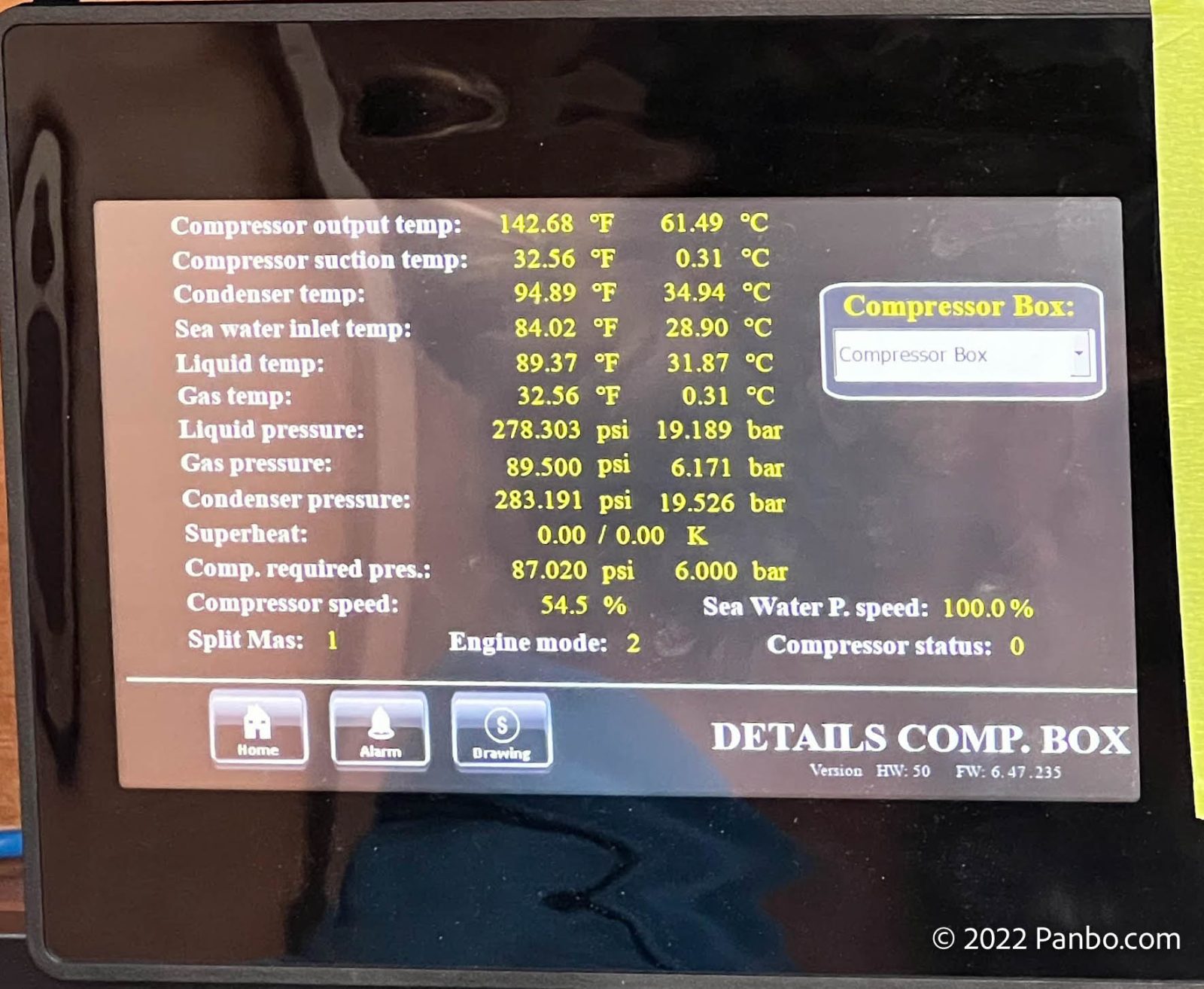
Termodinamica achieves its efficiency by precisely controlling the system’s operation. The fans in the air handlers have 250 speeds, the compressor speed is highly variable and all aspects of the system are monitored. Having spent too much time troubleshooting my own system, I’d love to have all this information at a glance.
Why 48 volts?
I’ve written a piece discussing the merits and downsides of a 48-volt DC system afloat. But, for this project, Integrel’s ability to rapidly recharge its 48-volt bank determined the voltage of the battery bank. In my other entry, I point to the architecture BoatRX used as the most logical based on 48-volt component availability. By using a split system BoatRX was able to take full advantage of the benefits of 48-volt while minimizing the downsides. Also, 48-volt is the foundation of Integrel’s capabilities. I don’t think there would be any chance of generating 9 kilowatts of power at 12 volts from a single alternator without massive cooling and a physically much bigger alternator.
Running the system
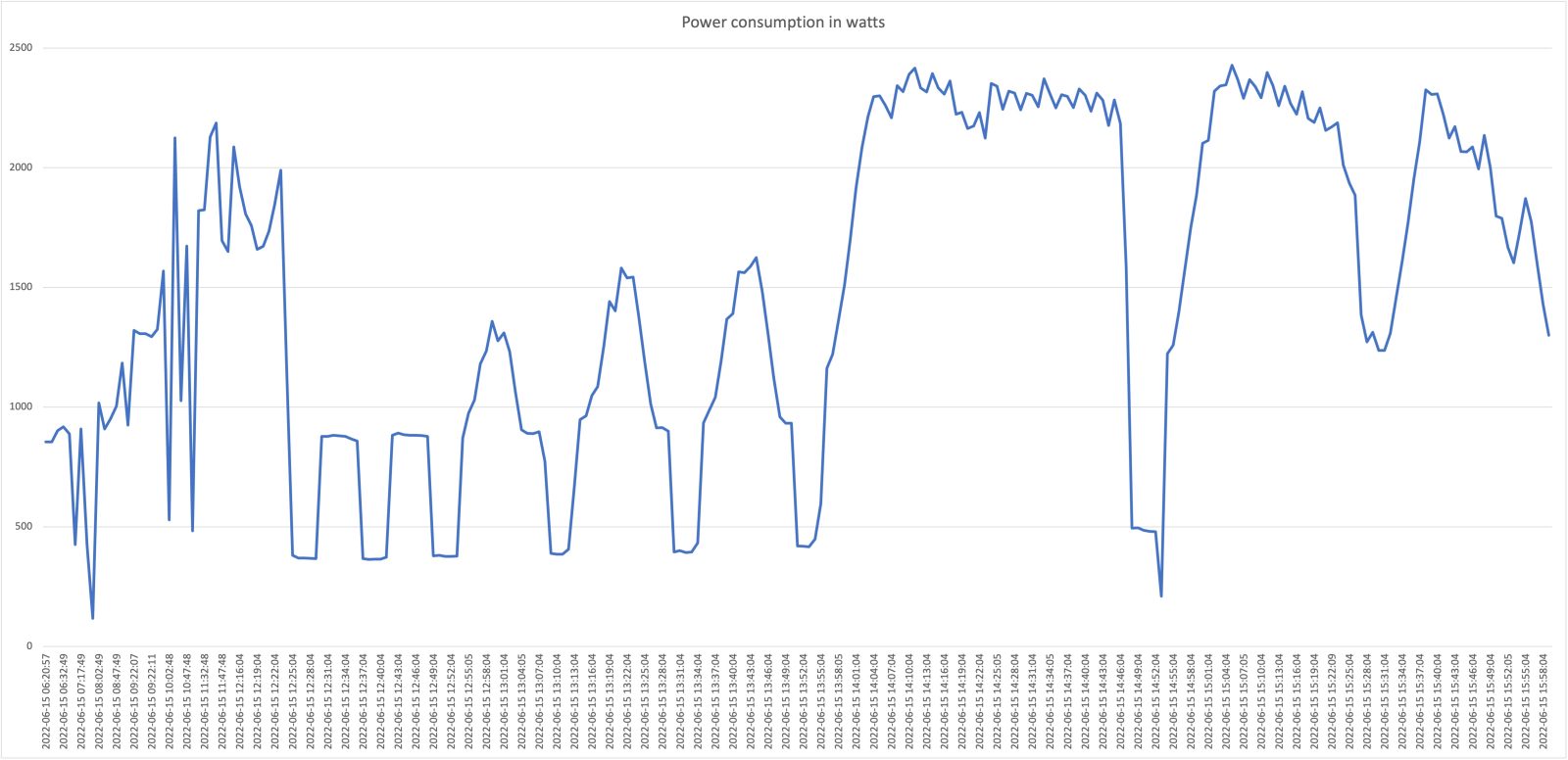
I arrived at Cinnamon GIrl well into the commissioning phase of the project. It was a warm and humid day on the Chesapeake, so I was quite happy the air conditioning was working. Coincidentally, the day I arrived the local power utility was doing work that required turning off the power at the marina. Fortunately, I was visiting a boat with battery-powered air conditioning. Between battery-powered air conditioning and all loads — except for the hot water heater — powered by the inverter, the loss of utility power was a non-event.
Efficient cooling
The graph at the start of this section shows power consumption through the inverter on the day I visited. This was measured and recorded via Victron’s VRM. The inverter feeds all loads except the hot water heater, so it’s a full accounting of all power consumption on the boat. Because there was a lot of commissioning work being done on the boat, the companionway door was opened frequently, which meant the air conditioning had to work harder. According to VRM, for the nearly seven hours I was there, the system average just under 1.5 kilowatts of power consumption.
Based on the 20-kilowatt battery bank, 1.5 kilowatts would give a total runtime for the system of about 13 hours if you discharge the batteries to zero percent. Or, just shy of 11 hours if you discharge to 20 percent state of charge. But, I was also there for the hottest part of the day and I was there before the solar installation was completed. The boat will be fit with 1,000 watts of solar. The beauty of solar as a power source for air conditioning is that the times when the most air conditioning is needed are also the times when the most solar energy can be harvested. Even just 3 kilowatts of solar will likely add a couple of extra hours of runtime to the batteries.
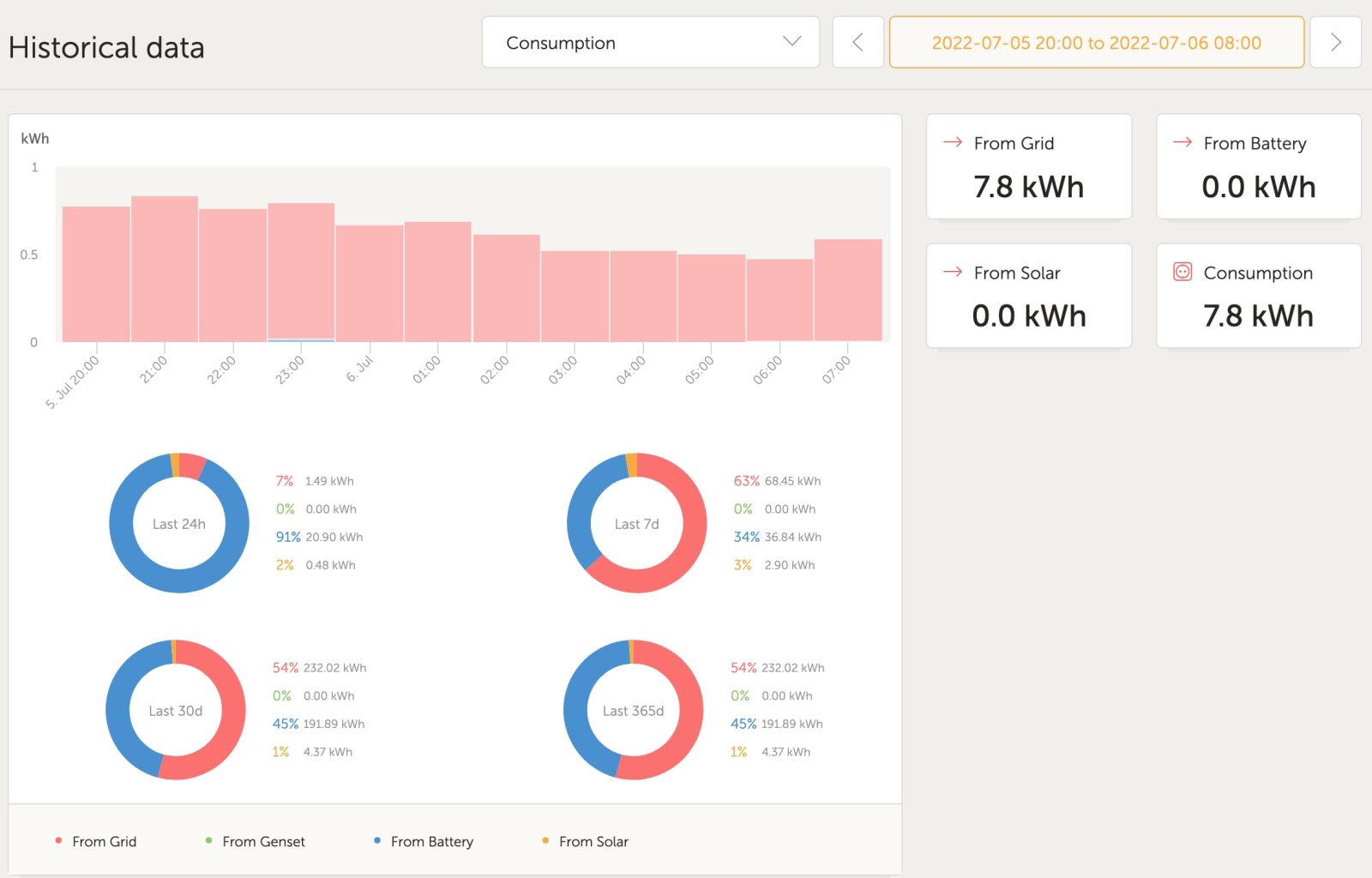
Remember, the owner’s original requirement was to be able to run the air conditioning overnight from battery power. Power usage overnight will be a fraction of the daytime totals. So, I think it’s very safe to say the overnight requirement will be a piece of cake for this system to meet. Indeed, three recent nights’ consumption, shown above, average just under 9 kilowatts of power consumption from 8 pm to 8 am. At that rate, and with the support of some solar production, it seems that 24 hours of runtime is within reach.
Massive power generation
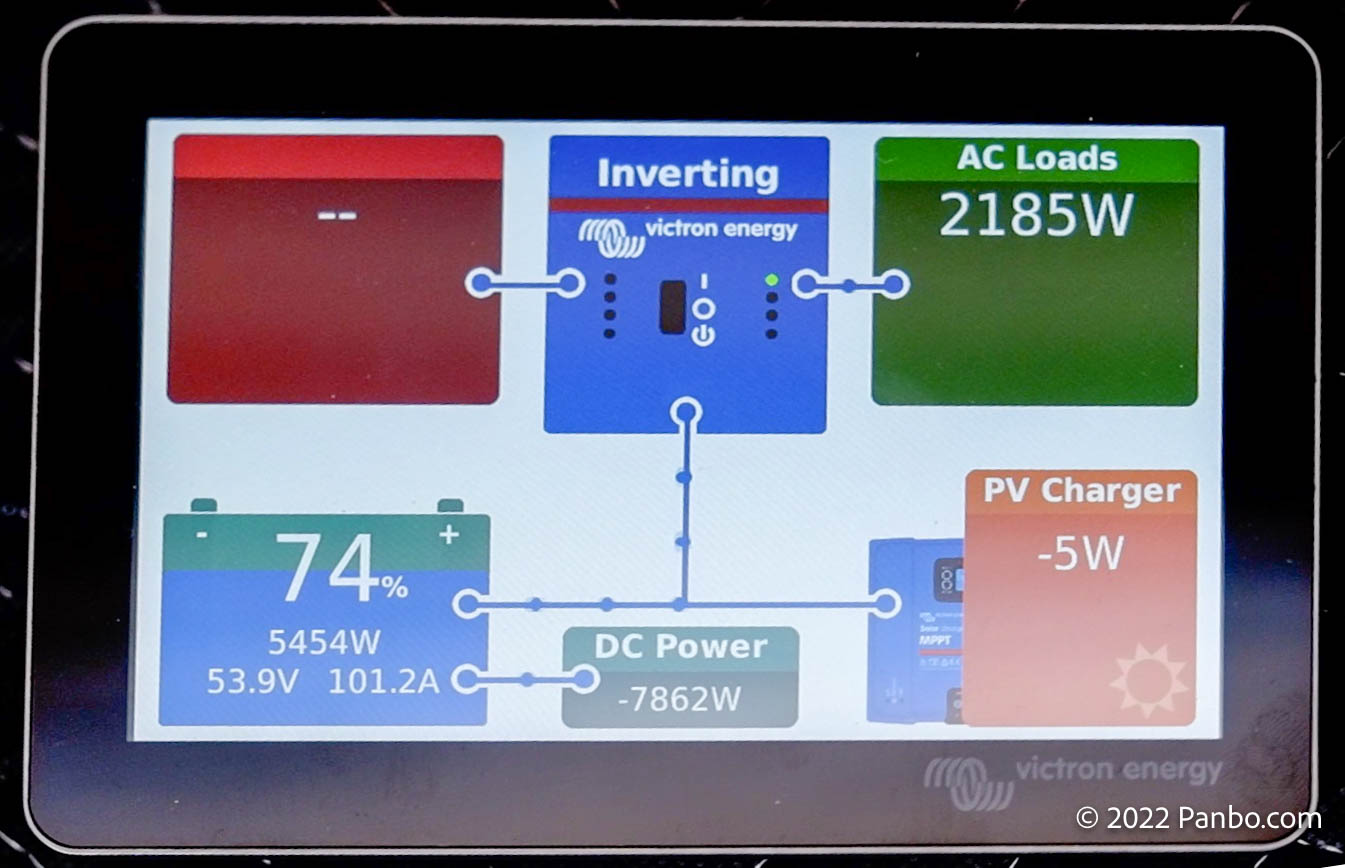
I realize that at first, the image above doesn’t look too odd, but the little box in the center bottom that reads “DC Power” has a huge number displayed. When this picture was taken, the engine was running at 1,600 RPM and Integrel was generating just short of 8,000 watts of 48 volt DC power. That’s a ton of power! Take a look at the battery icon on the bottom left of the image. The batteries are getting charged at 101 amps. But, remember, these are 48-volt batteries. That’s the equivalent of a 12-volt bank being charged at 400 amps.
The air conditioning was running while the engine was running and Integrel was charging the batteries. So, 2,200 watts of energy were going to power the air conditioning. If we’d turned that off, we could have dumped an additional 40-45 amps of charge current. With a 400 amp-hour or roughly 20 kW battery bank, Integrel is theoretically capable of charging a fully depleted bank in under three hours. The one caveat to this is that the Integrel alternator generates significant heat and the engine compartment is pretty small without a ton of ventilation. That means it is likely that Integrel’s controller will dial back the power production a little to keep the alternator cool.
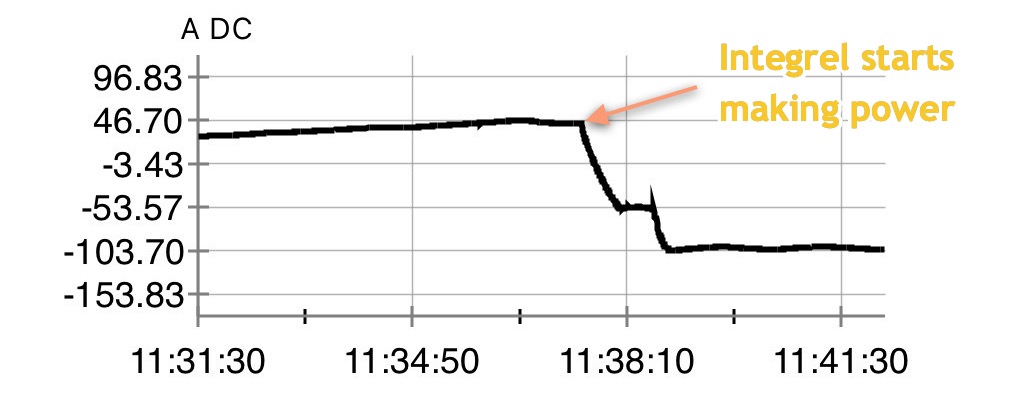
The numbers were so good coming from Integrel that I felt compelled to do a little independent verification. The chart above is from Fluke Connect, the measurement app my Fluke 376FC uses to record measurements. I put my meter on the main battery cables so I could measure all current in and out of the batteries. The chart shows power being consumed as a positive number. In this case, that was the air conditioning running, drawing just under 50 amps. Then, the engine is started and after a brief delay Integrel starts making power. That climbs to about 5 kilowatts of production — from just under 50 amps of consumption to 50 amps of charge — before engine RPMs are increased from about 1,000 RPMs to 1,600 RPMs and power production increases to a total of just under 150 amps.
Silent cooling and plentiful power
I spoke with the owner of Cinnamon Girl after he’d taken delivery of the boat and had the opportunity to use her on a few shakedown cruises. Our conversation made clear how satisfied he is with the boat and the systems. He reported that their first weekend on the boat they went a day and a half without shore power, running the air conditioning when they wanted, and still had 40 percent battery state-of-charge remaining when they returned to shore power. His only real lament was the lack of app-based control of the air conditioning system. On the other hand, he couldn’t say enough nice things about working with BoatRX. He was thrilled with the craftmanship of the work and the job they did making all these systems simply disappear into the boat.
Cinnamon Girl isn’t the first boat with air conditioning and she’s not the first boat built without a generator. But, she is the first boat I’ve been on with battery-powered air conditioning, ample battery capacity, and the ability to rapidly recharge her batteries. I’m going to be watching her VRM portal carefully to see how it works in real-world cruising, but I suspect the owner will rarely have to fire up the engine just to charge the batteries. Solar power generation and an hour or two of motor runtime should be all the boat needs to keep the batteries topped up and the cabin cool.
Related Posts:
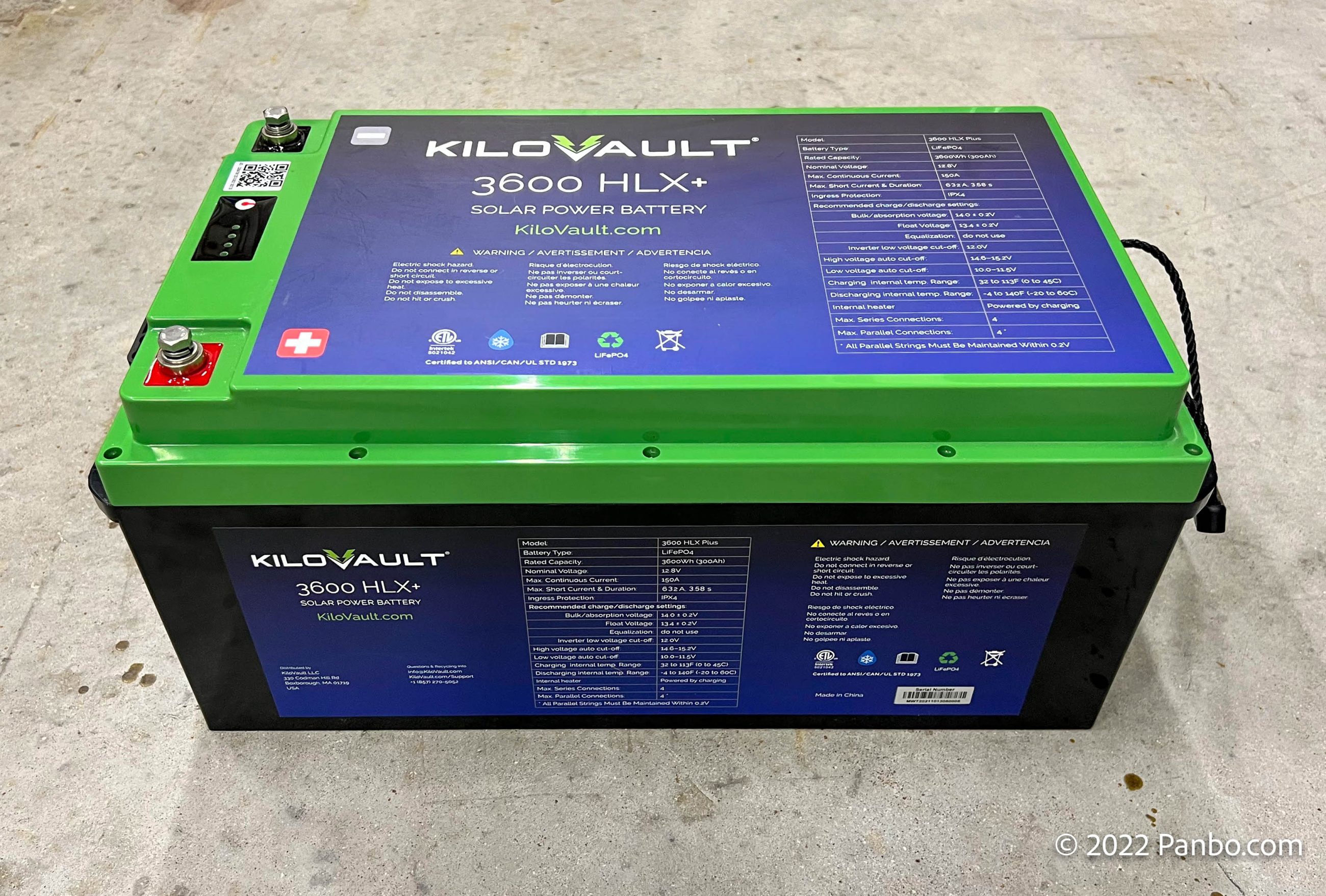
Publisher of Panbo.com, passionate marine electronics enthusiast, 100-ton USCG master.
9 Responses
- Pingbacks 0
Great article!
Good article and would be very interested in seeing a followup when the system has been used more. It would also be interesting to know the type of cruising the owner does as it appears that the system could support less than two days at anchor without firing up the main engine for about four hours to get back to 80% SOC. Did the owner have any rationale for only being able to run the water heater on shorepower?
Great article. I have a similar victron setup 12v. Can you tell me what the (dc power) represents? Thank you Clay
I think you’re referring to DC power in the picture of the Touch 50 towards the bottom of the article. If so, that figure represents the DC power the Victron GX (Cerbo on Cinnamon Girl) has calculated. It’s calculating this based on the points in the system it can measure. So, on Cinnamon Girl it can see how much power is flowing into or out of the batteries and how much power is coming from the solar controllers. But, there’s not a VE-connected meter on the output of the Integrel alternator. So, that’s calculated as part of the “DC System” and represented by that box. Incidentally, when that picture was taken, Integrel was generating power which is why the number is negative (and large).
Having worked in the background with BoatRx on this project (providing the Integrel), we at OPE can say that they are awesome installers!
Whether Integrel or other high-power alternator/regulator DC charging system, generator removal/replacement is becoming a popular option, and a growing percentage of our distribution business.
Note that these systems are generally not DIY installations. We highly recommend only having such systems done by an experienced installer like BoatRx!
..high tech over expensive systems that will require a 5 dwarf team of electrical engineers on board at all times to maybe keep it working.
Inspiring. Looking for smallest cost installation to be used for a smaller 24-30 ft sailboat.
I’d be very interested to know how BoatRX have overcome (assuming they’re aware?) the one major, and potentially catastrophic; issue with using Victron MPPT’s as DC-DC chargers?
Under certain circumstances, a Victron MPPT will deliberately short the PV input terminals to protect the battery bank.
This is completely safe if a solar panel is connected to the input, but not so with anything else.
This behaviour is documented here under Err 38 and 39:
https://www.victronenergy.com/live/mppt-error-codes
Can you please check with BoatRX and come back to me?
I reached out to Victron to understand this issue before I published this article. As you mentioned, in certain circumstances the MPPT can short its output terminals. Here’s what I learned:
If the output side stops accepting current rapidly (like a BMS disconnect event), the MPPT has to do something to stop the inbound energy flow. To do that, it will short the input terminals. If solar panels are connected to the input, that would just drop panel voltage to 0 and all would be fine. But, if the inbound source is a battery or other high current source, that won’t work. So, there’s an internal fuse in the MPPT that will trip in order to avoid bigger issues. Once that fuse opens, the unit is done, as it’s not economical to replace the fuse.
I asked about potentially providing overcurrent protection external to the unit so that when the terminals are shorted that overcurrent opens first. They thought that could work but the magic is in the timing of which overcurrent protection goes first. In my conversations, Victron didn’t know the size or blow speed of the fuse used on the boards so it might take some disassembly or experimentation to figure it out. It’s also not likely to be an issue unless there’s a shutdown event during charging.
Further, during my conversation I learned that Victron has plans to expand the DC-DC lineup with more 48-volt options (among others) but that the supply chain issues have consumed their product engineering resources in refactoring existing products for available components.
Join the conversation Cancel reply
Your email address will not be published. Required fields are marked *
Save my name, email, and website in this browser for the next time I comment.
Don't subscribe All new comments Replies to my comments Notify me of followup comments via e-mail. You can also subscribe without commenting.
Editors' Blog

David Burch wants to educate us about Electronic Navigation Charts (ENC)

Panbo(at) gets more stable: Seakeeper 1 install in progress

Epoch’s new 460 amp-hour, external communicating battery arrives and testing begins

METS 2023: EPT Technologies solid-state battery destruction demo

Gizmo’s new (though previously owned) compass, thanks to Max Marine Electronics
Join our list and be notified of new posts, subscribe to panbo.
Subscribe to Panbo to be notified of new posts and content
Press Releases

Recent Panbo Comments
Recent forum posts.
Interface HVAC with MFD
We are working on an electronics refit and in the proce...
By Trey Weitzel , 3 weeks ago
B & G Net Work Pilot auto pilot compass not working
Our B&G auto pilot compass is not working. It was w...
By Todd Young , 3 weeks ago
RE: Epoch 460 battery
What does “awaiting moderation” mean? Did I break a rul...
By Jim Duke , 4 weeks ago
I made a previous request to Ben which may have gotten ...
By Jim Duke , 1 month ago
I think this is a fine place for it and comes with the ...
By Ben Stein , 1 month ago
Epoch 460 battery
Ben, The comments on your Epoch 460 article is gettin...
Better Sailing

Air Conditioning on Boats: Tips and Things to Consider
One of the great advantages of sailing is sensing in-depth some of the elements of nature, which are wind, and water. From that point of view, climate control is somehow opposite to sailor’s art. However, we humans are looking for practical ways to provide ourselves some comfort, especially when traveling aboard a sailboat. So, if you’re a beginner (or even if you’re not), it is somehow difficult to make the transition from the landlubber life to tropical climates. Therefore, the idea of air-conditioning, despite its huge power demands can be appealing. So, let’s see what it is like to have air conditioning on your sailboat, as well as some of the best sailboat air conditioners.
General Information on Air Conditioning
Nowadays air-conditioners are manufactured way lighter and power-efficient than they were ten years ago. However, buying an AC Unit for your sailboat might be an expensive purchase, and sometimes regarded as high-end items on most sailboats. The cost of a professional installation on a 35′ feet sailboat can be as much as putting in new sails. Whenever you are investing that much money on a piece of gear, one question comes to your mind. How long will it last? However, they are important in terms of ensuring an enjoyable sailing experience. With a dependable air conditioner, your boat will be cool, comfy, and air will circulate in it, which is essential in order to prevent mold.
In general, when you’re sailing during the summer season then this means that you’ll have to deal with different kinds of temperatures. For example, in the north, it might have 95 degrees Fahrenheit and humidity that’s close to 90%. Everything is possible when you sail in extreme climates. Moreover, some days might get really cold at night or during winter, thus you have many reasons to have a solid sailboat air conditioner installed on your boat. Last but not least, keep in mind that portable air-conditioning units cost less than fixed units.
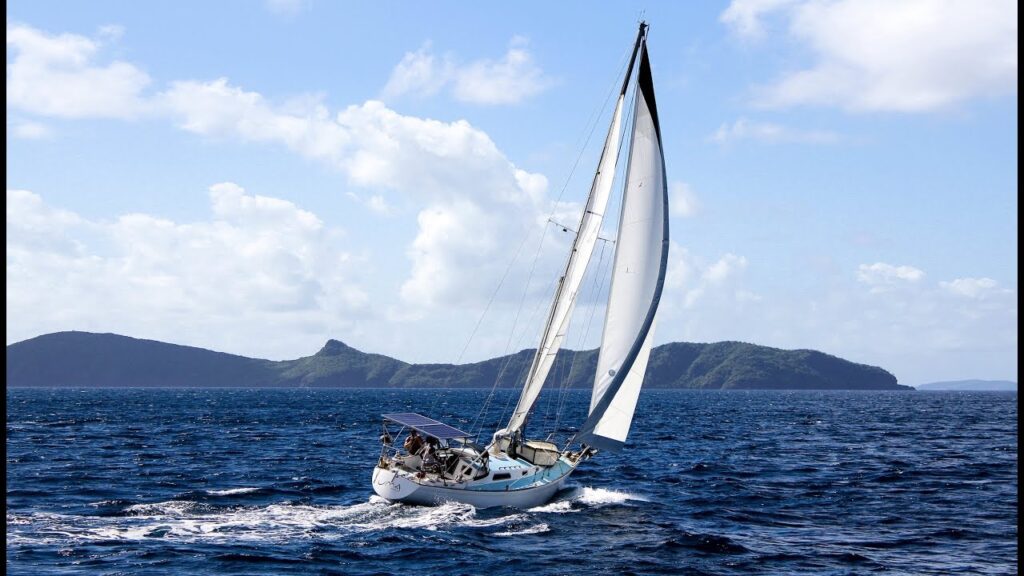
Things to Consider when Buying a Marine Air Conditioner
- Avoid models with a single-hose: They draw cooling air only from the inside, thus they exhaust hot air out through a duct. The air within the boat is usually warmer and more humid than the outside air. Therefore, this can reduce cooling efficiency by as much as 50 percent.
- Cooling Distribution: The distribution of the air within the cabin can be aided by fans, but it will always be unbalanced. However, with air being installed, vents can take the air wherever you want it. It is important that the area of the supply vent inlets is distributed within a recommended range. If a vent is too small then there will be no efficiency. But, if the inlet area is too big, the flow of the cooler air is going to minimize.
- Size of AC Units: Nowadays manufacturers design modern Air Conditioners with the aim of providing easier installation, set up and lightweight products. The right AC Unit means the one that can efficiently cool or warm the entire boat without struggling. Keep in mind that the larger your sailboat, the more powerful the air conditioner system will need. You might also need some space for an engine room if you choose a split air conditioning unit.
- Noise: A permanently installed air conditioner runs on seawater instead of air cooling, thus reducing the noisy cooling air fan required of all portable units. Most of the AC Units are noisy, so before buying or installing a new AC, always think about this feature.
- Maintenance: The portable AC units only require an annual air filter cleaning. However, a permanent, central air conditioner requires raw water strainer cleaning, every 8 to 100 hours, depending on the amount of seagrass in the water. These units also need an external strainer that has to be checked for blockages, especially in high fouling areas.
- Power Requirement: Now, let’s see an example. The AC portable Unit Pompanette 6,000 BTU draws 17 amps to start and 6.9 amps running. The Dometic Turbo 10,000 BTU draws 14.5 amps in order to start and 6.7 amps running. Obviously, the Dometic unit is the most efficient, which means lower power bills, but also reduced complexity when installing. Generally speaking, your sailboat must have powerful battery banks and inverter, as well as an efficient source of energy like a boat generator or a solar panel.
- Your Plans and Budget: Weather conditions generally affect the way that your AC unit is working. In case you are sailing in hot climates then the unit will work a lot harder. So, the sailing ground you’re traveling to and its weather condition will determine the appropriate British Thermal Unit that you need. As mentioned before, sailboat air conditioners can be costly, so calculate how much you can afford, according to your budget.
Best Marine Sailboat Air Conditioners
- MarinAire 16000 BTU : Constructed with lightweight materials it’s undoubtedly a top-quality sailboat AC Unit, designed with built-in pressure gauges. Moreover, it has a D-Smart control system, with a 360-degrees blower outlet, start-up current, and low energy consumption. All these features make it the almost perfect choice for anyone. Buy from Amazon .
- Dometic Turbo DTU 10 10,000 BTU : This unit is quiet and efficient. Moreover, its very low power draw is a big plus and allows to stay at marinas with modest power supplies. However, its installation might be complicated but you can either do it on your own, either hire a professional. Options on Amazon .
- WeBasto AC Retrofit Unit : This AC consumes approximately an average of about 8.5 amps at 115 volts, and it is quite affordable with an easy setup and installation. Its compressor is very quiet and doesn’t generate any irritating noise. Link to Amazon .
- Pompanette 6000 : This unit has an integral insulated compressor shield and it is designed with a uni-body construction. Furthermore, it has a small size and it’s quite affordable. It can never rust and it doesn’t accumulate condensed water or bacteria.
- MarinAIre 11000 BTU : This eco-friendly AC Unit is definitely a reliable solution. It does everything automatically and comes with excellent low and high-pressure gauges. This feature ensures that it operates efficiently in all climates.
Air Conditioning on a Sailboat – Final Thoughts
I know that nothing is more comfortable than having a reliable air-conditioner on your sailboat, in order to adjust yourself to climate’s alterations. Therefore, this investment, though sometimes can be costly, can satisfy your needs for a long-term period, while traveling overseas. Moreover, a sailboat air conditioner will adjust the humidity level, temperature, and airflow in your sailboat. Nowadays, there are a lot of sailboat air conditioners on the market. To sum up, air-conditioning is necessary for some people while for others is just a commodity. Keep in mind to check the market, calculate your budget, your sailing plans, and all the above-mentioned details of your preferred AC Unit, before making your purchase.
Peter is the editor of Better Sailing. He has sailed for countless hours and has maintained his own boats and sailboats for years. After years of trial and error, he decided to start this website to share the knowledge.
Related Posts

Sailing with Friends: Tie Knots, Navigate the Seas and Create Unforgettable Memories

The Ultimate Guide to Choosing the Best Fishing Line for Trolling

Lagoon Catamaran Review: Are Lagoon Catamarans Good?

Best Inboard Boat Engine Brands
- Buyer's Guide
- Destinations
- Maintenance
- Sailing Info
Hit enter to search or ESC to close.
- Frank Magazine
- Denison History
- Virtual Tours
- Alaskan Yachts
- Azimut Yachts
- Back Cove Yachts
- Beneteau Yachts
- Benetti Superyachts
- Bertram Yachts
- Boston Whaler
- Broward Yachts
- Buddy Davis Sportfish
- Burger Yachts
- Cabo Yachts
- Carver Motoryachts
- Center Console
- Chris-Craft Yachts
- Cruisers Yachts
- DeFever Trawlers
- Dufour Sailboats
- Fairline Yachts
- Feadship Yachts
- Ferretti Yachts
- Formula Yachts
- Fountaine Pajot Cats
- Grady-White
- Grand Banks Trawlers
- Hargrave Yachts
- Hatteras Yachts
- Hinckley Picnic Boats
- Horizon Yachts
- Hydra-Sports
- Intrepid Boats
- Jarrett Bay Sportfish
- Jeanneau Yachts
- Kadey-Krogen Trawlers
- Lazzara Yachts
- Luhrs Sportfish
- Marlow Yachts
- Maritimo Yachts
- Marquis Yachts
- McKinna Motoryachts
- Meridian Yachts
- Midnight Express
- Mochi Craft
- Neptunus Motoryachts
- Nordhavn Trawlers
- Nordic Tugs
- Ocean Alexander Yachts
- Offshore Yachts
- Oyster Sailing Yachts
- Pacific Mariner Yachts
- Palmer Johnson Yachts
- Pershing Yachts
- Prestige Yachts
- Princess Yachts
- Pursuit Yachts
- Riva Yachts
- Riviera Yachts
- Sabre Downeast
- San Lorenzo Yachts
- Sea Ray Boats
- SeaVee Central Consoles
- Selene Trawlers
- Scout Yachts
- Sunseeker Yachts
- Tiara Yachts
- Trinity Superyachts
- Viking Yachts
- Westport Yachts
1st DC Powered Air Conditioner On An Oceanis 30.1 Sailing Yacht
The best way to beat the heat on a sailboat..
Sailing is one of the most authentic forms of boating. The earliest record and detailed description of a boat with sails dates back to the ancient Egyptians during 3,000 BC. Egyptian boats commonly featured sails as well as oars. Then the Greeks, Phoenicians, Romans, Vikings, and Europeans adopted their own versions of a sailing boat. Overtime, sailboats became a fundamental invention in human history — pivotal in migration, trade, and warfare.
We’ve come a long way since the ancient Egyptians, but sailboats always seem to keep their character. They’re simple structures that can take you around the world. Although, cruising in a sailboat means sacrificing a few luxury comforts that some boat owners may take for granted.
Finding A Solution To The Heat

During the Miami Boat Show in February 2020 , a Denison client bought a Beneteau Oceanis 30.1 . It has 2 staterooms, 1 head, no generator, and no AC. The client fell in love with the boat as he started using it in South Florida. Then he slowly began to realize how hot the vessel got without an AC unit. As many sailors know, it can be impossible to escape the heat on a sailboat.
The client contacted Denison’s Service division to find a way to make sailing on his Beneteau Oceanis 30.1 a more comfortable experience for him and his family. So Denison Service team member, Brian Clemens installed an ac unit that’s one-of-a-kind.

How It Works
It’s a powerful system in terms of cooling without a generator, saving you weight, space, maintenance, heat, and fuel consumption. The 12000 BTU 12-volt air conditioner runs off a separate lithium battery bank with 750 amp hours total. It can run 16 hours (continuously) on batteries alone, giving you up to two full nights of cool and comfortable sleep without running the engine.

This particular Oceanis 30.1 can replenish the batteries dockside, using shore power or the main engine (which has a 125 amp hour alternator that can charge the lithium batteries via a 12-volt-through-12-volt converter).

Reviewing The AC System
When Denison yacht broker Jeff Erdmann heard about an Oceanis 30.1 with a DC powered air conditioner, he had to see it for himself. He brought a camera, a thermometer, and his passion for boats with him to inspect a 1200 BTU 12-volt air conditioner installed onto a 30-foot sailboat.
“The first time I saw the install, I told Brian that this was a superyacht quality installation on a 30 footer,” Erdmann said when asked about the new installation. “It’s whisper quiet and ice cold.”

To the best of Denison’s knowledge, this is the first DC air conditioning installed on a sailboat. When asked how much the installation cost, Erdmann gave a sly smile.
“Priceless, in relation to your comfort onboard the boat.”

These Denison clients are taking the joys of sailing to the next level. Where will this upgraded Beneteau Oceanis 30.1 travel to next? They’ll possibly sail along the east coast of Florida, down to the keys and into the Caribbean. With that kind of sailing comfort, you can go anywhere.
Ready to find your next dream sailboat? Contact a Denison yacht broker to get started.
Latest News

NEWS | April 12, 2024
2024 seattle boats afloat spring show.
2024 Seattle Boats Afloat Spring Show Denison invites you to view a number of available new and brokerage boats at the 2024 Seattle Boats Afloat Spring Show. Since its inception in Seattle in 1978, the Pacific Northwest’s largest floating boat show, the Boats Afloat Show, has consistently drawn

NEWS | April 10, 2024
High-end tenders: the tender touch.
High-End Tenders: The Tender Touch There are few more exciting (and competitive) sectors of the yachting market today than high-end tenders. This article was written by Kevin Koenig. Photography courtesy of the manufacturers. I’ll admit I’ve been a little bit obsessed with tenders as of

88 Riva 2022 Sold by Drew Offerdahl [BEL SOGNO]
88 Riva 2022 Sold by Drew Offerdahl [BEL SOGNO] BEL SOGNO, a 88′ Riva built in 2022 was sold by Drew Offerdahl, who represented the Seller. Chris Coughlin with Allied Marine introduced the Buyer. BEL SOGNO contains a four stateroom, four head interior layout featuring an abundance of natural
Sailing yacht air conditioning
Fun in the sun is great, but nothing says comfort like high-quality air conditioning when you want to get out of the heat. Our sailing yacht air conditioning systems assure you of exactly the right temperature, humidity level and air flow to experience the highest level of comfort onboard. By controlling the humidity level inside the sailing yacht, the interior and equipment stay in good shape as well.
As unnoticeable as possible
Our air conditioning systems for sailing yachts are completely custom-built in order to meet the client’s desires and technical requirements. Taking into account the proposed area of operation, yacht layout, desired target temperatures, number of occupants, construction materials etc. we design a system that exactly fits your needs. Our AC systems are perfectly integrated in the yacht’s design, whisper-quiet, draught-free and vibration-free to make them as unnoticeable as possible.
Contributing to sustainability
In our quest to more environmentally-friendly alternatives for traditional HVAC technology, we are constantly researching and developing energy-saving solutions for our customers. By decreasing the HVAC system’s power consumption through recycling energy and smart design we offer our customers more sustainable options that help them safe money on fuel costs as well.
Contact our sales, service or spare parts teams directly

Boating Basics Online is reader-supported. When you buy via our links, we may earn a commission at no cost to you. Learn more
The Best Marine Air Conditioners for Boats & Other Marine Vessels
Written by J. Harvey / Fact checked by S. Numbers
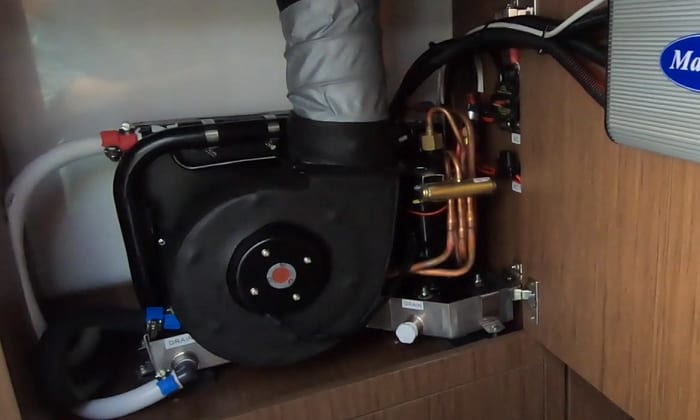
Having the best marine air conditioner is beneficial for the entire boat and the people on it. The even temperature movement from any boat AC unit and other self-contained units of a marine AC influence boating results.
Getting the right boat AC system starts with knowing the answer to, “How do you size a marine air conditioner?” Here are other essential features, factors, and FAQs about marine air conditioning systems for your reference:
- Boat Sizing and Layout – These are important when choosing the top-rated marine air conditioners or specific portable boat air conditioner. Decide wisely which marine air conditioner or portable marine air conditioner to buy. Measure the square area you like to get cooled to know the load factor. Include insulations, sunlight exposure, windows, height, and other factors for a large or small boat air conditioner.
- These refrigeration factors help determine the desirable British Thermal Units (BTUs) or power draw for the entire boat, which influences the needed cooling power of the entire boat hatch from your energy-efficient marine air conditioners.
- Ease of Installation: This relates to the practical cost of installing your boat hatch air conditioner. The easier you install it, the better to plug, play, and relocate like a portable AC for boat does.
- Installation for a portable boat AC, a 12 volt boat air conditioner, or a marine air conditioner 16,000 BTU varies. They’ll likely need specific wiring, plumbing, ducting, and location aspects that may be handy, mild, or complex to install.
- Mount your marine air conditioner units properly for good refrigeration cycle or return air to and from the cooling units. Ensure the marine air conditioners have proper ducting, discharge options, and enough space to ease their maintenance servicing.
- Power Supply: All marine air conditioners run on an alternating current or AC power source. They range from a 12v marine air conditioner to a larger 230-volt cooling performance with 3-phase compressors.
Check the manufacturer’s specifications of a marine air conditioner brand for recommended amperage, wiring, and circuit breaker sizes.
Read these reviews to get your most efficient marine air conditioner.
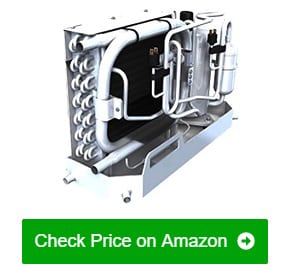
- Comes with a chiller unit
- Low fuel consumption
- Durable construction
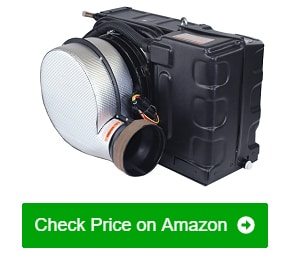
- Easy to install
- Low start-up current
- Best works with boats and yachts
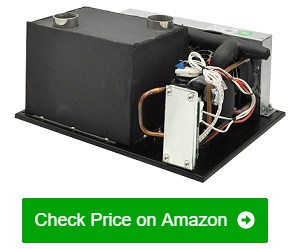
- Power-saving
- Portable and lightweight
- Ideal for small rooms and spaces
Table of Contents
1. Webasto 5011396A Air Conditioner Retrofit
2. marinaire marine ac and heat pump, 3. campelify 1910e-ac compact air conditioning, 4. dometic 207500310 envirocomfort retrofit, 5. black+decker bpact10wt portable ac, factors to consider when choosing marine air conditioners, how many watts does a marine air conditioner use, how long do marine air conditioners last, how do you maintain a marine air conditioner, how do you size a marine air conditioner, top 5 marine air conditioner reviews.
Among all the Webasto marine air conditioners (ACs), this self-contained AC retrofit unit is the first bestseller. Boaters love this sailboat air conditioner model that comes as a platinum series with a chiller unit for optimum performance.
The 5011396A marine air conditioning system has a cooling output of 115 volts/60Hz producing 10,000 BTU. It features a reverse cycle heat marine AC with quiet operation and a robust design that is solidly built and economical.
This self contained marine AC unit works best as a new installation or replacement and upgrade of an entire unit. The square-sized kit has a compressor compartment, condenser, evaporator, remote thermostat, and controller for a quiet operation.
I love the AC kit’s performance among big air conditioners with superior velocity blowers. The velocity blowers are durably built, comes with instructions, and complete with product information and materials for solid cooling results.
It’s a digitally and remotely programmable thermostat providing ease of operations, monitoring, and noise reduction. I can attest that these boat air systems work as one of the top-tier marine air conditioners in the market.
- Low fuel consumption/maintenance, and solid cooling results
- Well-designed and durable construction for a hassle-free installation
- Affordable and best marine AC system for a quieter operation
- Comes with a chiller unit for an optimized performance
- Excellent velocity rotatable blowers and remote thermostat control
- The square-sized air conditioner system may be difficult to retrofit
Another bestseller on our review is a compact size marine air conditioner and heat pump manufactured by MarinAire. It is really easy to install and provides outstanding cooling and quieter operation like a portable marine air conditioning unit.
I‘ve been using this 110-120 volt and 60-hertz contained marine air conditioner for over 2 years. This Integra model is easy-to-install with built in pressure gauges for better operations using its D smart control system. The digital control features help the configuration and setup of the remote temperature sensor. It is a very good small marine air conditioner unit that works with limited cabin enclosures and tiny boat spaces.
The marine AC unit has a low start-up current or low energy consumption even at higher cooling temperatures. The high-velocity rotatable blower of this boat air system works well when adjusted for any 360-degree cooling position. It comes with a compressor sound cover for noise reduction, stainless steel drain pan, and an environment-friendly R410A refrigerant. Hence, it is great as a 16000 BTU self contained marine air conditioner and heat pump 115v60 system.
- Self-contained marine air conditioner and heat pump with low start-up current
- Easy to install and monitor with rotatable blower and built in pressure gauges
- D-smart control system for better performance monitoring
- Compactly built with stainless steel drain pan and compressor sound cover
- Limited for use on boats and yachts and not designed for vehicles and home use
Check this 12v marine air conditioner review for a compact air conditioning system with a mild cooling capacity you’ll like. It comes with a DC mini-rotary compressor that is ideal for boats, camper vans, vehicle chiller’s, and refrigeration cooling systems.
This portable AC unit has a versatile, compact cycle efficiency and lightweight design for indoor and outdoor uses. It is dubbed the top-rated boat air conditioning system with 450 watts/1,535 BTU cooling power for boats and vehicles.
The compact refrigeration unit comprises of a driver board, condenser, mini-rotary compressor, evaporator, capillary, controller, etc. Its highly-tight direct refrigeration cooling unit features a miniature DC rotary compressor for high performance and vibration cushioning.
I love how this DC air conditioner uses vapor compression technology to chill the air in my boat cabin. Add its microchannel condenser, 1.9-liter compressor, and a 134A refrigerant that removes the heat and circulates chilled air, this is the smartest among boat air handlers I’ve tried for efficient spot cooling in small spaces. It uses a corded electric power source that can be a grid or battery.
- Portable and lightweight AC cycle cooling efficiency for indoor and outdoor uses
- Easy to set up low-cost air handler than most marine air conditioners
- Ideal for spot cooling small rooms and spaces
- Uses vapor compression technology for chilled air of any enclosed spaces.
- Power-saving and works with most 12V batteries, grid, or solar
- To cool larger rooms, it needs to run at full blast for optimal cooling power
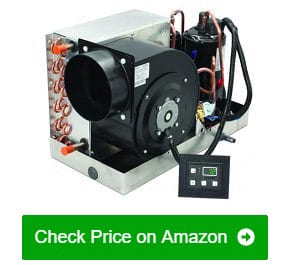
Enjoy your boating seasons with this “EnviroCimfort (ECD) Dometic marine air conditioner that packs plumbing and air movement essentials. This retrofit kit is a handy air filter system for mid-sized boats and marine vessel cabins or enclosures.
The Dometic 12,000 BTU marine air conditioner is a dependable upgrade with innovative design, power, and affordable features. I like how it makes an environmentally friendly retrofit solution with useful plumbing and air movement components. This Dometic model is effective in distributing hot air to cool up my boat including the engine room whole year-round. It also comes with an electric box for easy operations, which I enjoyed using since the day I bought it.
Ensure your boat is cool all season with these self contained units of ECD AC kit. It is accompanied by an R-410A refrigerant for ecologically fit cooling performance you’ll surely like. When you purchase it, you will be given a 6 to 12 months of labor and parts warranty. Moreover, you wi;l appreciate that it is a lot more affordable than retrofitting old BTU H self-contained marine ACs.
- Affordable high-capacity marine AC for the best value of money
- Easy-to-install BTU H self-contained marine air conditioning kit
- Power-saving stellar reverse cycle heating and air filter system for mid-sized sailboats and larger boats
- Effective air distribution for boat enclosures any season of the year
- Environmentally-friendly retrofit kit with plumbing and air movement solutions
- Needs a sound shield for quieter operation
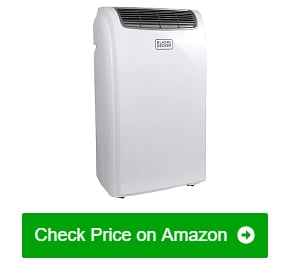
The final product on our list is a white BLACK+DECKER portable air conditioner with remote control. This corded electric-powered AC is a solidly powerful cooling and dehumidifying unit that can work well during emergencies.
It provides an unrivaled air conditioning output g to beat the heat. This versatile cooling unit can serve as a main and backup AC unit for midsize cabins while at sea. It has an optimal cooling output at about 10,000 BTU ASHRAE exhaust system. I love its easy-plug-and-play features: a window adaptor, main power cord, and other useful components for each trip.
I bought two units of these small compact AC systems, which helped me complete a great sailboating escapade. The sudden temperature issues while using them as a cooler and dehumidifier are within control. They can be used alternately as primary and secondary units for over 30 days sailboating period. Their environment-friendly R410A refrigerants and LED control panels made them safer and fully remote-controlled.
- Easy to install and assemble portable AC and dehumidifying system
- Quick remote control access and LED control panel for ease of use
- Affordable boat air handler with strong cooling output that beats the heat
- Best to work as a primary and secondary AC unit for all sizes of enclosures
- Power saving with 24-hour timer, sleep mode, and 3-fan level control
- Its cooling strength causes bothersome noise
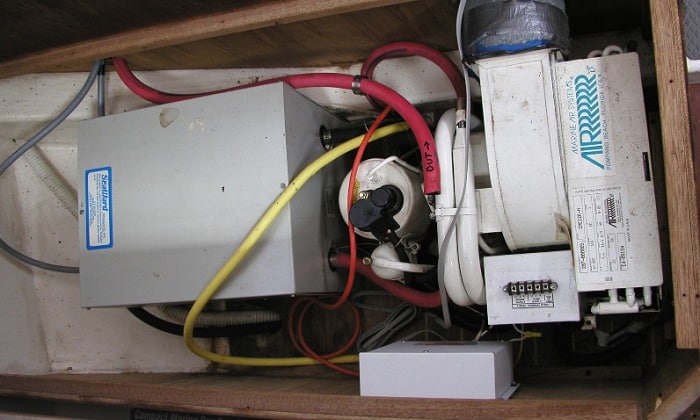
Understanding how the marine air conditioner works needs a basic awareness of the brands available in the market. The brands in these reviews offer the AC types and components you need to operate them in your boat.
All three main types and functionalities for an effective refrigerant system are simplified below for your guide. Remember that they all have AC components comprising of a compressor, condenser, and evaporator to ease your needed air movement.
These components cool the air circulation with the help of a refrigerant flow, push the airflow cooling process, and transfer it to an evaporator component and then to the air handlers.
The distribution process also includes fans and air handlers to get cooled or chilled air into your boat cabin. You need to know these factors to judge affordable brands, heavy-duty types, among other essentials for quality boat air circulation.
What Are the Three Main Types of Boat Air Conditioning Systems
Many variants of air conditioning kits are offered in the market but boat lovers consider only a few of them. Choose among these three high-quality marine air conditioner types based on your boat size and layout:
- Self Contained Direct Expansion Systems or DX Type AC systems are loved by most boaters for their budget efficiency features. What’s more lovable about these boat AC units is that they are easy-to-install, maintain, move, and restore. They usually work for small-sized to mid-sized boat or marine vessels within about 40 feet vessel length. But they produce a bit of.
- Remote Systems or Split Gas Types are widely used in mid-sized and large marine vessels like yachts and sailboats. Split gas AC units feature a centralized condenser connected by a copper wire to a number of air coolers. Aside from being For their quieter and more space-saving perks, however, you will need to shell out a bit more money.
- Tempered Water Systems or Chilled Water Types are your best option when needing versatile boat AC systems. These systems use a refrigerant in cooling the desired areas of your boat enclosure. But you need to customize an adequate housing for its pipes, low pressure gauges, ducting, and air handlers.
Benefits and Drawbacks of a Marine Ac Unit
Go over the advantages and disadvantages to clear any second thoughts about getting your best choice from this series of reviews
- Has hybrid refrigerant system combining cooler, dehumidifier, and heater functions
- Uses environment-friendly refrigerants for chilled water AC systems and low power consumption
- Packs safety, comfort, and versatility that you may not have enjoyed before
- Makes a cooling difference that beats the heat even at the highest temperatures
- Specially designed AC kits to cool or heat specific areas of your boat
- Portable AC units requiring effortless installation, movement, and maintenance
- Power saving AC models with useful components to extend for longer uses
- Fully remote AC system with LED monitors for less space and quieter operations
- Effective single or self contained AC unit that can cool multiple boat enclosures
- Manual or auto-controlled temperature levels for effective airflow and flexible cooling of multiple areas
Disadvantages
- Expensive models like split gas types having special components and systems
- Larger AC systems can create bothersome noise while cooling wider boat areas
- AC units with larger compressors and cooling, and air handlers consume high amounts of energy from a boat’s battery
Use these marine AC benefits and drawbacks to choose the right one for the layout and size of your boat.
General Care and Maintenance Tips
Follow the essential factors in getting the right ones and know how to maintain and care for them effectively. Taking into consideration the ease of installation, AC efficiency, boat layout and size, and quieter operation are some key aspects. Include as well these general tips for proper care and maintenance:
- Safe and Comfort of Use: Any AC system onboard a vessel is aimed towards cooler air for each boat area. Maintain the AC unit to provide desired temperature levels for the safety and comfort of the people aboard the boat. Include in the preventive checks and care servicing the condenser, compressor, evaporator, air filter, air handlers, and cooling components.
- Quality of Material and Boat Equipment: Amidst extremely hot and humid weather, the soundness of your boating emanates from regular maintenance activities. Ensure preventive servicing is done to prevent rust and corrosion from endangering the quality of the boat and equipment.
- Discharge, Ducting, and Wye Provisions: Ensure that there is sufficient space around the unit to do the maintenance servicing. Remove the unit if necessary, especially the split gas types to include visual checks of the surrounding containment.
These maintenance and care factors are within the functionalities of all the AC brands in this series of reviews. Performing these basic care and maintenance servicing will help prevent enery-consumption and smooth operation issues.
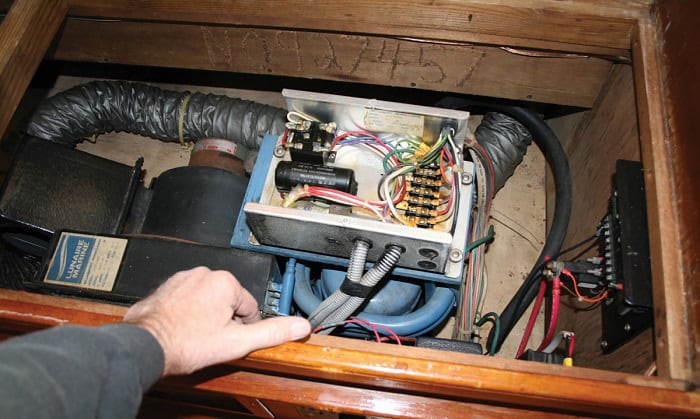
Adding a boat AC onboard may require a generator set aside from the usual battery-powered supply. Ensure around 120-volts/2500-watts AC power to enjoy a 10,000 BTU AC unit, among other electric-powered appliances .
While being docked, a 5,000 BTU AC draws around 5 amperes/1,250 watts with 120-volt power. Generator sets could be an option to supply consistent power to you boat and AC equipment. Inverter-type power sets can also allow you the use electronic equipment, computers, and power tools instead of noisy generators.
These marine AC systems can serve for about 10 to 15 or more years when properly cared for. Various factors affect the life expectancy of a boat air conditioning system. AC models that complete the manufacturer’s recommended repairs, regular checks, and preventive measures can reach about 20 years. Always refer to the manufacturer’s product specifications and care sheet for the appropriate servicing and use.
Do the general maintenance of the boat airconditioning system in a regular and timely manner. Cleaning and declogging dirty air filters ease out the refrigeration system by freeing the airflow passage for the system’s efficiency.
Do the same cleaning of the interior and outdoor AC systems to visually check, clear debris, and rinse condenser coils. Ensure to check the thermostat, clean filters, declog drain lines, and switch-off humidifiers when not in use. Use a small brush, a vacuum, and blowers to dry wet parts before the next operation. Test the drain line by pouring some water for declogging and schedule the next maintenance or tune-up.
The basic tip in sizing your boat air conditioning system is to get the area of the room you need cooling. Get adequate room cooling by multiplying 25 BTU to the total area in square feet. So, for a 200 square feet area dimension, you would need about 5,000 BTU airconditioning systems. Divide the total BTU, say 12,000 by 12,000 to get the 1-ton capability for the new cooling system.
The larger the area to get cooled, the higher capacity and pump connectivity to get on your boat. The use of a pump manifold and pump relay also helps your boat AC unit using a common heat pump.
Ensure to get the needed cooling for the boat room considering various weather conditions and factors mentioned in these reviews. Correctly measure your marine vessel’s AC tonnage to get the heat you need to remove, especially when used for 24 hours.
The essential factors, AC types, and FAQs for the best marine air conditioner units are in these reviews. These top portable air conditioner for boat units and other marine vessels are your premium choices.
Whether a large or a small AC unit for boats or enclosures, they make spaces efficiently cool, providing efficient trips despite fluctuating temperatures or heat levels. Choose from the largest to the smallest boat air conditioner from this unbiased guide. Decide on getting a marine air conditioner 16,000 BTU cooling units or other premium choices that boat owners love.

“My intention from the first day establishing Boating Basics Online is to provide as much help as possible for boaters who want to experience a first safe and convenient trip. So feel free to join us and share your beautiful journeys to the sea!”

Please verify you are a human
Access to this page has been denied because we believe you are using automation tools to browse the website.
This may happen as a result of the following:
- Javascript is disabled or blocked by an extension (ad blockers for example)
- Your browser does not support cookies
Please make sure that Javascript and cookies are enabled on your browser and that you are not blocking them from loading.
Reference ID: f76d3f47-fac3-11ee-9ee0-b144dc0c8296
Powered by PerimeterX , Inc.

Cool Your Boat’s Cabin: AC Options Explored
Boat owners know that hot summer days on the water can be both a blessing and a curse. While it’s fantastic to enjoy the sunshine and warm breezes, the heat can make a boat’s cabin feel like an oven.
This is where having air conditioning on board can make a world of difference.
In this article, we’ll explore the various air conditioning options for boat cabins, diving into the differences between AC (alternating current) and DC (direct current) systems, installation considerations, and the pros and cons of each option.
AC vs. DC: Understanding the Basics
Before we delve into the specific options available, it’s crucial to understand the difference between AC and DC power. Alternating current (AC) is the type of electrical current found in most homes and buildings. It’s called “alternating” because the flow of electricity changes direction periodically. Direct current (DC) , on the other hand, flows in one direction and is commonly found in batteries, including those used in boats.
Most portable air conditioners are designed for use in homes and buildings, so they typically use AC (alternating current) power. However, you may be able to find portable air conditioners (Amazon) designed specifically for boats that run on DC (direct current) power.
In a boat, you can power an AC air conditioner in one of the following ways:
- Shore power: When your boat is docked and connected to shore power, you can plug the air conditioner into an AC outlet onboard, just as you would at home. Your system may require 110v or 220v, depending on what you have installed.
- Inverter: If you’re not connected to shore power, you can use an inverter to convert your boat’s DC power supply (from batteries) into AC power. Make sure your inverter has enough capacity to handle the air conditioner’s power requirements, and ensure your boat’s battery bank and charging system can support the additional load. Take at least a 15% inefficiency factor into account for switching your DC power into AC power via the inverter and any heat loss in the process.
For a DC-powered air conditioner, you can connect it directly to your boat’s DC electrical system, without the need for an inverter. These units are less common and may be more expensive than their AC counterparts, but they can be more energy-efficient, making them an attractive option for boating enthusiasts.
It is essential to ensure your boat’s electrical system can handle the additional load of the air conditioner, regardless of whether it is an AC or DC-powered unit. If you’re not experienced with electrical systems, consult a marine electrician for assistance.

AC-Powered Air Conditioning Systems
AC-powered air conditioning systems are the most common type for boats, particularly when it comes to marine air conditioners. They are designed to run on shore power or can be powered by an onboard generator or inverter. Let’s take a closer look at some of the options within the AC category:
Marine Air Conditioners:
These units are specifically designed for boats and are built to withstand the marine environment. They come in various sizes and capacities and can be installed as a central system or as individual units for different areas of the cabin.
- Designed for marine use
- Wide range of sizes and capacities
- Can be integrated into the boat’s existing electrical system
- Can be expensive
- May require professional installation
- Dependent on shore power, generator, or inverter for operation
Portable Air Conditioners:
These standalone units can be placed anywhere in the cabin and are typically vented through a window or hatch. They are an affordable and flexible option for those looking for a temporary or easily movable solution.
- Easy to install and move
- No permanent modifications to the boat required
- May not be as efficient as marine air conditioners
- Limited cooling capacity
- Venting can be challenging
Window Air Conditioners:
Although not specifically designed for boats, window air conditioners can be adapted for use in a boat cabin. They require a custom installation to ensure proper venting and secure mounting.
- Can be effective at cooling small spaces
- Readily available
- Requires custom installation
- Not designed for marine environments
DC-Powered Air Conditioning Systems
DC-powered air conditioning systems are less common, but they offer some unique advantages, particularly when it comes to energy efficiency. These units are designed to run directly from the boat’s battery bank without the need for an inverter.
DC Marine Air Conditioners:
These systems are specifically designed for boats and run on the boat’s DC power supply. They can be an excellent option for those looking to minimize energy consumption and maximize efficiency. I also recommend checking out DC systems that are often used in the cabins of truckers (Amazon) , as they are designed to deal with vibration better (no copper lines) than systems that are designed for stationary homes.
- Energy-efficient
- No need for an inverter
- Less common and may be more expensive
- Limited options available
Installation Considerations
When selecting an air conditioning system for your boat, there are several factors to consider, including:
- Power requirements: Ensure your boat’s electrical system can handle the additional load of the air conditioner, regardless of whether it is an AC or DC-powered unit. Consider all of the inefficiencies involved.
- Ventilation and condensation: Proper venting is essential for any air conditioning system to function correctly.
- Insulating Ductwork: Portable AC systems will have ductwork to vent out the heat generated by the AC process. Be sure to insulate this ductwork or it will radiate heat back into the room you’re trying to cool.
Additionally, condensation from the unit needs to be properly managed to avoid mold and mildew issues.
- Space constraints: Some air conditioning systems, particularly central marine air conditioners, may require significant space for installation. Be sure to carefully measure the available space in your cabin before purchasing a unit.
- Professional installation: Depending on the complexity of the system, you may need to hire a professional to install your air conditioning unit. This is especially true for central marine air conditioners and custom-installed window units.
Maintenance and Operational Tips
After you have installed your air conditioning system, proper maintenance and operation are crucial to ensure its longevity and efficiency.
- Clean and inspect filters regularly: Dirty or clogged filters can reduce the efficiency of your air conditioning system and may even cause it to break down.
- Check for proper airflow: Ensure that the air vents are not blocked and that there is adequate space around the unit for proper airflow.
- Monitor energy consumption: Be mindful of your boat’s energy usage, particularly if you are relying on battery power or an inverter to run your air conditioning system. You may need to adjust your energy consumption habits, upgrade your boat’s electrical system, or switch battery types altogether to accommodate the additional load.
Final Takeaways
There are various air conditioning options available for boat cabins, each with its pros and cons. By carefully considering your boat’s power requirements, space constraints, and installation needs, you can select the best air conditioning solution for your vessel. Remember to maintain and operate your system properly to keep your cabin cool and comfortable, even on the hottest summer days.
Happy Boating!
Robert Van Nuck
Robert lives in central Michigan and enjoys running, woodworking, fixing up small engines, and getting out on the water with family, of course! He is also the owner and author of homebatterybank.com.
Recent Posts
Glare No More: Selecting the Perfect Boating Sunglasses
Sunglasses are a vital accessory for boaters that provide protection from the sun's harmful rays while enhancing visibility. Boating takes place in an environment where the sun reflects off the...
Aluminum vs. Fiberglass Boats: Which is Better for You?
In the world of boating, there are two materials that dominate the market: aluminum and fiberglass. Both have unique advantages and disadvantages that make them suitable for different types of...
- New Sailboats
- Sailboats 21-30ft
- Sailboats 31-35ft
- Sailboats 36-40ft
- Sailboats Over 40ft
- Sailboats Under 21feet
- used_sailboats
- Apps and Computer Programs
- Communications
- Fishfinders
- Handheld Electronics
- Plotters MFDS Rradar
- Wind, Speed & Depth Instruments
- Anchoring Mooring
- Running Rigging
- Sails Canvas
- Standing Rigging
- Diesel Engines
- Off Grid Energy
- Cleaning Waxing
- DIY Projects
- Repair, Tools & Materials
- Spare Parts
- Tools & Gadgets
- Cabin Comfort
- Ventilation
- Footwear Apparel
- Foul Weather Gear
- Mailport & PS Advisor
- Inside Practical Sailor Blog
- Activate My Web Access
- Reset Password
- Customer Service

- Free Newsletter

Cabo Rico’s Classic Cutter

Bob Perrys Salty Tayana 37-Footer Boat Review

Tartan 30: An Affordable Classic

Ericson 34-2 Finds Sweet Spot

Preparing A Boat to Sail Solo

Solar Panels: Go Rigid If You have the Space…

Leaping Into Lithium

The Importance of Sea State in Weather Planning

When Should We Retire Dyneema Stays and Running Rigging?

Rethinking MOB Prevention

Top-notch Wind Indicators

The Everlasting Multihull Trampoline

Taking Care of Your 12-Volt Lead-Acid Battery Bank

Hassle-free Pumpouts

What Your Boat and the Baltimore Super Container Ship May Have…

Check Your Shorepower System for Hidden Dangers

Waste Not is the Rule. But How Do We Get There?

How to Handle the Head

The Day Sailor’s First-Aid Kit

Choosing and Securing Seat Cushions

Cockpit Drains on Race Boats

Re-sealing the Seams on Waterproof Fabrics

Safer Sailing: Add Leg Loops to Your Harness

Waxing and Polishing Your Boat

Reducing Engine Room Noise

Tricks and Tips to Forming Do-it-yourself Rigging Terminals

Marine Toilet Maintenance Tips

Learning to Live with Plastic Boat Bits
- Systems & Propulsion
Air Conditioning at Anchor
Is it even possible without a generator.
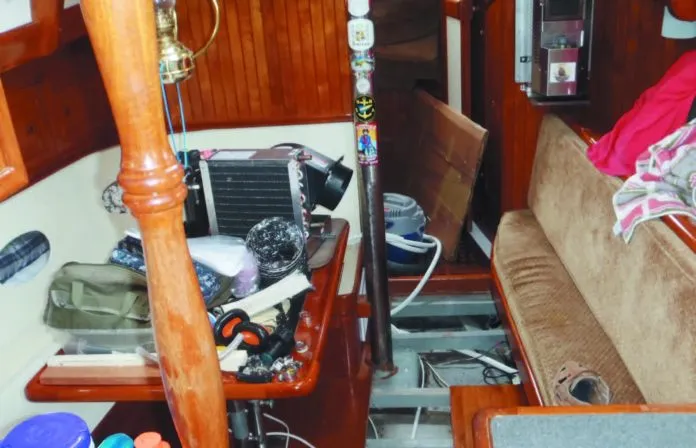
We often get this question. My car has air conditioning when I’m running down the street so why can’t my boat? First, your car only has air conditioning when the engine is running, which works out fine because we only need air conditioning when the engine is running. Second, the air-conditioning load for the car is a tiny parasitic load compared to the power required to drive the car down the road. It’s actually less than the increased drag caused by driving with the windows rolled down. Thus, it is more or less an engineering after-thought with regards to the energy balance of an automobile.
A boat, on the other hand, unless tied to a dock or running a generator, has only the sun and wind to provide energy, and the area to be cooled is larger. But there are 12-volt air conditioners available that I can run right off the battery. Can I just install bigger batteries and a few more solar panels? Well, yes and no. Air conditioning certainly can run off batteries and solar panels and wind generators, but practicality comes down to the energy balance; how much energy are we generating, how much are we consuming, and how do we store enough to last through the night?
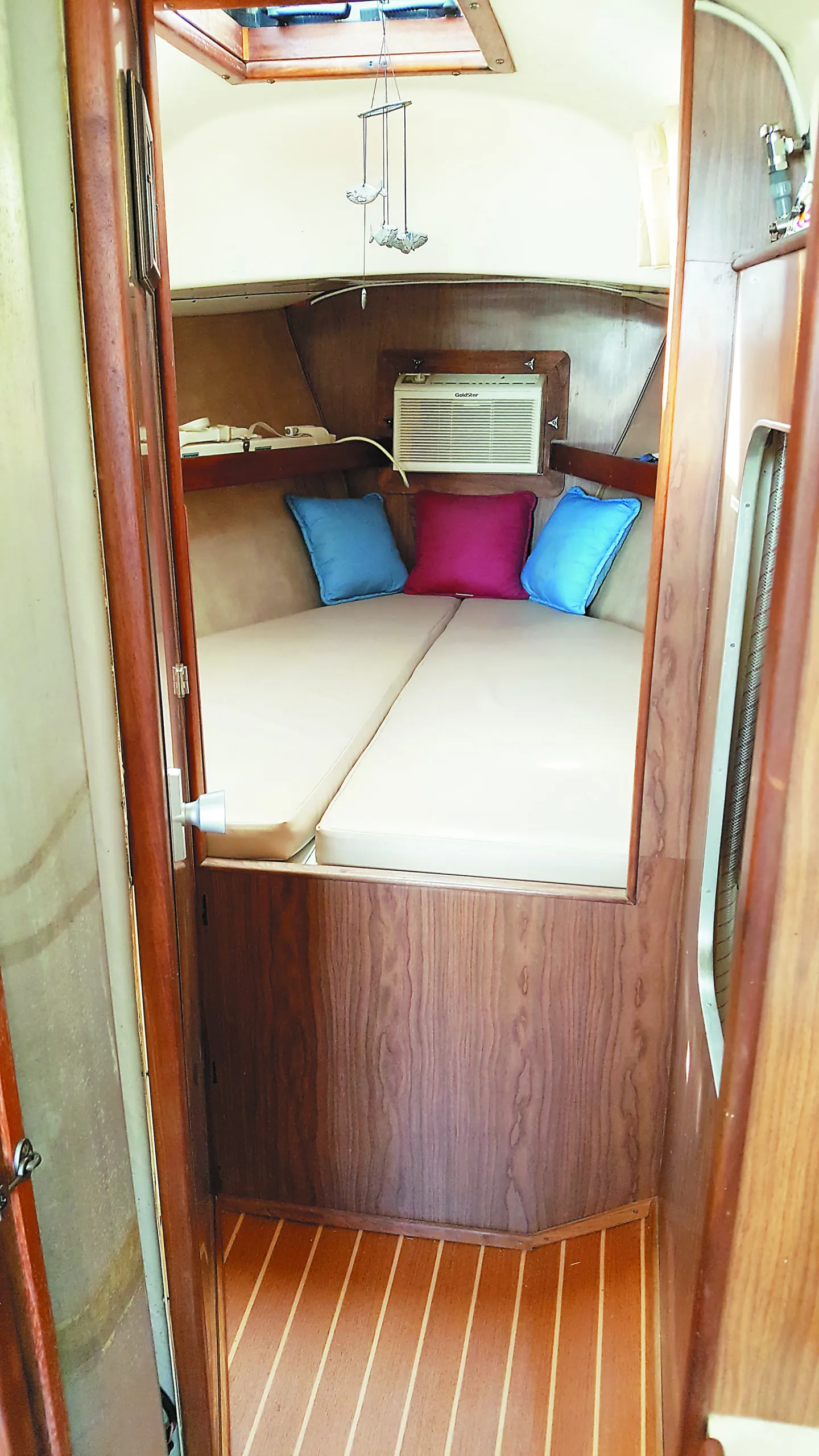
Run Schedule
Are you planning to run air-conditioning all day, or only at night so you can sleep more comfortably? The reduction of relative humidity that is so important to human comfort is best achieved from an A/C system that is operating almost continuously. In some circumstances, it may be desirable to provide the required cooling with two separate air conditioning systems, one providing two-thirds of the total capacity. This approach permits operation of one system at times when the exterior temperature does not require the total installed cooling capacity. Of course, air-conditioning all-day is a pipe dream for most sailboats without the addition of a generator.
If you need air-conditioning all day, while out on the water and away from the dock, perhaps sailing isn’t for you. There should be at least some breeze, and what’s the point of being on the water if you aren’t outdoors? Thus, our operating assumption is that you need only air-conditioning for sleeping, about 12 hours through the evening and night.
The Power Draw
In our previous report, Air Conditioning for Sailboats , Practical Sailor June 2018, we discussed the installation of a 12,000 BTU (British thermal units) air conditioner on a cruising catamaran. We will begin our discussion of off-the-grid air conditioning with this example. The unit consumes about 800 watts when operating (12 volts vs. 120 volts actually makes rather little difference-we will come back to this later).
When the outside temperature is 90F, the unit runs an 80- to 100-percent duty cycle through the afternoon until the sun gets low, declining to a 30- to 40-percent duty cycle until dawn, which is a good time to get up. The average afternoon duty cycle is about 60-percent. The overnight draw on the batteries will be about 480 amp hours (Ah).
Neglecting any charging input during the night, lead-acid batteries need to have at least three times that rated capacity in order to avoid a shortened life expectancy due to excessive discharge. Additionally, the discharge will be at a relatively high rate, further reducing battery capacity. That means the battery bank of at least 1440 Ah, or about 12 group 27 lead-acid batteries would be needed just for the air-conditioning load. In the case of our test boat, that would have added 10 percent to the displacement, assuming we could find the space.
Readers have pointed out that this was a rather small air conditioner for this boat. In fact, that was intentional, as we wanted to minimize power consumption so that we could run on 15-amp shore circuits and run on batteries for a short time. Well come back to this decision and how it worked.
12 volts versus 120 volts
Intuitively, air conditioning powered by 12-volt DC system should be more efficient than one plugged into 120-volt AC. In fact, the difference in efficiency between 12 volts and 120 volts is quite small.
A few formulas and rough conversion factors can explain this. Battery capacity varies with temperature and rate of draw down. Voltage varies with the battery state of charge and rate of draw down. Charge controller and inverter efficiency come into play, but these effects are relatively small so we can ignore them for discussion purposes.
Our focus is simplicity. In practice, you can add 30 percent or more battery and charging capacity to make up for approximations, battery aging, and inefficiencies in charging.
Watts (W) = volts (V) x amps (A). AC voltage is about 10 times the DC voltage, but there is about a 5- to 7-percent loss in the inverter. As an approximation, assume the 12V DC draw will be 11 times the advertised 120V AC draw.
Amp-hours (Ah) at 12 volts is related to watt-hours (power required to run the device for an hour) by the formula Ah = Watt-hours/12. So an air conditioner rated at 1000 watt draw will draw about 90 Ah from the batteries when running full time for one hour. It will typically run full time for during the day and for 1-2 hours at night.
For comparison, a solar panel rated at 100 watts will typically produce 100W/12V = 9A during the peak hours. Unfortunately, because of clouds, sun angle, and shading, 5-6 hours should be used in the calculation, even though the days are longer than that.
Here are two examples for comparing energy use at 12V and 120V:
Comfort Cool 6000 BTU, 45 amps at 12V, 540 watts, $3,695
Dometic Turbo 6000 BTU, 4.6 amps at 120V, 528 watts, $1,250
The 120V unit is slightly more efficient, the result of running on higher voltage and more refined engineering. As for the big price difference, the 120-volt units much larger market certainly plays a role.
But what about the power losses, converting battery power to 120V AC? Inverter efficiency ranges from 93 to 97 percent, depending on the unit and the load factor. There is an additional 15 to 25 percent loss in charging hysteresis (the charging voltage is slightly higher than the discharge voltage, even when the amps are same, and some amps are wasted) and wiring resistance. The end result is that a 12-volt unit is about 10 percent more efficient at anchor and the 120-volt AC unit is about 6 percent more efficient at the dock or when powered by a 120-volt AC generator.
As an added bonus, 120-volt units are also more available, considerably less expensive, and more readily serviced.
In fact, the 1500-watt inverter on our test boat allowed us to run our 12,000 BTU air conditioner for several hours off just three group 27 batteries, without deep discharge, as long as the boat was already cooled down. Not practical for overnight cooling, but darn handy for getting out of a steamy marina. However, the validity of the power system and the concept is proven.
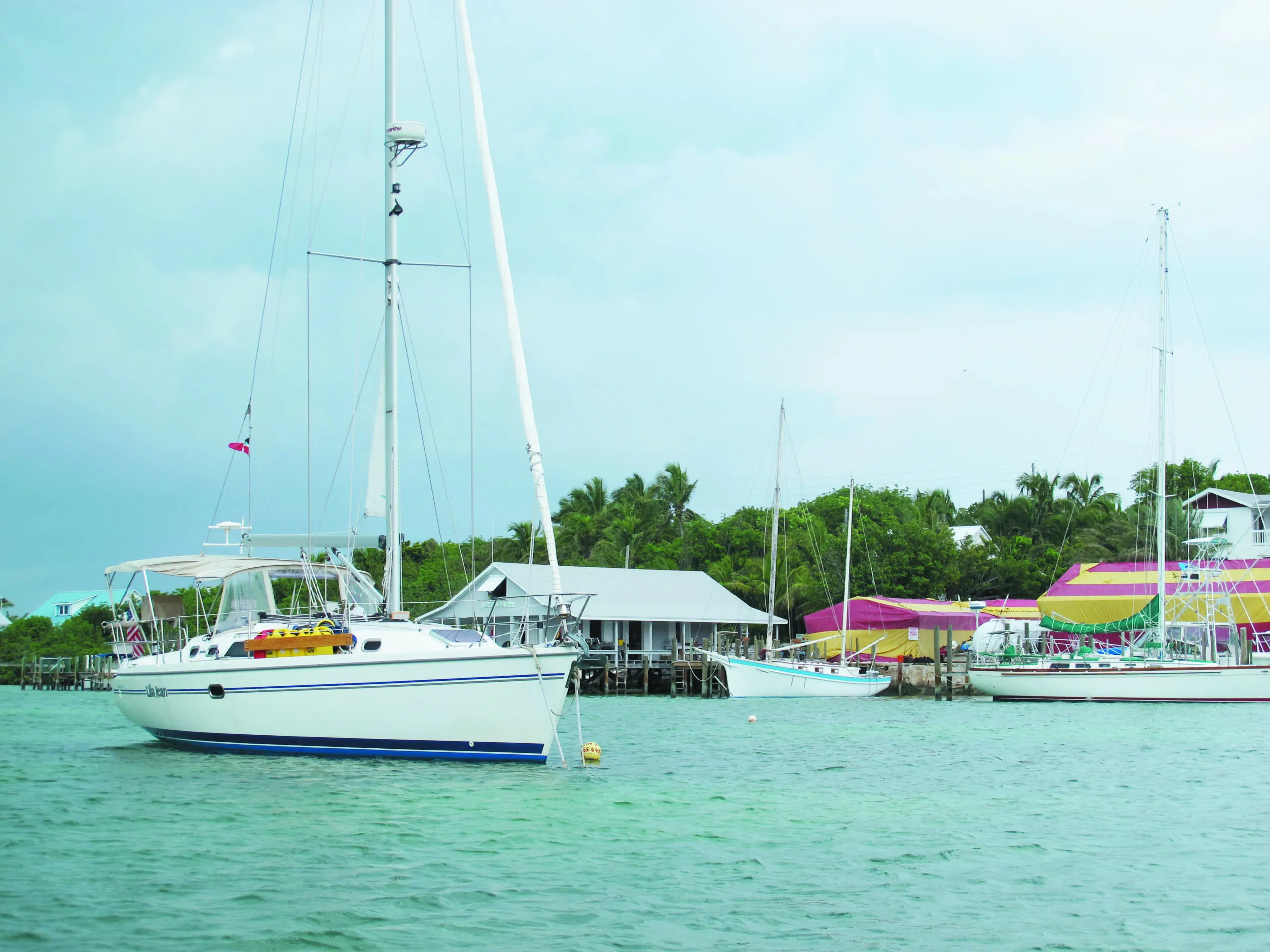
Renewable Energy
What about the practicality of generating the required power from solar and wind? The test boat had 200 watts of solar panels on the hard top, which we felt was just enough to handle typical cruising loads, including lighting, galley loads, the occasional movie, and allowing for the occasional cloudy day. Assuming were using A/C only at night, we need to push an additional 480 Ah electricity into the batteries.
If we rely on solar, allowing for clouds and sun angle, and shading, conventional wisdom is to use only 5 hours of rated capacity, and so we need an additional 1200 watts of panels, or an additional 125 square feet of panels. Including existing panels, that’s a 10-by-20 foot area on a 34-foot boat assuming zero gaps. It is possible, with considerable inconvenience, on a multihull.
On the test boat, a PDQ 32 catamaran, every inch of the hard top, most of the deck, and a new arch would be required. Access would be impaired and weight and windage would increase. Achieving that much solar capacity is almost impossible on a monohull. If a larger air conditioner is required, there simply isn’t enough square footage on any boat.
What about wind generators? As we found in our wind-generator test, where and when you cruise can have significant impact on wind generation (see Marine Generator Test, July 2007). Some manufacturers quote some big numbers for output. The most we saw in a single day during our test on the Chesapeake was 115 Ah, and the highest 4-day average was 64 Ah.
Also, if you have a good solid 20-knot breeze at anchor, why are you running AC? In reality, if you need air conditioning there probably isn’t enough wind to provide the needed power. Still, if you want to be optimistic, mount a wind generator and figure on 100 amp-hours (Ah) per day. A wind generator can helps meet the energy requirements but is hardly a solution.
A 12,000-BTU unit is a rather small air conditioner for a 32-foot catamaran. This choice was intentional. We wanted to be able to run on 15-amp circuits and to be able to run for a time on batteries. It works because the boat is well insulated, with 1-inches of foam in the cabin roof and -inch in most other areas. The windows are all double glazed and all are fitted with covers to reflect the sun. An awning provides additional cooling for the cabin top.
If we had wanted to cool only the sleeping cabins at night, we would have installed twin 6000-BTU units; one for the salon and galley areas, and one for the aft cabins. This would have dropped our night consumption by 44 percent (not 50 percent, because large units are more efficient). If we had given up early evening cooling, focusing only on sleeping, the overnight load would have dropped to 250 Ah. This would still require a lot of batteries and panels, but not as many as the single unit approach.
A partial solution is switching to lithium iron phosphate batteries (LiP), which allow faster charging, deeper cycling, and reduced weight (see Jumping in on the Lithium Ion Wave, PS May 2011). The down sides are very considerable expense (far more than the air conditioning unit will cost) and the need for more precise control of the charging process.
Diesel Generators
Any discussion of on-the-hook air conditioning must discuss generators. This could be a small diesel generator or even a portable generator located in a safe place on deck. (The units exhaust must be located down-wind because carbon monoxide is a major concern.)
A high capacity engine alternator could also help replenish lost amps, but do you really run the engine that much? Over the long haul, this type of low-load use can harm the engine.
Hybrid Systems
Hybrid diesel-electric propulsion systems require high capacity energy storage and a powerful generator. This same equipment used to power the drive system can be used to power an air conditioner. Initially embraced by Leopard catamarans and others in the Caribbean charter trade, the systems were extremely popular a few years ago.
However, more recently owners have begun retrofitting conventional diesel engine propulsion systems. Hybrid power works where there are loads surge (buses and passenger cars) or where control is complex (maneuvering systems, such as tugs and cruise ships), but the steady load of a yacht in transit is more efficiently managed by a direct drive diesel engine.
Conclusions
Is it possible to run air-conditioning from renewable energy sources? With enough insulation, a smallish AC unit, the right batteries, and plentiful charging sources, it can be done. In our research we ran across several cruisers who are doing just that. They mounted lots of panels, increased insulation, installed small AC units, and powered them with lithium batteries.
We also learned that they didn’t actually use the AC much, since it required diligent management of battery charging and generally there was a breeze. Feelings seemed to be mixed on whether it was worth the expense, although they certainly like the having lots of power!
We like the idea of designing the power system so that the AC can run off the inverter for short periods to smooth transitions between power sources and while leaving the marina. But the bottom line is that monohulls don’t have enough deck area and even multihulls become overcrowded with panels.
When you are at the dock-and marinas can be unpleasantly windless-simply plug in and run off 120V AC. When at anchor, seek a cooling breeze when hot stifling conditions are expected. Wind scoops help, fans are mandatory, and swimming is fun.
It kind of makes sense that panels and machinery can’t be more efficient at taking the heat away than the sun is at delivering it.
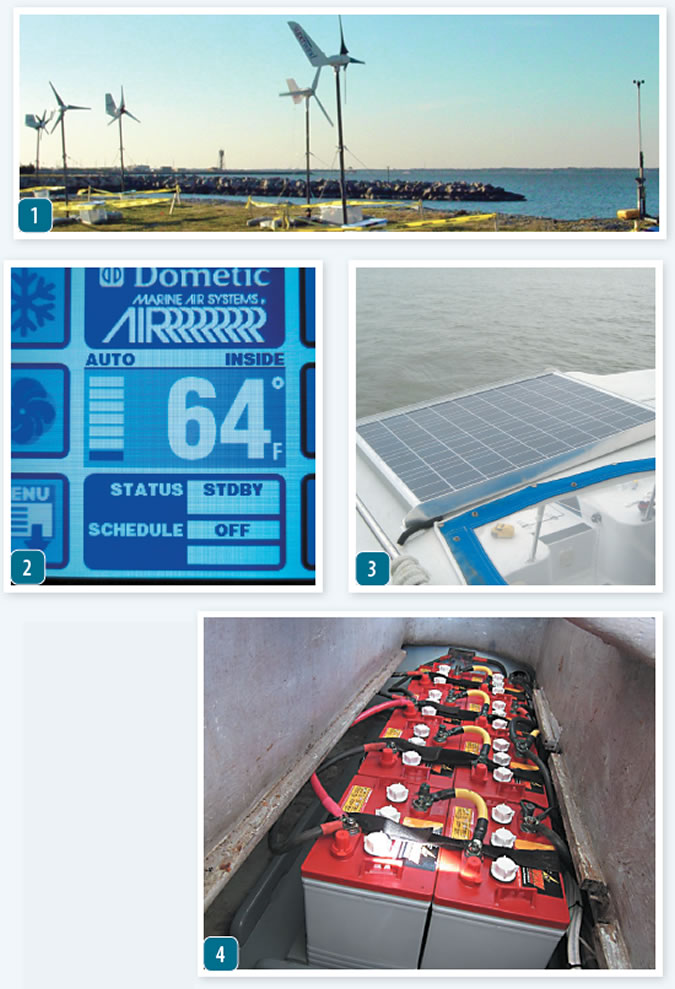
Generating and then banking enough power to keep your air conditioner running on 12-volt power through the night requires significant investment in equipment. Generating onboard power, storing energy, and maintaining maximum efficiency are all critical factors to consider if you expect to build a system that works. It is easy to underestimate the expense.
- The results of our long-term, head-to-head wind generator test revealed a significant range of output based on wind speed (see Practical Sailor, July 2007).
- You can obtain modest gains in efficiency through a “smart” air conditioner thermostat.
- Like wind generators, solar panel output can vary widely based on meteorological patterns in your area. Most monohulls do not have enough space for the panels needed to produce the required energy with a solar energy alone.
- We estimated that our catamaran would need a dozen Group 27 lead-acid type batteries just to handle our modest requirements for 12V air conditioning. The system here relies on several six-volt golf-cart batteries to maximize capacity at a relatively low cost. Each pair is wired in series to yield 12 volts.
- Calculating the Right Air Conditioner Size
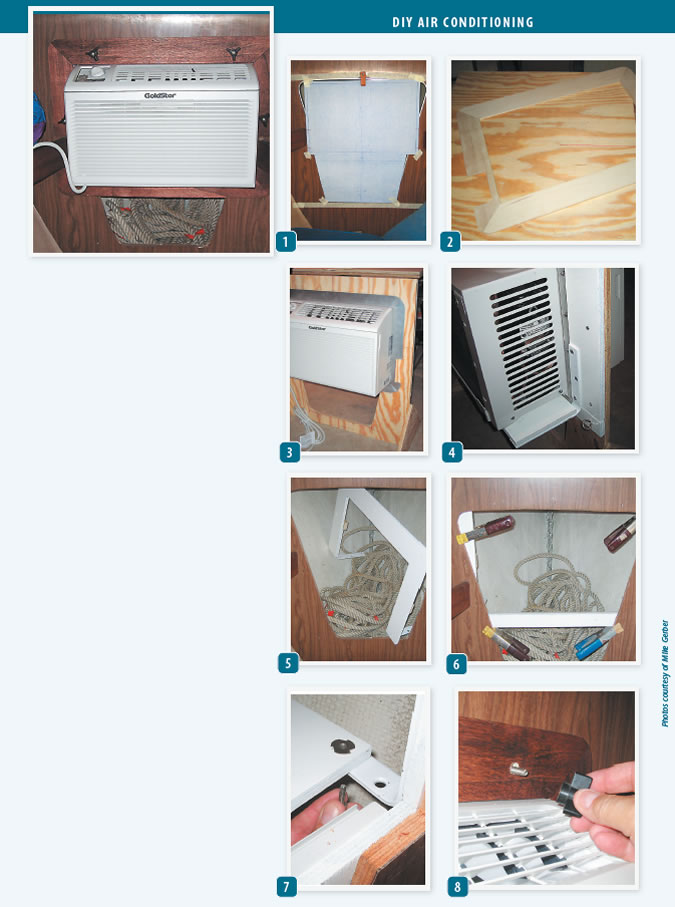
Mike Gerber’s 1970 Morgan 33’s vented and drained anchor locker is home to a 5,000 BTU AC window unit that cost about $100. The unit can be accept shorepower or run on a 1000 watt generator – some units may require a “soft start” device to reduce the peak surge when the compressor first kicks in.
- A template verifies space required for the AC unit, while allowing access to the locker.
- The template for the aluminum front plate has a cutout on each side for screwing in the angle brackets,
- Gerber created a plywood model of the anchor locker to check fitting.
- A backside view reveals the angle brackets and supporting shelf.
- The painted plywood frame and brackets is clamped and checked for fit.
- The plywood frame is secured for fastening.
- The mounting shelf and frame is fitted with threaded inserts are used to fix the mounting bolts (photo 9) and shelf in place.
- Thumb screw secure the air conditioner to the mounting bolts for easy removal.
RELATED ARTICLES MORE FROM AUTHOR

DIY survey of boat solar and wind turbine systems
That’s a great story. Thanks for writing it. It has really helped me understand my AC problems.
Informative article! Thanks!
I would point out, regarding the car running intro connect, that an EV can provide ac or heat while not running. Useful for pets or while waiting for a ferry. Tesla has “dog mode”.
the most important factor your article ignores is insulation. This has significant effect on comfort during cold as well as hot spells. Knowing your R values would mean you can install a very realistic AC option to maintain a comfortable temperature in the sleeping berths, without the load on electrical equipment you describe.
To suggest running an AC via an inverter illustrates your total lack of knowledge regarding efficient use of power in Marine applications I would suggest readers make their own research and disregard this article
I have found that a good windscoop is a great alternative to air conditioning. You need to be cooled at night, and the windscoop works very well in that situation.
I am almost finished rebuilding a 35′ Pearson CB yacht into a cutter rigged, shoal-draft pocket cruiser w/10 batteries (4 banks), bow thruster/stern thruster, 16,000 BTU A/C, Forward looking (bottom-terrain mapping) sonar, 7000 watt inverter, multiple hydrogenerators, hard-top solar, and (expect) a diesel gen set. It’s a prototype disabled sailing yacht, inclusive of 1 micron filtered water, salt/FW deck wash down systems, Freshwater flushing of all salt water systems, multiple freezers/refrigerator systems w/dry foods vacuum storage system, a rolltop desk, an ice maker, a wet bar, ship’s safe, 2 galley sinks, IT network w/printer-scanner, a deck shower, a piano w/a 15 function stand-up shower (also hydro-generated light/temp/time of shower indicators) and. cedar lined storage. The entirety of the yacht is controlled via B&G Zeus 3 navionics w/a soft-start A/C to run off the inverter. Production yachts are built to waste space, to add ‘flat’ beds (e.g. My Pearson 35 was designed to sleep 6. That meant the 2 in the V-berth were trapped until at least 1 other woke up…I removed 2 bunks and 2 water tanks and added storage. She now has 105 gallons FW, w/an additional FW toilet flushing tank of 20-30 gallons). She carries 1/2 dozen pumps, 2 diesel tanks of about 100 gallons (estimated 1200 range/no Gerry cans on rails). There are no inaccessible, unusable voids. The (former) void beneath the stand-up shower now is a lighted stowage compartment holding some 30 boat cleaning products. Travel luggage to jet from the yacht and back is being built into the stowage compartments for the owner to be able to fly-out from destinations. Water catch systems in then radar arch resupply rainwater limiting water maker hours. An aqua generator attached to the stern wind vane can generate up to 16 amps under sail. Space and power are at a premium on a sailboat. If you build it as a “system of systems”, a 35′ yacht can have all this, be wayyyy cool, and be handled by the disabled. I know this because I’m a severely disabled veteran (age 61). Oh, you do have to repaint then waterline. Questions?
Time for you to write a long and detailed article, especially with regard to your generating of power. If you’d care to have support or help or just write personally, I’m very interested and am at [email protected] . Thanks, Will
You first Mikie… I know nothing about these products but they may be a good option….”6 Reliable Electric Cooling Blanket Options To Get A Perfect Night Sleep”. I tried a wind scoop on my Pearson Invicta. It was almost worthless. Then I switched to a Lightning spinnaker. Now that was cool. It took a little effort to get it balanced, but then we were pulling up the blankets. And, this was on the Chesapeake in the summer as liveaboatds. Good luck. Volumn and speed of the air are what will keep you cool. Also, those naked trips to pull it down in a thunderstorm are coooool.
Installation for a portable boat AC, a 12 volt boat air conditioner, or a marine air conditioner 16,000 BTU varies. They’ll likely need specific wiring, plumbing, ducting, and location aspects that may be handy, mild, or complex to install.
LEAVE A REPLY Cancel reply
Log in to leave a comment
Latest Videos

Bottom Paint Showdown – Six Paints, One Winner!

Tartan 30 | Boat Review

Fuel Contamination? The Baltimore Francis Key Bridge Collapse

Safety At Sea For You & Your Family – The Joe...
- Privacy Policy
- Do Not Sell My Personal Information
- Online Account Activation
- Privacy Manager
- Bahasa Indonesia
- Slovenščina
- Science & Tech
- Russian Kitchen
Cruising the Moskva River: A short guide to boat trips in Russia’s capital

There’s hardly a better way to absorb Moscow’s atmosphere than on a ship sailing up and down the Moskva River. While complicated ticketing, loud music and chilling winds might dampen the anticipated fun, this checklist will help you to enjoy the scenic views and not fall into common tourist traps.
How to find the right boat?
There are plenty of boats and selecting the right one might be challenging. The size of the boat should be your main criteria.
Plenty of small boats cruise the Moskva River, and the most vivid one is this yellow Lay’s-branded boat. Everyone who has ever visited Moscow probably has seen it.

This option might leave a passenger disembarking partially deaf as the merciless Russian pop music blasts onboard. A free spirit, however, will find partying on such a vessel to be an unforgettable and authentic experience that’s almost a metaphor for life in modern Russia: too loud, and sometimes too welcoming. Tickets start at $13 (800 rubles) per person.
Bigger boats offer smoother sailing and tend to attract foreign visitors because of their distinct Soviet aura. Indeed, many of the older vessels must have seen better days. They are still afloat, however, and getting aboard is a unique ‘cultural’ experience. Sometimes the crew might offer lunch or dinner to passengers, but this option must be purchased with the ticket. Here is one such option offering dinner for $24 (1,490 rubles).

If you want to travel in style, consider Flotilla Radisson. These large, modern vessels are quite posh, with a cozy restaurant and an attentive crew at your service. Even though the selection of wines and food is modest, these vessels are still much better than other boats.

Surprisingly, the luxurious boats are priced rather modestly, and a single ticket goes for $17-$32 (1,100-2,000 rubles); also expect a reasonable restaurant bill on top.
How to buy tickets?
Women holding photos of ships promise huge discounts to “the young and beautiful,” and give personal invitations for river tours. They sound and look nice, but there’s a small catch: their ticket prices are usually more than those purchased online.
“We bought tickets from street hawkers for 900 rubles each, only to later discover that the other passengers bought their tickets twice as cheap!” wrote (in Russian) a disappointed Rostislav on a travel company website.
Nevertheless, buying from street hawkers has one considerable advantage: they personally escort you to the vessel so that you don’t waste time looking for the boat on your own.

Prices start at $13 (800 rubles) for one ride, and for an additional $6.5 (400 rubles) you can purchase an unlimited number of tours on the same boat on any given day.
Flotilla Radisson has official ticket offices at Gorky Park and Hotel Ukraine, but they’re often sold out.
Buying online is an option that might save some cash. Websites such as this offer considerable discounts for tickets sold online. On a busy Friday night an online purchase might be the only chance to get a ticket on a Flotilla Radisson boat.
This website (in Russian) offers multiple options for short river cruises in and around the city center, including offbeat options such as ‘disco cruises’ and ‘children cruises.’ This other website sells tickets online, but doesn’t have an English version. The interface is intuitive, however.
Buying tickets online has its bad points, however. The most common is confusing which pier you should go to and missing your river tour.

“I once bought tickets online to save with the discount that the website offered,” said Igor Shvarkin from Moscow. “The pier was initially marked as ‘Park Kultury,’ but when I arrived it wasn’t easy to find my boat because there were too many there. My guests had to walk a considerable distance before I finally found the vessel that accepted my tickets purchased online,” said the man.
There are two main boarding piers in the city center: Hotel Ukraine and Park Kultury . Always take note of your particular berth when buying tickets online.
Where to sit onboard?
Even on a warm day, the headwind might be chilly for passengers on deck. Make sure you have warm clothes, or that the crew has blankets ready upon request.
The glass-encased hold makes the tour much more comfortable, but not at the expense of having an enjoyable experience.

Getting off the boat requires preparation as well. Ideally, you should be able to disembark on any pier along the way. In reality, passengers never know where the boat’s captain will make the next stop. Street hawkers often tell passengers in advance where they’ll be able to disembark. If you buy tickets online then you’ll have to research it yourself.
There’s a chance that the captain won’t make any stops at all and will take you back to where the tour began, which is the case with Flotilla Radisson. The safest option is to automatically expect that you’ll return to the pier where you started.
If using any of Russia Beyond's content, partly or in full, always provide an active hyperlink to the original material.
to our newsletter!
Get the week's best stories straight to your inbox
- What to do in Moscow City, if you’re not mega-rich
- Moscow after dusk: 10 places to drink, dance, and groove
- 5 things you must do in Moscow in 2018 between football matches (or without them)
- Sandwiched between Moscow and St. Petersburg: How to spend a perfect weekend in Tver
- 24 or 48 hours in Moscow: Where to go and what to do in 2019
This website uses cookies. Click here to find out more.
Flotilla Radisson Royal
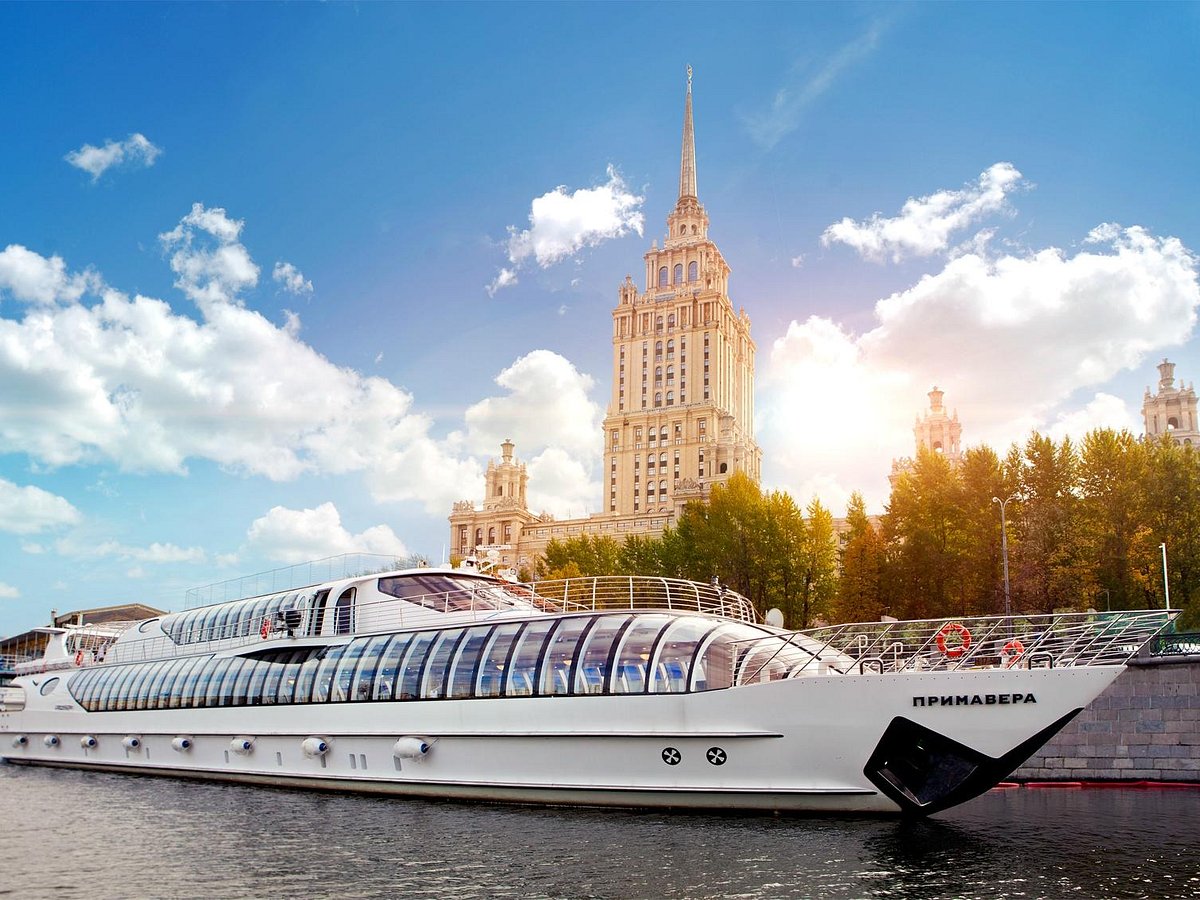
- See all photos

Most Recent: Reviews ordered by most recent publish date in descending order.
Detailed Reviews: Reviews ordered by recency and descriptiveness of user-identified themes such as wait time, length of visit, general tips, and location information.
Flotilla Radisson Royal - All You Need to Know BEFORE You Go (2024)

IMAGES
VIDEO
COMMENTS
MarinAire 14000 BTU/H Self-Contained Marine Air Conditioner. MarinAire is a revolutionary manufacturer in the AC industry and is credited with bringing to the fore the self-contained marine air conditioner. This model is widely popular among boat owners thanks to its practicality, innovativeness, and affordability.
Nearly all marine air-conditioning problems can be partly traced to poor installation. A key step is to create a schematic that maps out the wiring, plumbing, ducts, and vents. ... In order to meet the American Boat and Yacht Standards for through hulls, the seacock needs to be able to withstand 500 pounds of static force for 30 seconds. This ...
The best marine air conditioner could be argued for brands such as Webasto, MarinAire, Dometic, and Campelify. The best marine air conditioning systems all rely on factors for the size of the boat, how easy it is to install, and the budget in order to be considered the best. Drawing from personal experience, the best marine air conditioner is ...
Batteries are at 67.6% (-388 AMP Hours Down) 12 PM - Turn A/C off. Outside it's partly sunny and 83°. Batteries are at 50.7% (-589 AMP Hours Down) After 3 hours of running the A/C, we were down -201 AMP Hours. Important to note - We were not running the A/C hard and it was cycling on and off.
1. Self-Contained Units. Self contained marine air conditioners like the Webasto and Marinaire place the condenser and blower in a single package. Most marine air conditioners rely on seawater to cool the returning refrigerant. These units are very efficient, quiet, and compact, which is perfect for a boat.
BTUs: 16,000. Weight: 66 pounds. Type: Self-contained, water-cooled. The MSBA AC unit by MarinAire is a self-contained and water-cooled boat air conditioning unit. It's fairly easy to install and hook up, so it's ideal for anyone thinking of installing their boat air conditioner DIY.
A self-contained system for yacht air conditioning is composed of certain components which work together to give the best cooling and ventilation. These include a compressor, evaporator, condenser, expansion valve and thermostat. Let's take a look at the table to understand how this system works: Component. Function.
The BoatRX crew with Phil Gutowski second from the right. Phil Gutowski and his company, BoatRX have carved out quite a niche designing and installing high-efficiency air conditioning systems in boats of all shapes and sizes. Phil was kind enough to write a primer on DC air conditioning for Panbo several years ago that captured the attention of many regular Panbo readers.
Some Small Boat Alternatives Portable, air-cooled marine A/C systems are on occasion the only practical means for air-conditioning the smallest boats. Portables are designed to be used when the boat is at a dock where 120V AC power is available. The most familiar portable A/C unit is the 5,000 Btu/hour Cruisair Carry-On.
Things to Consider when Buying a Marine Air Conditioner. Avoid models with a single-hose: They draw cooling air only from the inside, thus they exhaust hot air out through a duct. The air within the boat is usually warmer and more humid than the outside air. Therefore, this can reduce cooling efficiency by as much as 50 percent.
When Denison yacht broker Jeff Erdmann heard about an Oceanis 30.1 with a DC powered air conditioner, he had to see it for himself. He brought a camera, a thermometer, and his passion for boats with him to inspect a 1200 BTU 12-volt air conditioner installed onto a 30-foot sailboat. "The first time I saw the install, I told Brian that this ...
Our air conditioning systems for sailing yachts are completely custom-built in order to meet the client's desires and technical requirements. Taking into account the proposed area of operation, yacht layout, desired target temperatures, number of occupants, construction materials etc. we design a system that exactly fits your needs. ...
Shop marine air conditioners for your boat or yacht from Webasto, Mermaid Air, CTM Marine, Flagship. Self-contained, split gas & chiller marine air conditioning systems. Contact us: 1-800-766-5256
4. Dometic 207500310 EnviroComfort Retrofit. Enjoy your boating seasons with this "EnviroCimfort (ECD) Dometic marine air conditioner that packs plumbing and air movement essentials. This retrofit kit is a handy air filter system for mid-sized boats and marine vessel cabins or enclosures.
Capacity is important for marine Different air conditioners have different cooling capacities. You need to measure the size of the room where your AC is going and match it against the air conditioner's capacity. Our air conditioners deliver 4,000 to 72,000 BTU of cooling power per hour and are 27 percent more energy efficient than similar ...
GPSMAP® 1243xsv Multifunction Display with US and Canada Navionics+ Charts. $2999.99. Compare. Load More. 1 - 20 of 52935 Items. Shop boat air conditioners at West Marine including fixed mount AC units, installation kits, filters, pumps and more. Get free shipping to home or in-store!
AC-Powered Air Conditioning Systems. AC-powered air conditioning systems are the most common type for boats, particularly when it comes to marine air conditioners. They are designed to run on shore power or can be powered by an onboard generator or inverter. Let's take a closer look at some of the options within the AC category:
Installation for a portable boat AC, a 12 volt boat air conditioner, or a marine air conditioner 16,000 BTU varies. They'll likely need specific wiring, plumbing, ducting, and location aspects that may be handy, mild, or complex to install.
Learn everything you need to know about boat air conditioner, from its operation to how to choose the right one for you. Contact Us Today: 786-621-3010 / +1 844 262 8284 | Whatsapp 305-499-0036 ... and more. Whether you're in need of marine air conditioners, watermakers, generators, or any other essential items, we've got you covered. With ...
Explore the scenic and historic attractions of Moscow from the water with the best boat tours and cruises. Enjoy the views of the Kremlin, the Cathedral of Christ the Savior, and the Sparrow Hills on a relaxing or informative boat ride. Or, spice up your trip with some water sports and activities in Moscow. Find out more on Tripadvisor.
Buy tickets. River Cruise aboard a River Palace Yacht from City-Expocentre (International Exhibition) HIT SALES. Daily, from April 25, 2024. Departure from the berth City-Expocentre (m. Vystavochnaya), mooring place "A". Cruise duration 3 hours. We invite you on a river cruise aboard a premium class panoramic yacht starting from the main Moscow ...
Even though the selection of wines and food is modest, these vessels are still much better than other boats. Sergey Kovalev/Global Look Press. Surprisingly, the luxurious boats are priced rather ...
Flotilla "Radisson Royal" has 10 perfectly equipped yachts designed for year-round entertaining excursion cruises on the Moscow River with restaurant service aboard. Our company organizes cruises 365 days a year. Flotilla "Radisson Royal, Moscow" combines picturesque views of Moscow sights with excellent catering service.